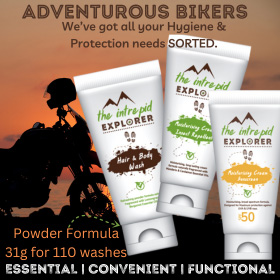 27Likes 27Likes
 |

26 Nov 2014
|
|
Registered Users
HUBB regular
|
|
Join Date: Dec 2009
Location: The Netherlands
Posts: 66
|
|
|
Goodbye (for now) North Africa
With a visa for Ethiopia in our pocket we leave Khartoum and head for the border. It is about 600km to the border town of Metema. South of Khartoum there are no places of interest that we want to visit, so we plan to ride two full days. If we then camp just before the Ethiopian border on the second day, we can arrive there early to complete all the formalities and still have sufficient time to ride to the first campsite in Ethiopia.
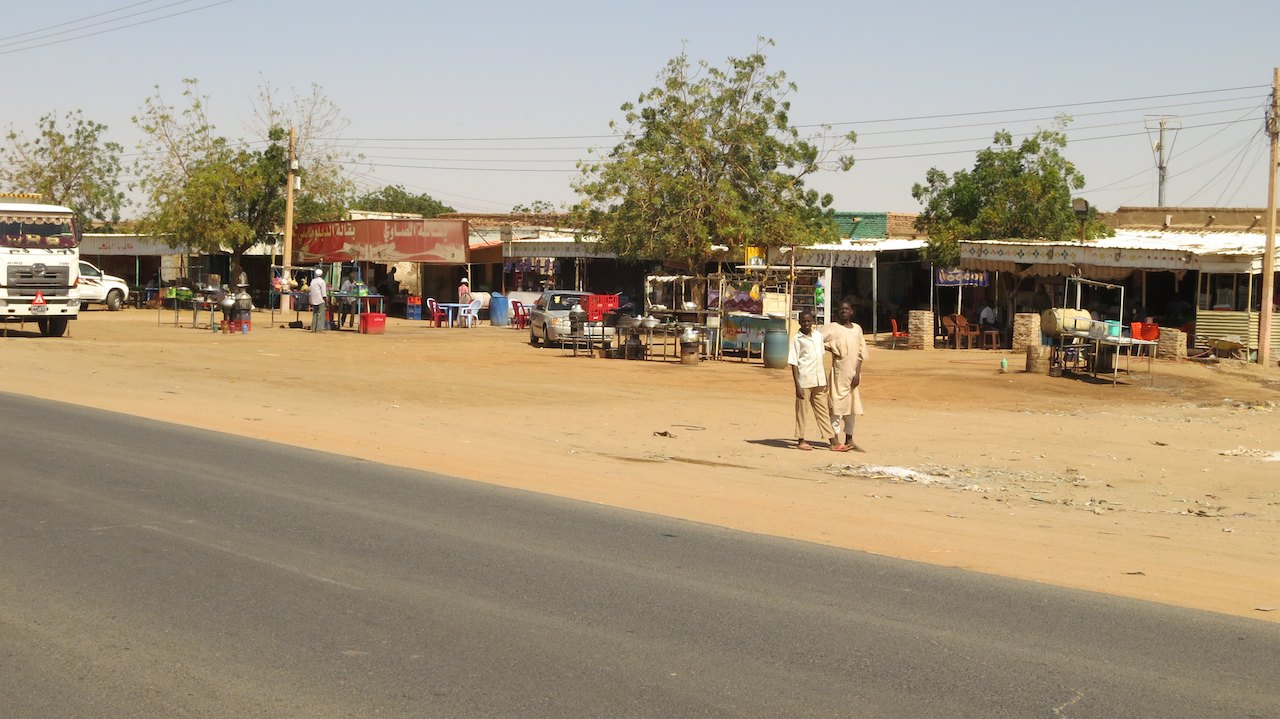
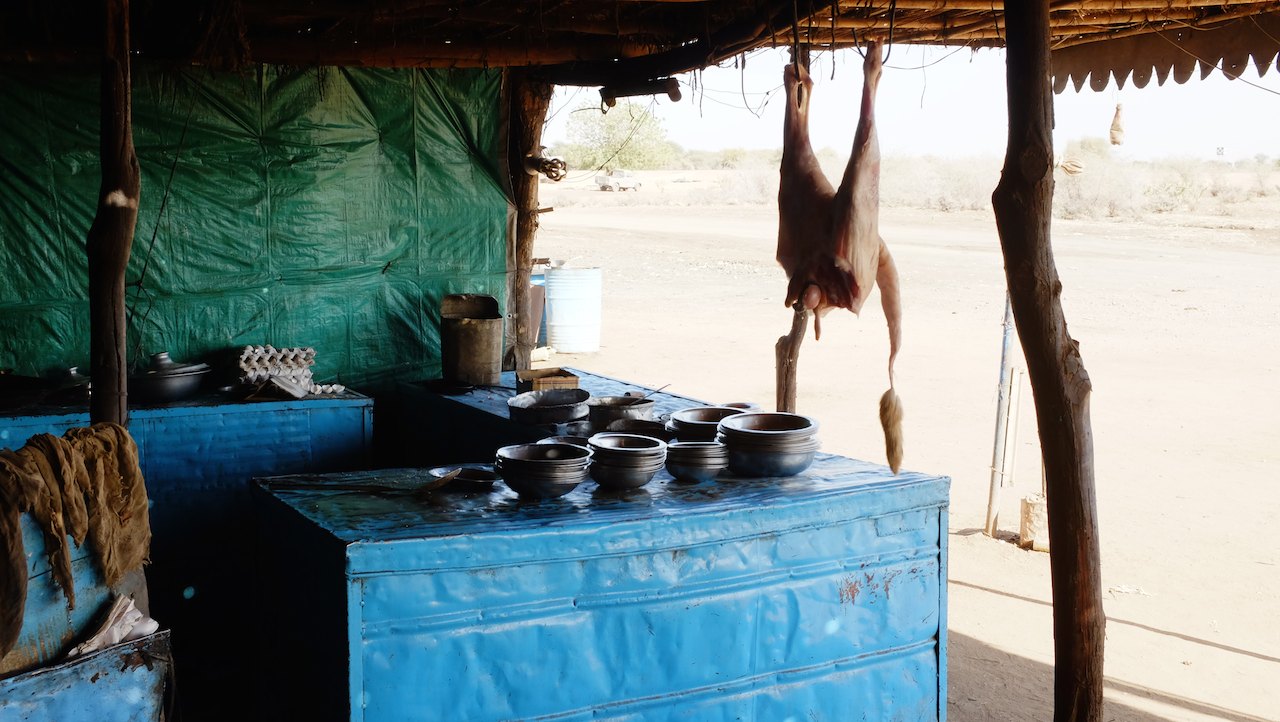
Once we have left the bustling Khartoum, the landscape quickly changes into dry, dusty plains. No more expensive cars or high buildings, but mud houses and donkey carts. Only the main road on which we drive is paved, all other roads are dirt roads with deep potholes. But even the paved road is in poor condition. We regularly need to slalom between the potholes to avoid a flat tire.
We drive through villages with long rows of small shops just next to the road. Oddly enough, you often find a number of the same shops next to each other. First a row of carpenters who all offer the same wooden frames, then a row of blacksmiths with the exact same metal fencing and then a row of restaurants. What is also striking, is that you can get a Coca Cola everywhere. In the most deserted village and most secluded restaurant you can always get a bottle of sugarwater. A bottle of Coke is often more readily available than a bottle of water. There is tap water, but we only use that to brush our teeth and to cook, not for drinking. A good alternative is tea. The water has been boiled, so it is safe to drink. And along the way there are ‘chai-mamas’ everywhere selling their spicy tea.
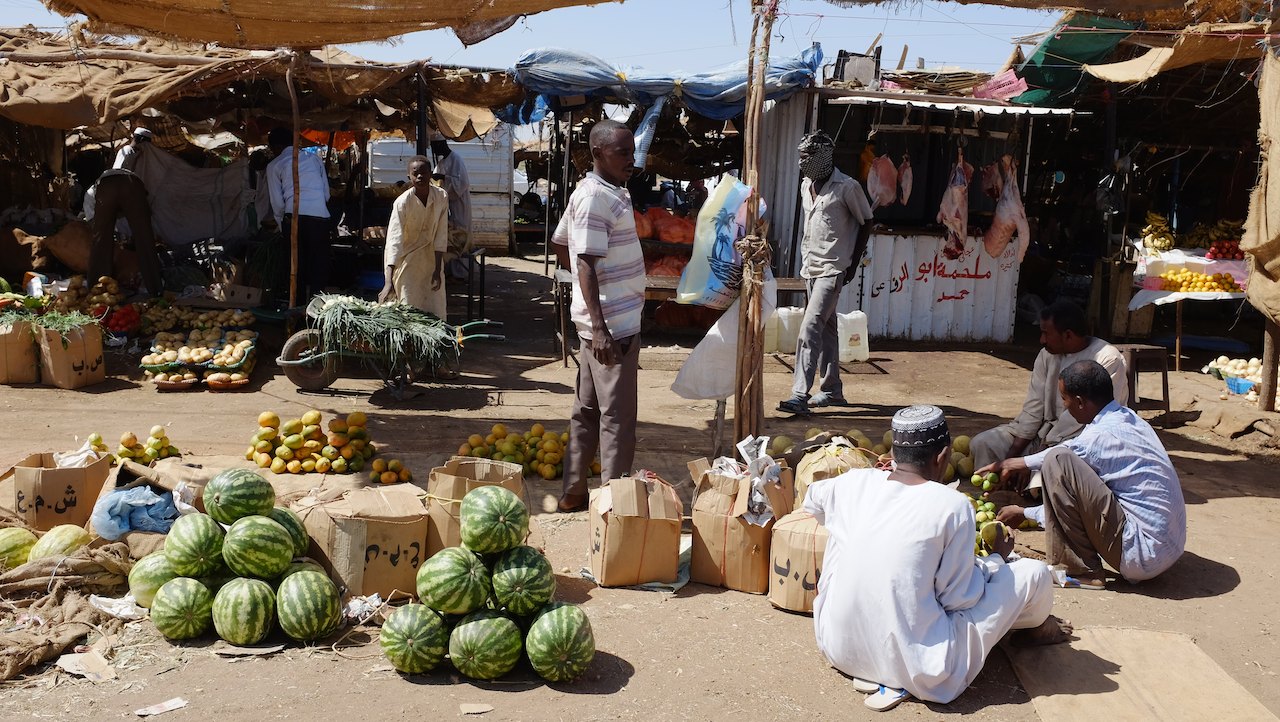
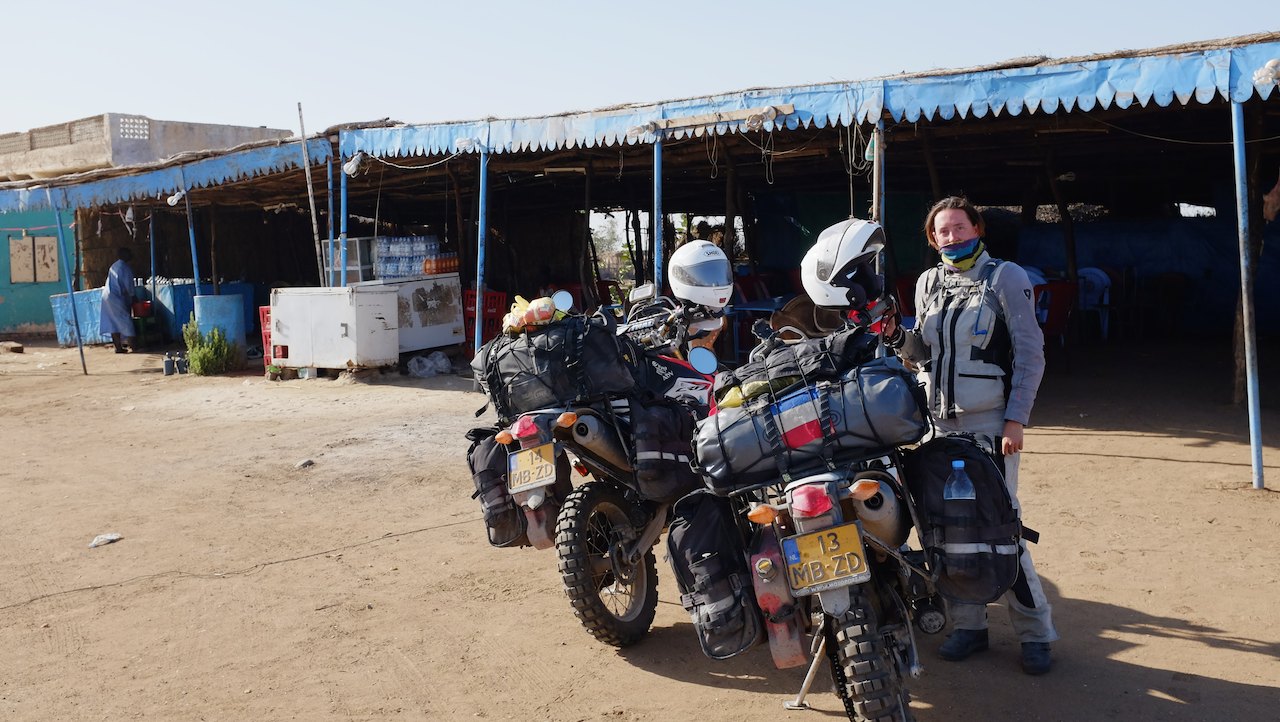
At one of the many villages we stop at the market to buy some fruit and vegetables. While I am negotiating about the price of bananas, a large group of Sudanese men gathers around the bikes. Peter is subjected to a cross-examination. “ What brand is the motorbike?“, “ How many cc?”, “ What is the maximum speed?” and the most asked question “ What does the motorbike cost?“. As I put away the groceries I get out my camera to take some pictures of the crowd. After two pictures I walk across the street to take some picture of the market, the group of Sudanese men and Peters white helmet that only just sticks out of the crowd. When I get back to my bike and want to store away the camera, a man next to me commands in a loud voice, out of nothing that I should delete my pictures.
“ Sorry? Delete my pictures?“.
“ YES , DELETE THE PICTURES! NOW!“
In Sudan you require a permit to travel through the country and a permit to take pictures. But even with the permit you cannot take all the pictures you want . As in many other countries, you cannot take any photos at strategically important points such as bridges and police posts. In Sudan the rules are even more strict as they do not allow you to take any pictures of ‘public buildings’. The problem is that a lot of the buildings fall under that Sudanese definition and you may not always be aware of that. Sudan even adds to this by also prohibiting photos of slums and beggars.
You need to carry several copies of the permit with you so you can always give one to the police when requested. We only heard of the compulsory permit in Khartoum and did not want to put in the effort to get one at that time. It went fine without a permit so far and we figured that the last two days in Sudan, from Khartoum to the border, would surely be OK as well. At least, so we thought.
The man again demands that I remove the photos. Because he is not wearing a uniform it is not clear whether he is a police officer or whether he is a bystander who did not like that he was photographed. A bit overwhelmed by his command I ask once again what he means and explain that I want to take pictures because Sudan is such a beautiful country. But he does not want to talk. He points to a man in uniform who is standing a little further away and says: “ We are police. No talking. Delete! NOW!“
It is clear what he wants. Apparently I have made pictures of a subject they do not like to be photographed. There is no building around for miles that can be regarded as a “government building”, so probably the market is considered to be ‘slum’. Just before he makes a move to grab the camera out of my hands I decide to delete the photos. Especially since we do not have a permit, I do not want to risk loosing all our pictures or even the camera. I keep the camera in front of his face and I show that I delete the photos I had just taken. To prevent that he also wants me to delete the other pictures of Sudan, I then only show pictures of Europe that are still on the memory card. He is OK with this and does not ask for the permit. After we have promised that we will not make anymore pictures in Sudan we can go.
A bit confused I get back on the bike. What a “#$*&*%BEEEP” of a guy! We have come across a number of policemen and soldiers, but this was the first time the hairs on my arms raised. A situation where your intuition tells you: “He means business.” We drive out of the village and stop a little further to switch the memory card. Maybe we can still retrieve the deleted photos with some special software. And if we are stopped again we will not risk loosing other pictures we took. Stubburn travellers as we are, we stop a few more times after that to take pictures of Sudan. It still is a really beautiful country! And what are the chances that we will encounter that policeman again?
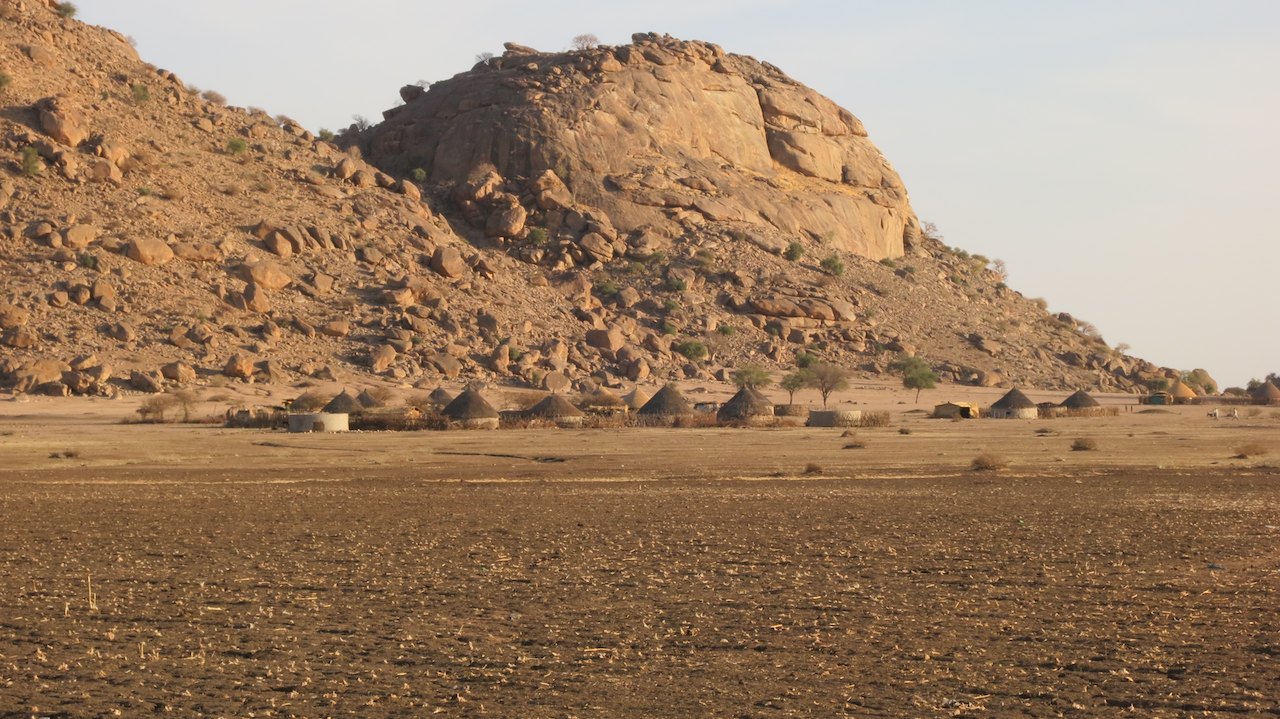
We stop to drink some tea at one of the ‘restaurants’ along the way. We park the motorbikes and see a group of men just getting ready for afternoon prayers. One of them gestures that we can find ourselves a table, he will be right out. After prayers, he takes our order while the others examine the motorbikes and ask us the usual questions. They consider our journey to be an adventure and cannot believe we have really driven the ‘mopeds’ from Amsterdam to Sudan. When the tea arrives they excuse themselves and take a place on the beds in the corner of the restaurant. A great place to get through the hot afternoons of Sudan. The tea is ’on the house’. The man explains that as a Muslim he has a duty to take care of travellers and that he is happy that he can offer us some tea. Welcome to Sudan!
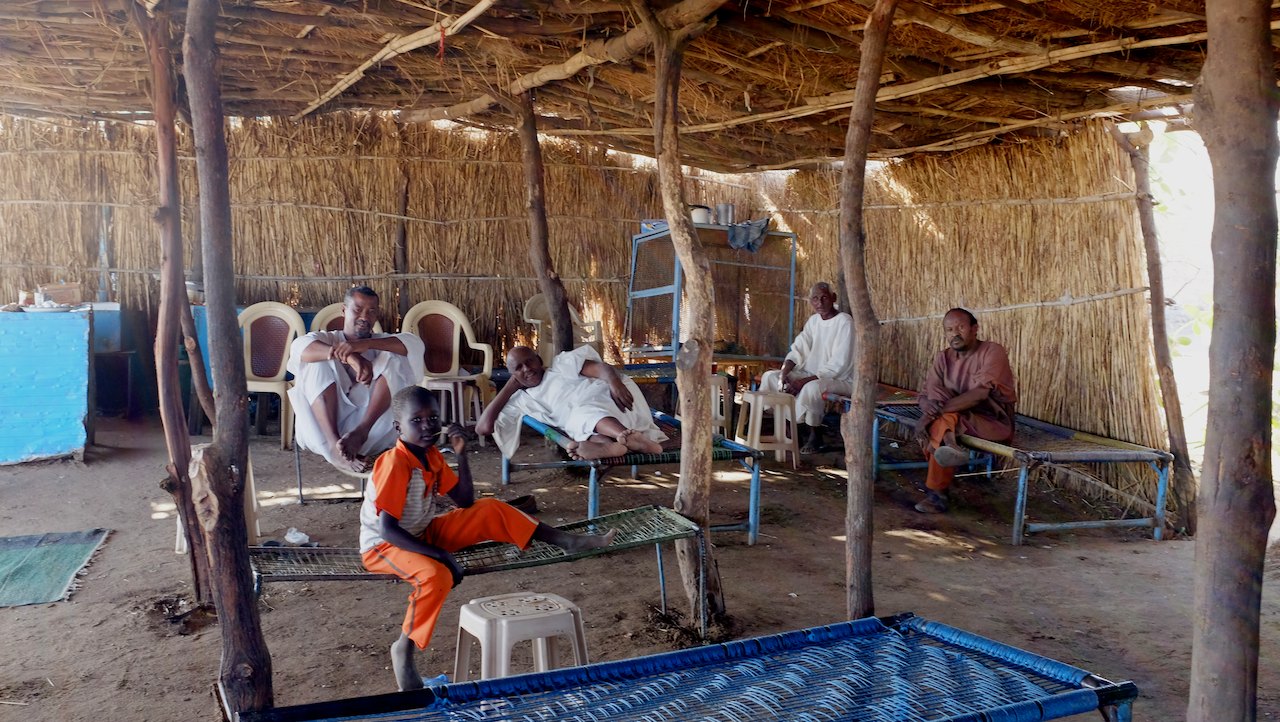
There is a lot of traffic on the road to and from Khartoum. Just like in northern Sudan we have to be very careful for oncoming busses that overtake slower traffic in the strangest places. But we also have to keep an eye on the traffic that overtakes us in order to avoid being cut off. It often happens that overtaking traffic just keeps driving next to us to examine us more closely. One car in particular acts very strangely. The driver continues to ride beside me for a long time, getting closer and almost pushing me off the road. I pick up speed to get back in front of the car, but the driver also accelerates and drives next to me again. At the point where he comes too close again, I gesture that he should back off. Then he accelerates and starts driving very closely to Peter, almost pushing him off the road. Then I suddenly see it is the policeman we met earlier that day. So yet again after all!
The angry policeman hangs out the window and gestures that we should stop. Apart from the uniform of the person next to him, we can in no way see that we are dealing with police. It is a normal car. The angry man asks Peter for his passport. Peter asks in turn for the identification of the agents and explains that he is not just giving his passport to anyone. The agent starts rummaging in the glove box. First he pulls out a gun which he keeps high up in the air ostentatiously while he continues looking in the glove box with his other hand. He gives a card bearing the photograph of the person next to him. Unfortunately, he had left his own card lying at home (yeah right…)
After a brief look at the passports, he asks whether we have registered (all foreigners must register as they enter Sudan and pay as much as $50 per person on top of our visa of $50). Peter points to the green sticker in our passports.The man takes another look. Once we have again promised that we will not take photos in Sudan, we can go. Luckily he does not ask for the missing permit. Will this be the last time then? After that we see the car one more time while it stops to drive into a little town. We hope they think it is enough now. We are fed up any way.
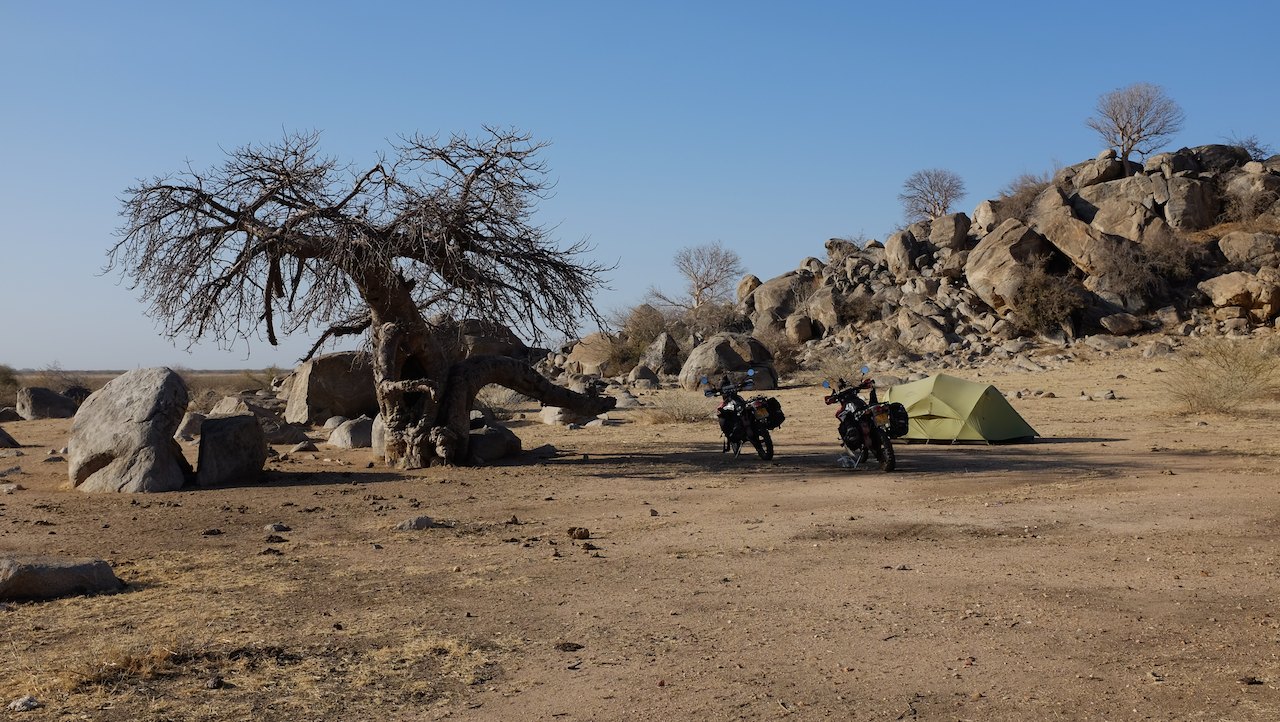
At the end of the afternoon we leave the main road and find a wonderful old baobab tree a few kilometers down the road where we can camp. Before we pitch the tent, we sit under the tree for a while to have a drink and to consider whether we can sleep here without being disturbed. If after one hour no one has come to see us and it is not so warm anymore, we pitch our tent and again cook some pasta.
The next morning I an woken up by someone who is singing loudly. I also hear the occasional cow moo and branches breaking. As I look out the window of our tent, I see a large group of cows trudge past with a boy on a donkey in front. It is the same boy that we had seen with his cows the night before when we drove onto the sandy path to the big baobab. From a distance he takes a look at our tent, but then rides along singing loudly. The cows follow him. We are again amazed by the fact that we can just be here, without people coming to visit us.
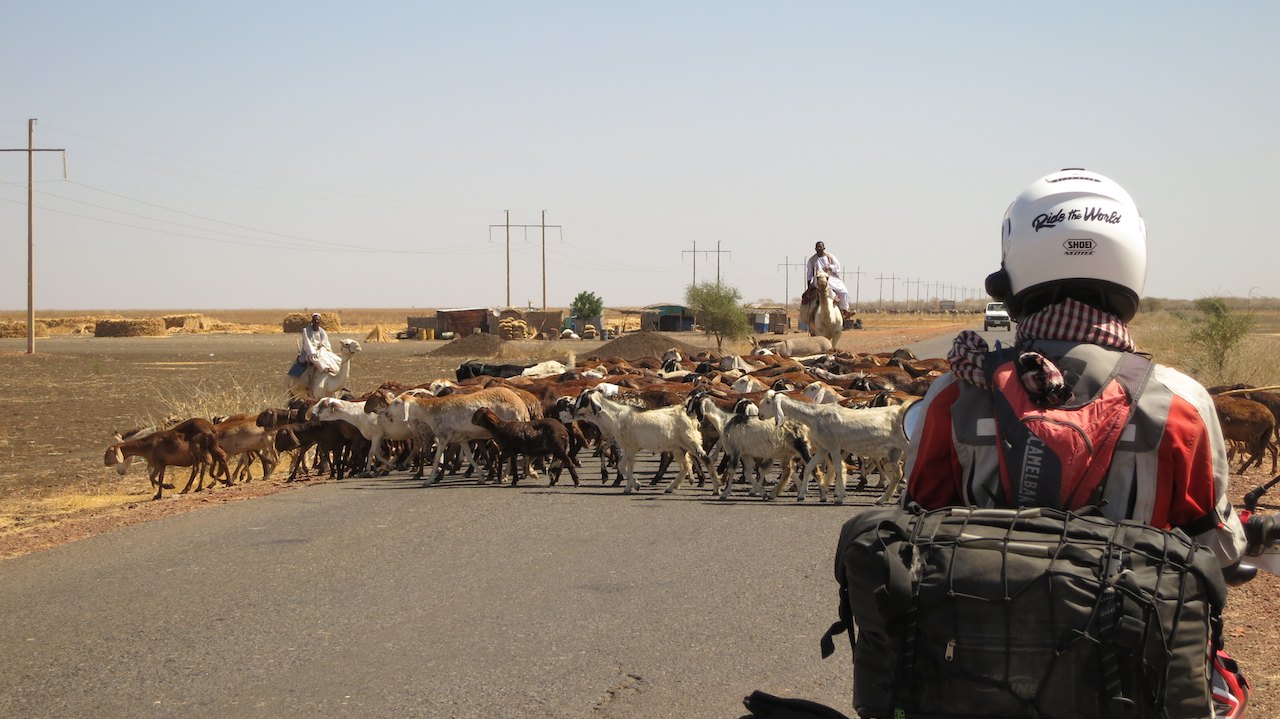
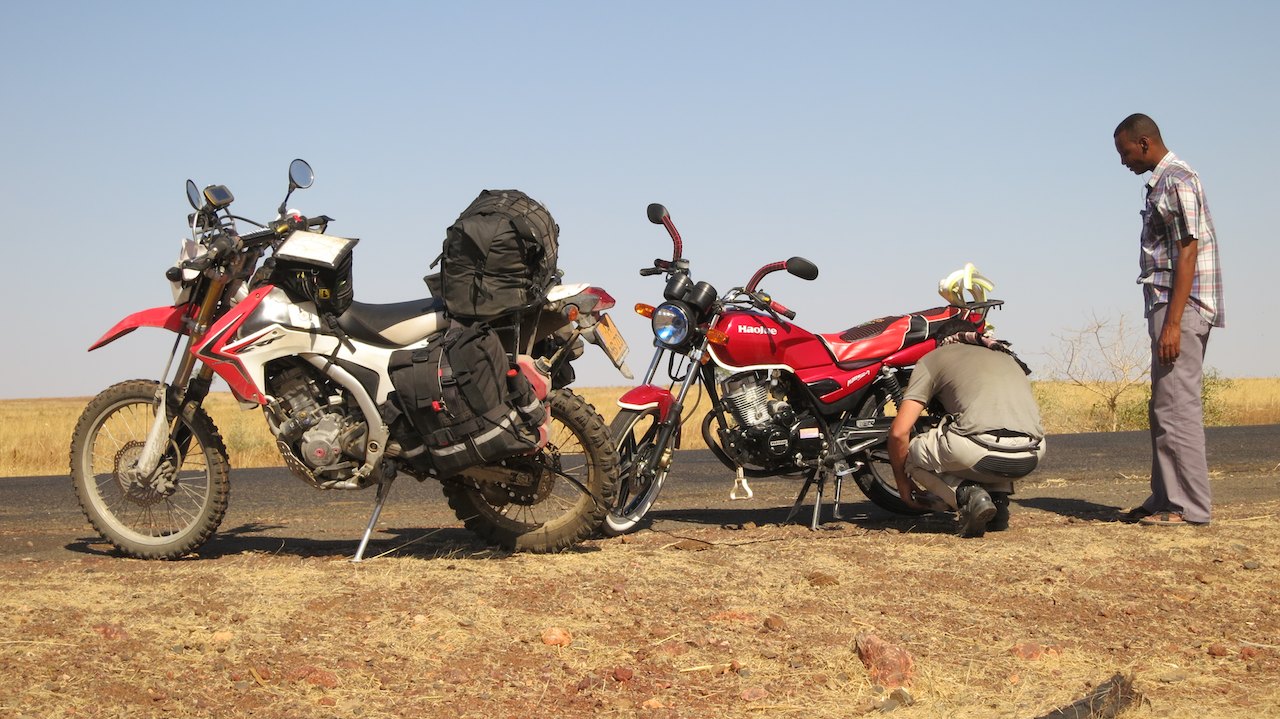
We drive through warm Sudan, stopping occasionally for cattle crossing the road, helping a Sudanese motorcyclist with his flat tire and eating a sandwich in the shade. Gasoline is still difficult to get, so wherever we can we fill up the motorbikes to avoid getting stranded. The landscape changes as we drive further south. We pass dry plains with the occasional brown hill and dry riverbeds meandering through the landscape. The houses are not built of clay anymore, but are made of wooden sticks and straw. Small round huts in a group together, with some cows and goats grazing in between them. The villages blend in perfectly and can hardly be seen from the road against the brown hills.
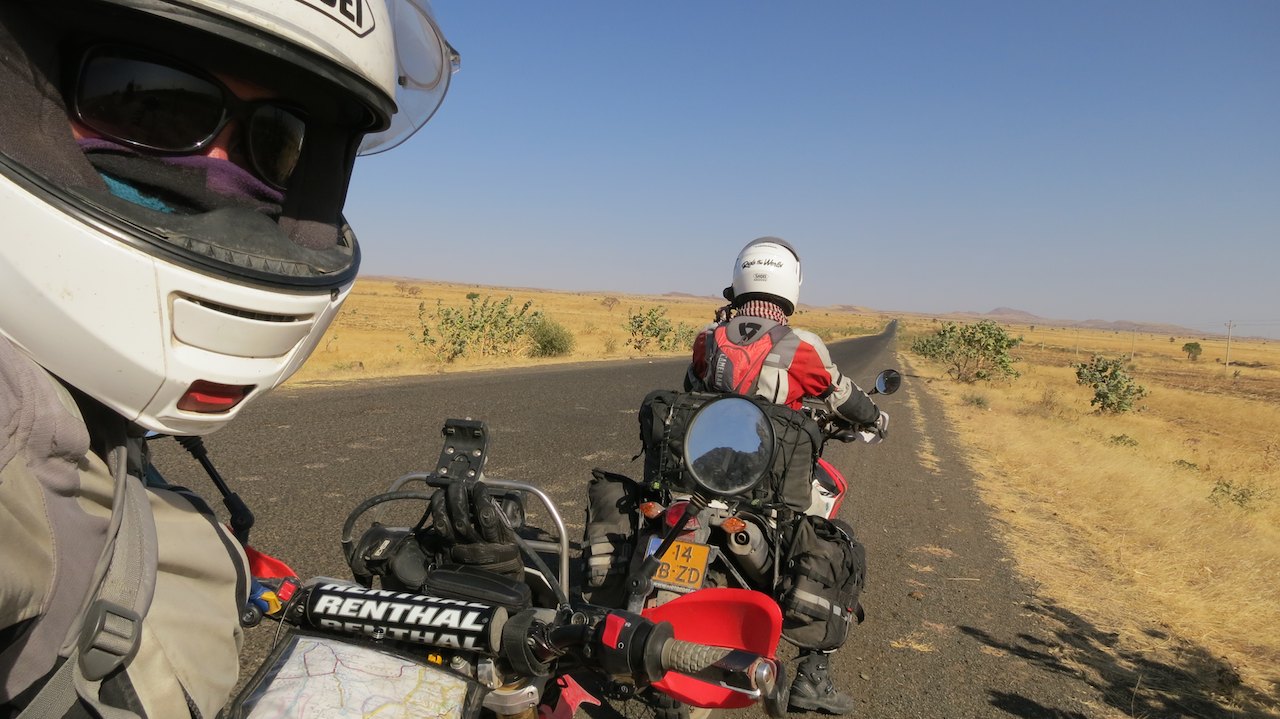
At the end of the day it takes a little more effort to find a camping spot. Right next to the road the forest is either too dense or the plain is too open. Finally we drive along some fields towards a dry river where we find a reasonably flat spot for the tent. Again we wait a bit before we pitch the tent to see if there are any angry farmers asking us to leave. Once the tent is pitched we hear a truck very close to the tent, but that is it.
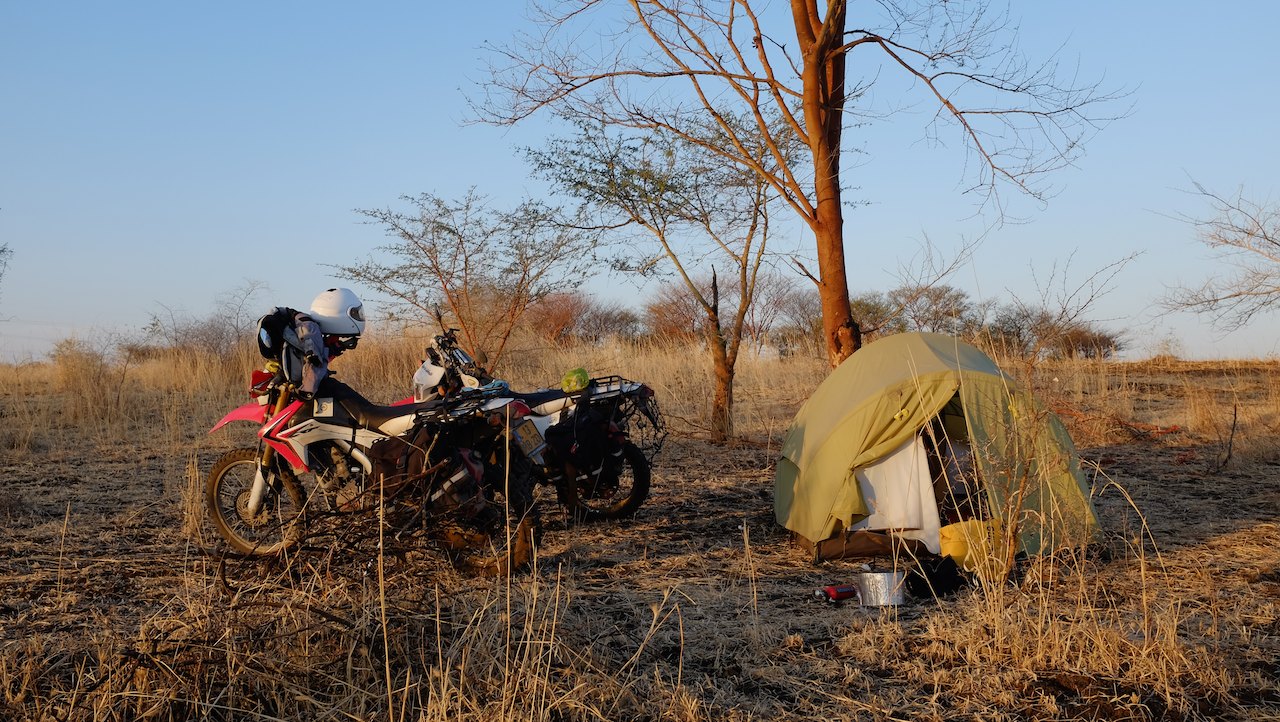
The next morning we wake up well before the alarm goes off. We sit on the motorbikes packed and ready to go by 09:00 am. After 30km we arrive in Metema, a small village with a long row of busy shops and a number of larger buildings. In no way it looks like the land border between Tunisia and Libya or the border between Libya and Egypt. No big gates, no stern looking officers or long lines of people waiting. Only a barrier that is manually operated by a customs official who still slumped in a broken chair.
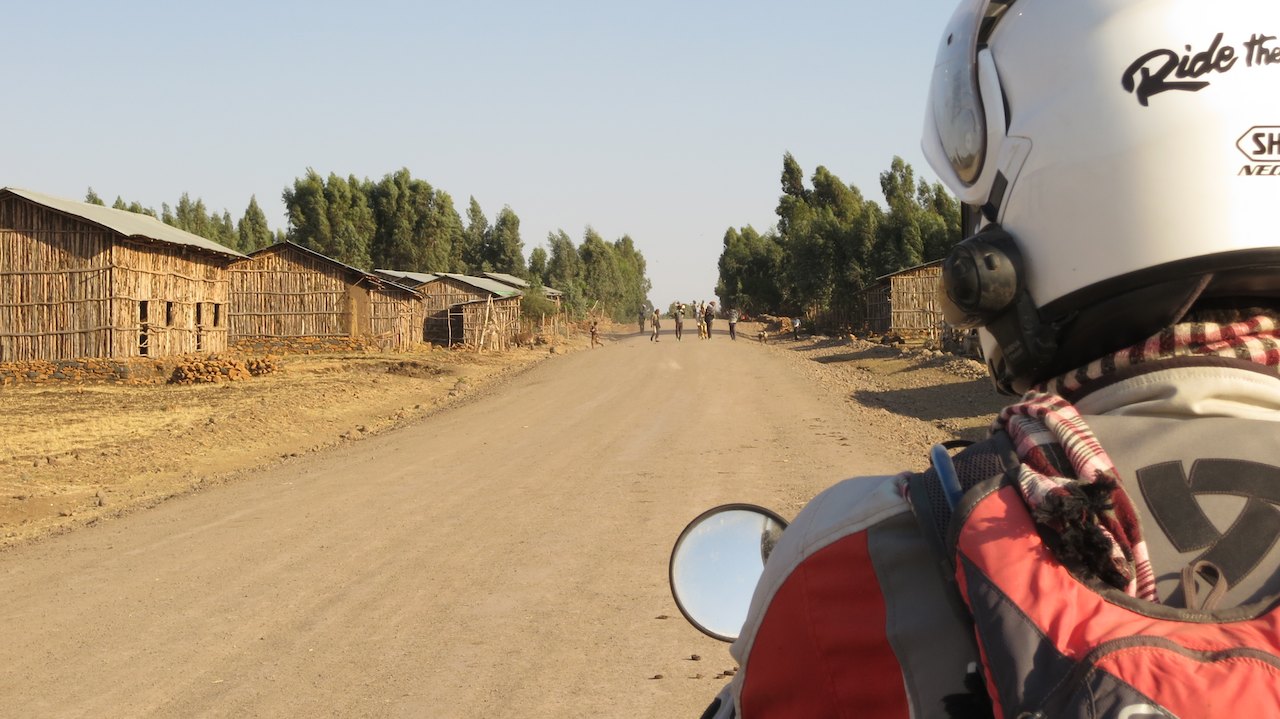
Before we pass the border and enter Ethiopia, we still need to get some stamps on the Sudanese side. It is not quite clear where we should go, but as usual we attract enough attention and one of the bystanders exactly knows where we should go. First to the local police station for registration. We enter a large empty room. In one corner there is a television with one chair right in froth of it. A soap opera is broadcasted. On the other side there is an empty desk with only a big book and a pencil lying on it. The man behind the desk holds up his hand and asks for our passports while continuing to watch the television.
After our data is recorded, our guide takes us to another building. We sit down in one of the chairs in the waiting area. We are the only people waiting and even the only ones in the entire building. The offices are empty and appear to be little used. The customs officer is still missing, but our guide is going to find him. After some time our guide comes back with a man who takes our carnets. We follow him to an office; a small room with two desks, some worn chairs and a cupboard full of binders. On one of the desks is a computer which is protected against dust by a piece of plastic. The man sits down at the other empty desk and takes out some big books, a pen and carbon paper. Then he begins to fill out one form after another, while properly placing the carbon paper in the right place. A signature here, a scribble there, a staple in one form, it seems to take forever but we finally get stamps in our carnets.
He refers us to the next building. This time there is an English movie showing on television. We hand over our passports and see a senior customs officer checking the documents after which he instructs his staff to take our details and stamps the passports. With the stamped passports we walk back to the bikes. A large group of young guys has gathered there offering to exchange money. The exchange rate is very bad but despite tough negotiations we do not get the price up. We decide to exchange only half of all of our Sudanese Pounds and try again in Ethiopia. We have all the stamps we need, so we can go! The customs officer at the gate slowly get up from his chair, lets the barrier up and waves us through, out of Sudan.
At the other side someone is already pointing us where to go on the Ethiopian side. We first have to take our passport to customs. Even though we are only 100 meters from the Sudanese customs office, it seems like we are in a completely different world. On the desks are computers, printers, cameras and even finger scanners. On the wall are posters with beautiful photos of Ethiopia, pictures of the president and the Ethiopian flag. In fluent English we are asked to take a seat in one of the chairs.
Our picture is taken with a futuristic webcam, the fingers of both our hands are scanned and all data is neatly captured in the computer. After fifteen minutes we are back outside and redirected to another building to register our motorbikes. This department of the Ethiopian customs was not so lucky yet and has not yet have a computer at its disposal. The man has to use a pen and some carbon paper to fill out the different forms. Yet it all goes very smooth. After the man has seen our motorbikes and has verified the colour and the chassis number, he stamps our documents. Then the rope across the road(!) is lowered and we can ride into Ethiopia!
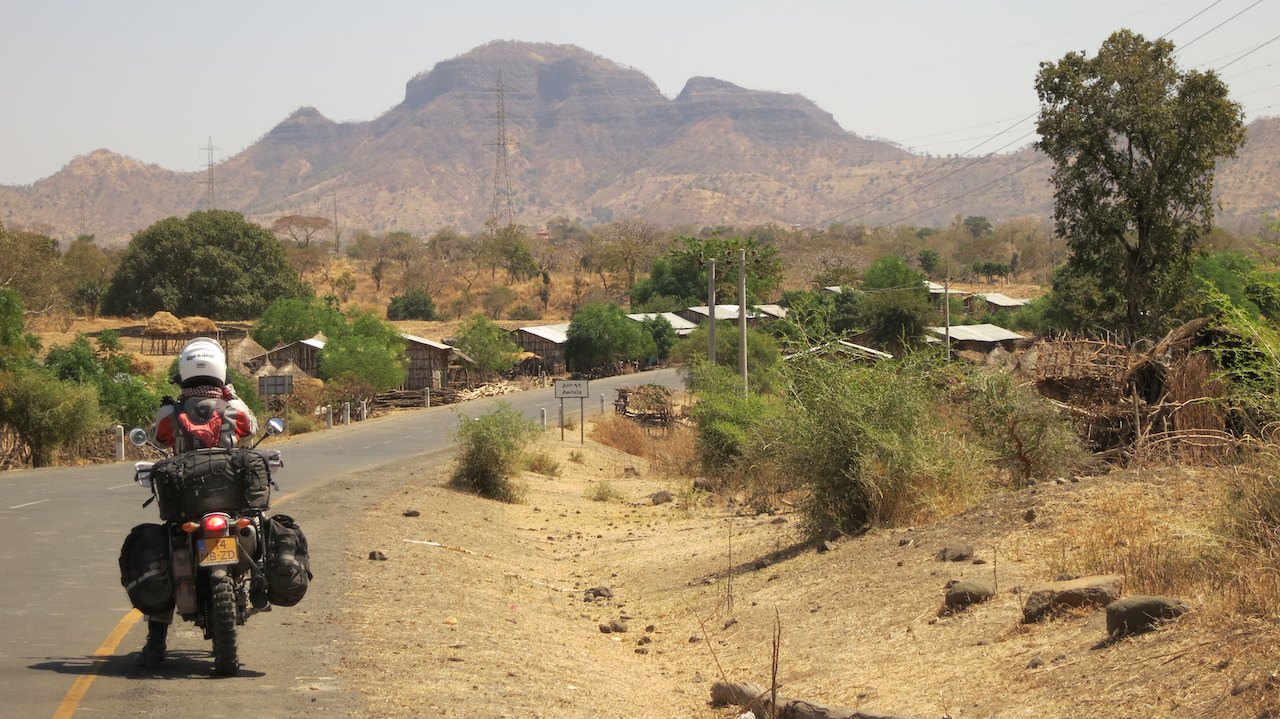
We drive through a street with many shops, just like in Sudan. However, it does not look like the street on the Sudanese side where we just came from. We can now read the signs and placards, because the text is not only in Amhars (the beautiful Ethiopian curl script) but also in English. In Sudan most signs were only in Arabic. It is also a lot busier in the street. At this side of the border there are at least five times more people on the road than in Sudan. We are also struck by how colorful everyone is dressed. In Egypt and Sudan most people were dressed in brown, black or white. Now we see bright blue and bright red, colors that stand out against the dark skin of the Ethiopians. Their favorite t-shirt is without a doubt the green and yellow striped football shirt of the Ethiopian team.
Yet the biggest difference are the ladies! For the first time in a long time we see a lot of women in the street. And not just women, but very pretty women! Ethiopian women are known for their beauty. Long slender bodies, handsome faces and special hairstyles. And all in Western clothes and no longer hidden under a long wide dress. I am not the only one who notices all this beauty. Over the intercom I hear Peter utter several approving comments about their curves and their beautiful eyes.
We exchange the second half of our Sudanese Pounds against an equally bad rate, buy an Ethiopian phone card and ride out of town. We head for Gorgora, a small town on Lake Tana. Several overlanders told us to visit “Tim & Kim Village”, a lodge and campsite that is run by a Dutch couple. On a beautiful smooth asphalt road we drive into the hills. The road winds and for the first time in a long time we ride some great curves. Very nice after the long straight roads in the last few countries. We drive from the border, which was at 700 meters, to 2200 meters altitude. The higher we go, the cooler it becomes. That is also very nice after the hot hair dryer-like air we drove through during the last weeks.
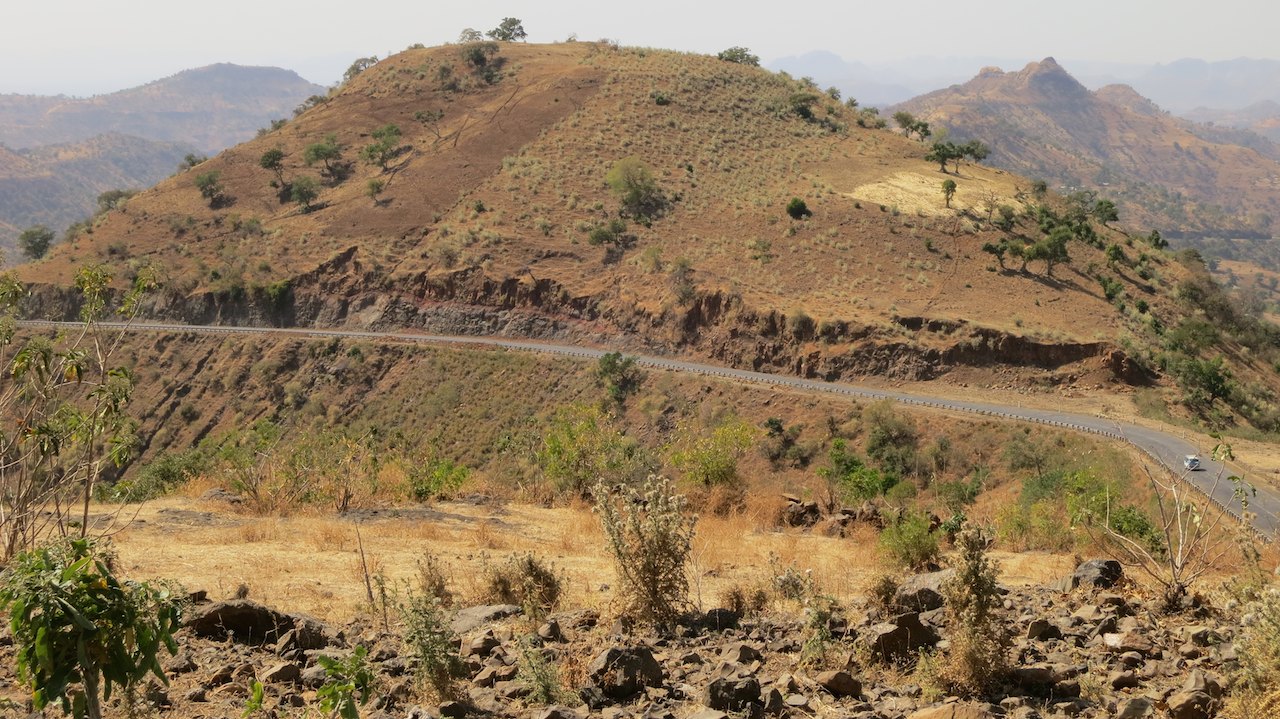
At the end of the afternoon we drive onto the gravel road to Gorgora. It is a very bad road with large loose stones and huge “potholes”. The average speed drops to 30km per hour. It still is 60km and at this speed it will take some time before we are at the campsite.
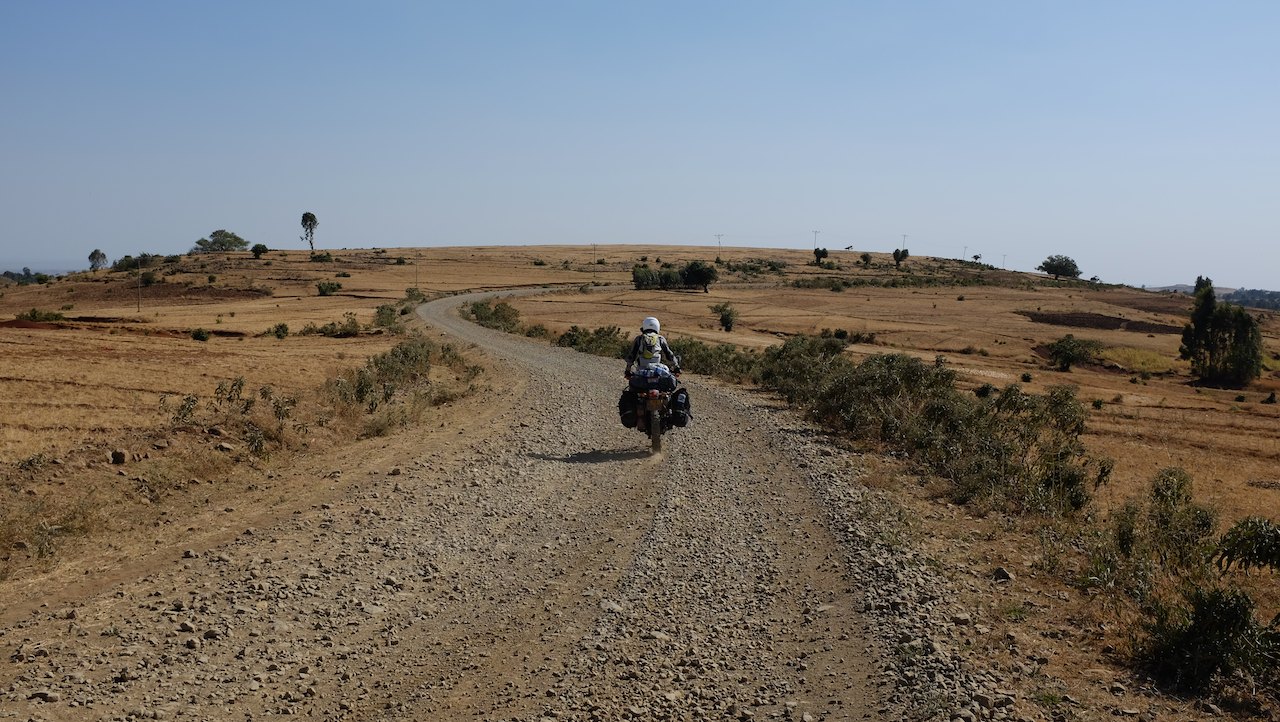
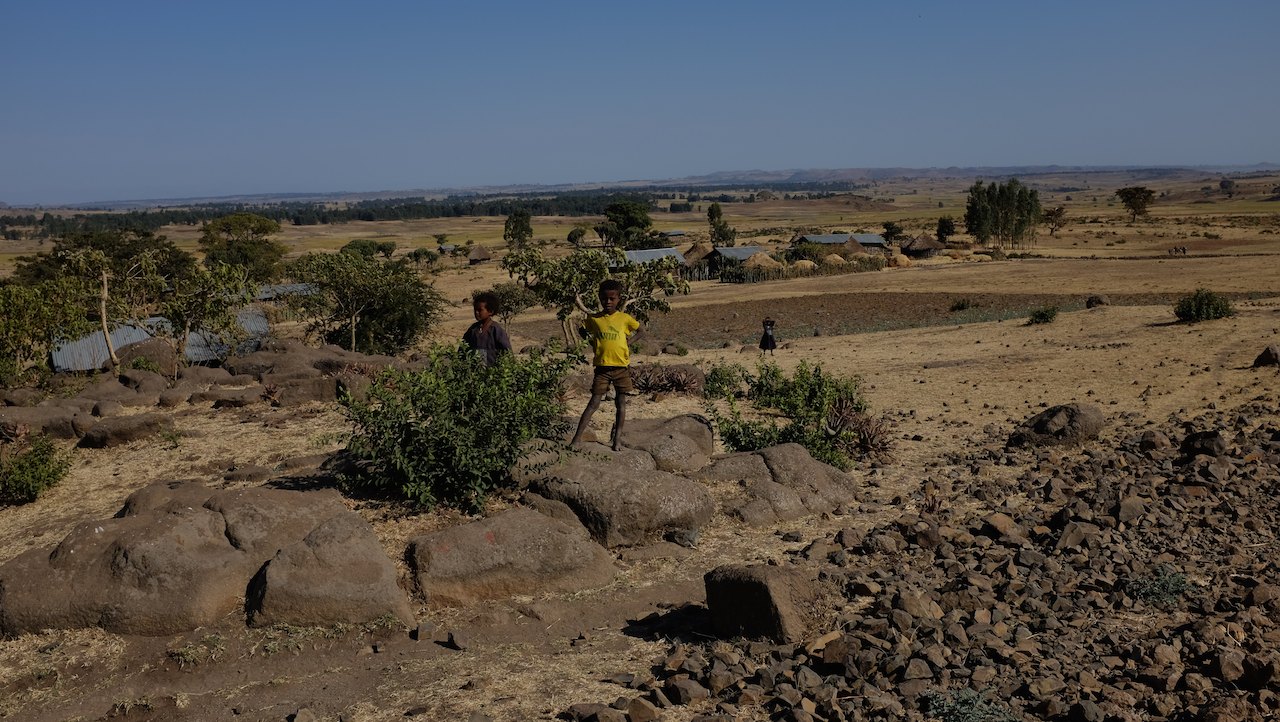
It is very busy on the road. Not with traffic , but with people! People are walking everywhere! Many of them with large packs on their heads or backs, but most with cattle. With a stick in their hand they herd donkeys, cows, goats and sheep. We are becoming used to being an attraction, but we have not experienced before what is happening to us now, here in Ethiopia. Several times the people throw the package they are carrying on the ground after which they run to the side of the road screaming with their hands on their head. Hiding behind a tree or ducking behind their cattle, they watch us. And when we are inching through the small villages, I have to brake hard several times to avoid hitting a petrified pedestrian that is gaping at Peter. By the time they have recovered from the initial shock and turn around they look at me with big eyes and then run to the side of the road. OK, we may look like aliens but here we certainly feel like aliens as well for the first time.
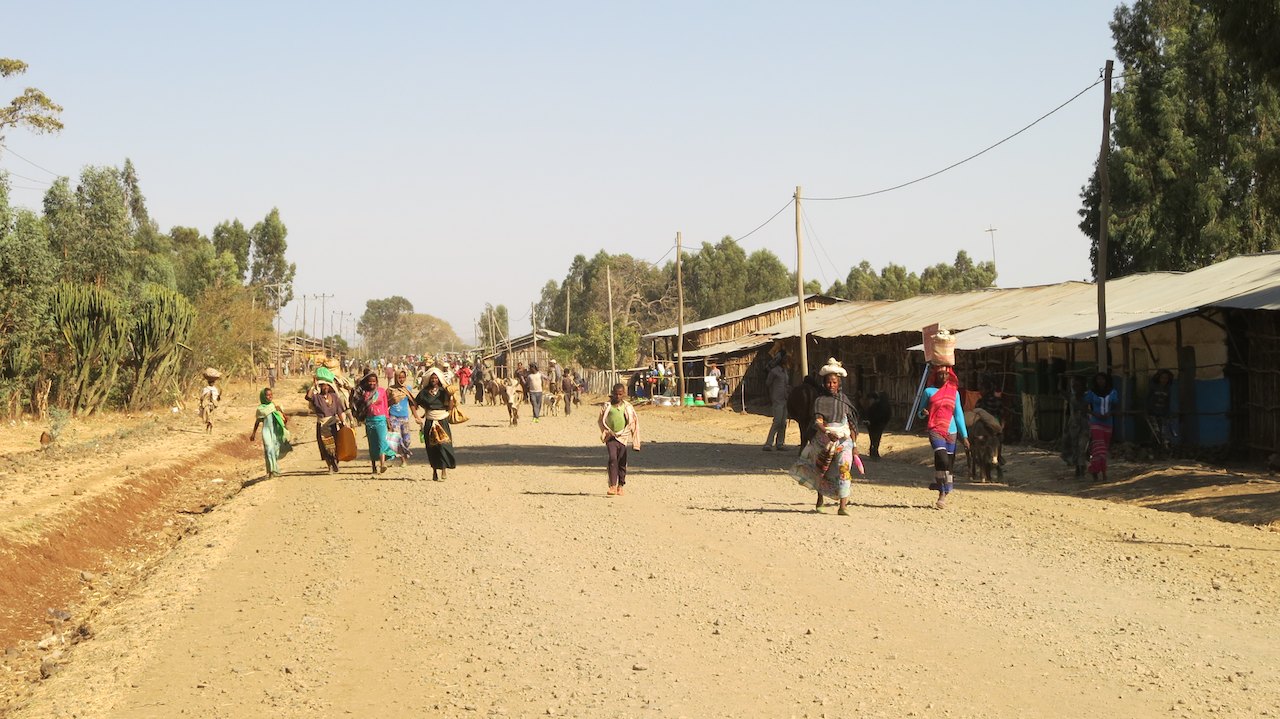
As quiet as the people in Sudan were, so intrusive are the people we encounter in the first Ethiopian villages. Once we stop to take a picture kids come running from all sides. “ You, you, you” it sounds and “ Faranji! Faranji!” (Which means “ White man! White man!”). Although their hand first goes up to wave at us, the same hand then is made into a bowl and we hear “ Give me pen“, “ Give me money!”, “ Give me something!“. Not only do children come to ask for a pen, water or food, but adults also hold up their hand as we pass.
The differences with Sudan, especially with regard to the people we encounter, are overwhelming. Because we travel overland by motorbike the landscape and culture usually change very gradually. The transition from Sudan to Ethiopia however feels like the culture shock that you may experience when you fly to a distant destination. We were not prepared for this.
It is already getting dark when we arrive at the camp site and are greeted by Kim. We quickly pitch the tent, take the first proper shower in a week and join Kim and Tim for diner that evening. Then we hear that Saturday is ’market day’, which means that people come out of the hills to take their cattle to the villages for sale. A large number of people will not often, or perhaps even never, have seen a motorcycle let alone a rider in a motorcycle suit with a helmet. So to them we might very well have been aliens after all!
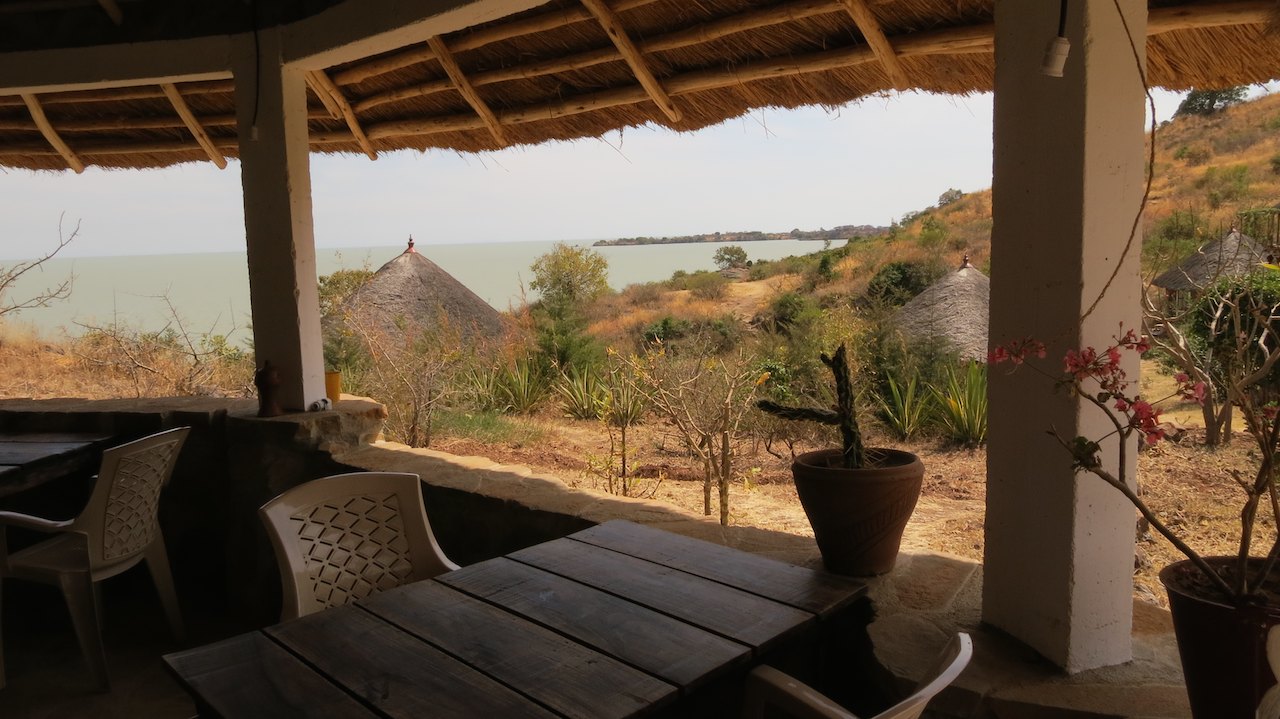
After the limited facilities at the camp sites in Khartoum and the days of bush camping it is great to be at the campsite of Tim and Kim: a toilet with a toilet seat and toilet paper and a shower with a jet of (cold) water. We enjoy the first cold  s in a long time and the delicious food cooked by Kim. Lake Tana also appears to be a birding paradise. We sit with our binoculars at the lake or under the big tree next to our tent watching the most beautiful birds for hours. We see Paradise Fly Catchers, Blue Cheeked Cordon Blues, Mouse Birds and Firefinches. Truly beautiful. We end up staying four nights to recover from the initial culture shock and to gain new energy to conquer the rest of Ethiopia. A great time!
—–
By leaving Sudan our time in North Africa ended. From leaving the ferry in Tunis we drove 7,200 kilometers through Tunisia, Libya, Egypt and Sudan. Countries that do not have a good reputation and are better known for riots and wars.
Although indeed incidents happen, our experience is that the media shows those events very one-sided. The positive stories around the referendum in early January 2014 that buzzed through Egypt, could not be found in the media. To the contrary, the emphasis was placed on the number of police officers that were needed to even hold the referendum and the number of incidents that took place nonetheless. We feel that is a pity. We often thought of the book “Het zijn net mensen” (They are just like people) by the Dutch journalist and author Joris Luyendijk, in which he describes the gap between what we read in the newspaper and the actual events in a particular area. As if a parallel universe is kept up.
We were pleasantly surprised by North Africa. Because of the way we were welcome everywhere and by the extraordinary hospitality that we experienced. Moreover, we have seen beautiful things. A step back in time with Leptis Magna in Libya, pyramids in Egypt and Sudan and treasures from ancient times in the National Museum in Cairo. But also great scenery: a beautiful coastline along the Mediterranean Sea, impressive desert landscapes and the beautiful Nile. Therefore, we do not say “farewell” but “Till next time, North Africa”, because we would love to come back again!
—–
Distance covered until Gorgora = 10,079 km (6,263 miles)
|

12 Dec 2014
|
|
Registered Users
HUBB regular
|
|
Join Date: Dec 2009
Location: The Netherlands
Posts: 66
|
|
|
To the north
Before we ride further south, we will go to the north of Ethiopia first for a tour around the beautiful Ethiopian Highlands. First to Gonder, a medium-sized provincial town north of Gorgora. There we can withdraw money, buy insurance for the motorbikes and hopefully get internet access. At Tim and Kim Village we could not access the Internet, but the blog could use an update and we would like to read some emails. After Gonder we will ride towards the Simien Mountains and the rock churches in the Tigray province.
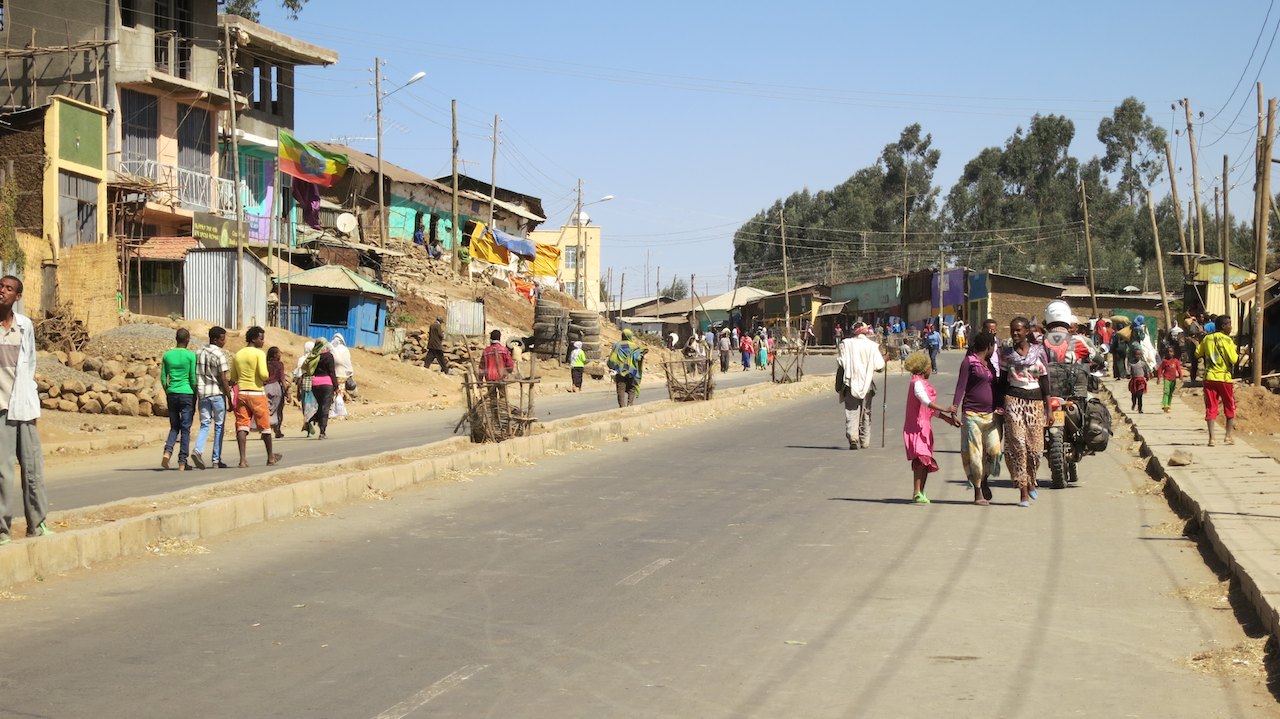
We say goodbye to Tim and Kim and set off. It is not as busy as during “market day”, but there are still plenty of people and animals on the road. We are now better prepared and drive at an appropriate speed on the gravel road back to the main road. We arrive in Gonder in the beginning of the afternoon. We need to refuel. Like in Sudan and Egypt, fuel is hard to get in Ethiopia. At the first fuel station, the attendant comes to meet us while shaking his head. He has no ’regular’ and refers us to a fuel station a few miles away. But even at that fuel station and the next six(!) stations then they cannot help us. We decide to find a place to sleep first before we continue the search for fuel.
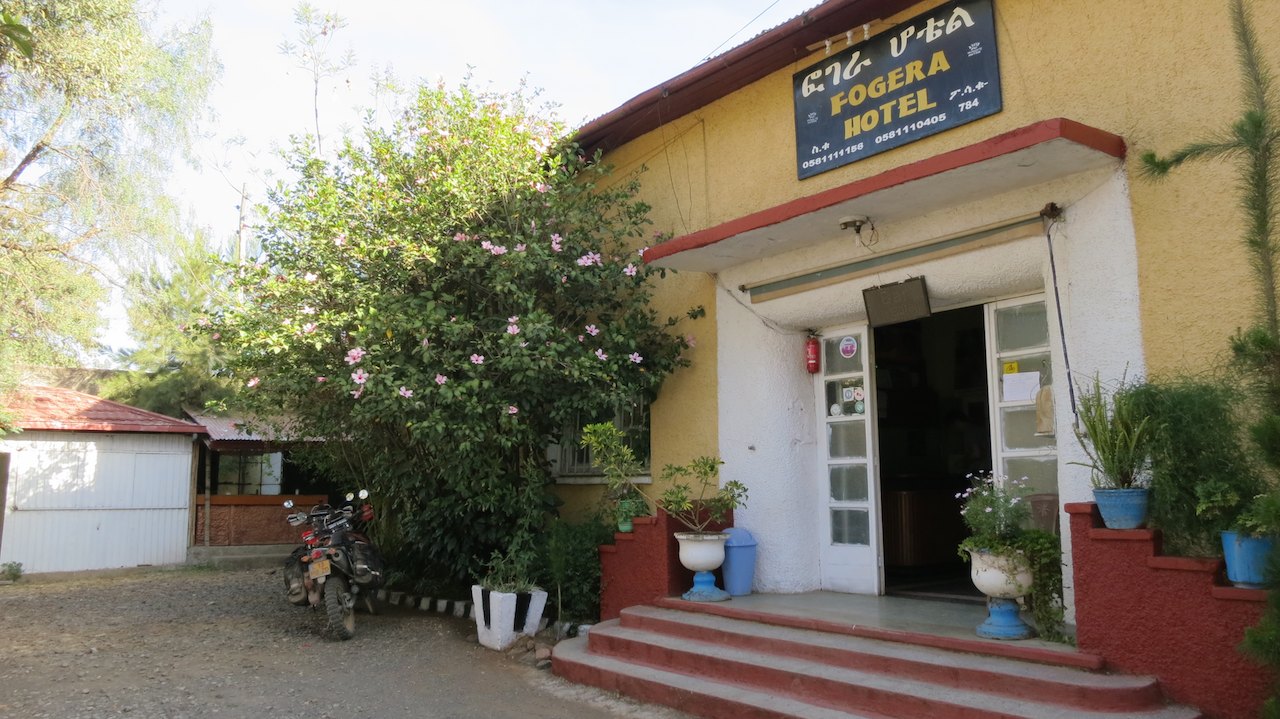
At the Fogera hotel we find a simple double room. In the reception there is a large sign that says “Free WiFi”. Great, because that was one of the things we wanted to settle in Gonder. But unfortunately, we cheered too soon. Although we are connected to the router, there is no internet. We still need to go to the city centre to get on the Internet in another way. Once in the centre we pass ETC Telecom. ETC provides postal services and owns all Ethiopian telecommunications. Maybe they can activate the simcard we bought at the border a few days ago.
In Africa, they more or less skipped the communication via land lines and immediately went mobile. It is not expensive. A prepaid simcard only costs 30 Ethiopian Birr (€1,12) and phones, especially the older models, are less than 270 Birr (€10). The number of mobile connections in Ethiopia has risen so quickly that the network cannot handle it. Especially for mobile Internet the network does not have enough capacity. A problem that will not be solved easily, because the number of mobile connections increases everyday. While I am waiting my turn at ETC, one mobile phone after another is sold. Some customers do not even have decent shoes, but they do have the required amount to buy a phone. Very remarkable.
Once it is my turn, a friendly lady informs me that I will not be able to access the Internet with the simcard we bought at the border. For Internet we need a different simcard or a dongle. For a dongle she refers us to a shop around the corner. We find the shop and are assisted by Sammy, a young whiz-kid who speaks a bit of English. After we have paid for one of his dongles, he ask for my phone. Before I know it, he has changed some of the settings and gives me back my phone grinning: “ You have internet in half an hour. No problem“. Great, at least that is something.
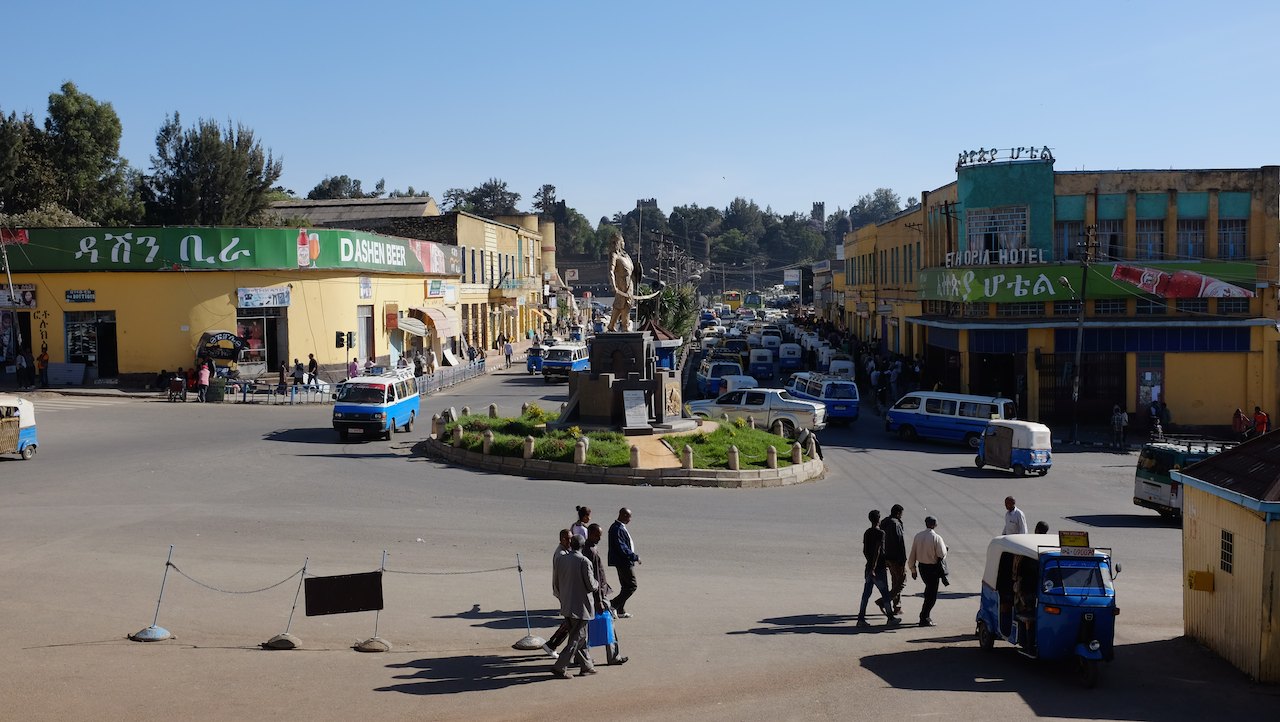
Back at the friendly lady at ETC I give her the dongle, a passport photo and a copy of my passport. It may not cost much, it does require quit a lot of paperwork to get online. Once she tries to register the dongle it appears the device does not work. We go back to Sammy. From his warehouse he grabs all the dongles that he has to join us to the ETC building. Together with the ETC lady he tries to register one of the dongles for us. It is now well past 17:00 and colleagues of the kind lady leave their workplace one by one. Several times we propose to come back the next day, but she says that wont be necessary, she will finish it tonight. What a service! In the end, it is almost 19:00 when one of the dongles is successfully registered. We still did not manage to get on the internet, but according to the lady that is due to the crowded ETC network. We should keep trying.
That evening we try to get on the Internet with the dongle several times. Unfortunately without any luck. The internet on my phone does work, so we can at least read some of our emails. The next morning we meet Sammy again to go back to ETC. The conclusion remains unchanged; the dongle works, the faulty network is the real problem. We will see about that later.
Now we can start the next administrative task: insurance for the motorbikes. In Sudan we had tried to get a ‘yellow card’ for Africa, but we did not succeed. We should be able to buy COMESA insurance in Ethiopia. At the first insurance office they luckily know what Comesa is and they can also sell it to us. Peter goes with the manager to his office, while I stay outside with our bikes. Like all administrative matters in Africa this also takes very long, but the long wait is rewarded. Three hours later Peter comes out with a yellow card for Africa for both of us. Great, that is settled. Now we can look for fuel.
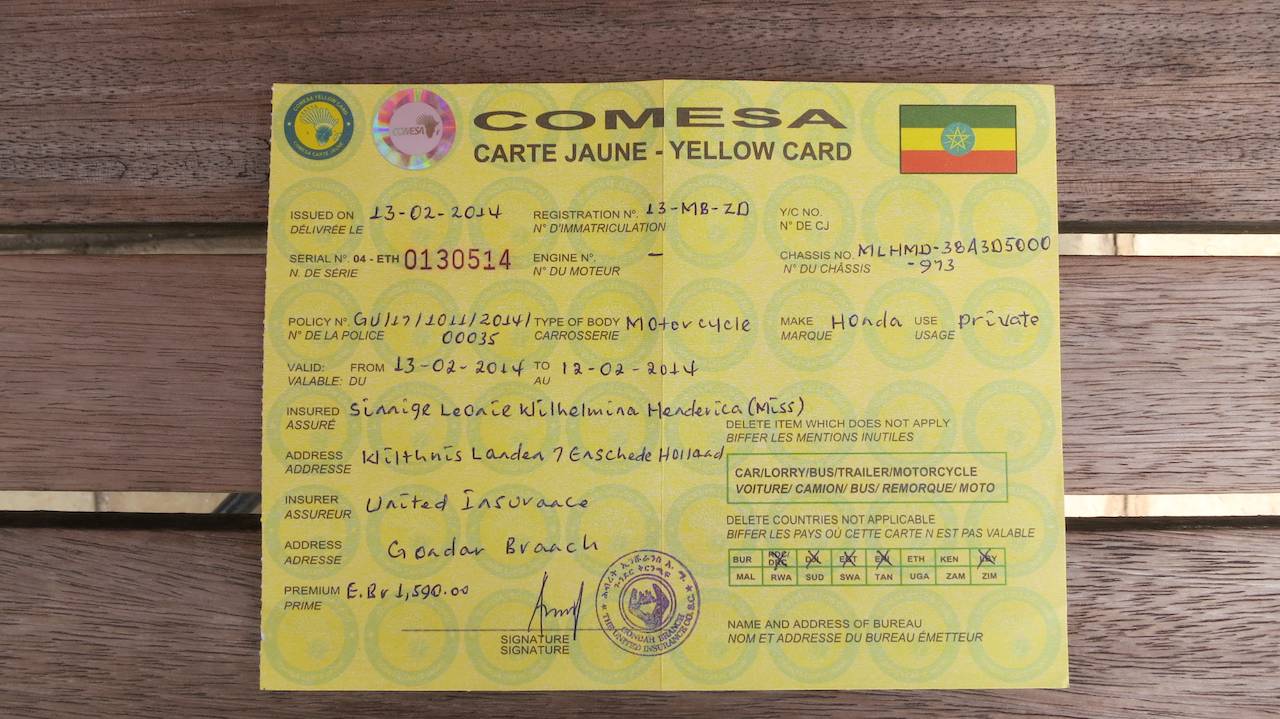
In the centre of town is one fuel station that we had not tried before. There is a long line of cars and -more importantly- a long line of tuk-tuks and motorbikes. Cars and trucks mostly take diesel, but tuk-tuks and motorbikes use fuel like us. We join the queue and drive little by little to the pump. Once there, it appears that there are two lines; one with vehicles and one with people with jerrycans. A spirited lady at the pump keeps a close eye on everybody and gives everyone the required fuel in turn. Full tanks means that we now only have to find a bank to withdraw some money.
In the centre we find a bank where the Visa card of Peter is accepted. We withdraw enough money for the next few days and then can finally go! We get on the bikes and start the bikes. Then I hear Peter grumbling. He left the GPS at the insurance office! We have to go back to get it. Unfortunately, by now it is lunch time and the office is closed for the next two hours. We decide to have some lunch as well and park our bikes in front of the insurance office 1,5 hours later. One of the ladies already comes out of the building with the GPS high in the air. Relieved that the GPS is not gone missing, we drive out of town. Without a working dongle, but with mobile internet, insurance for the bike, a full wallet, a full tank and good spirits to finally head north.
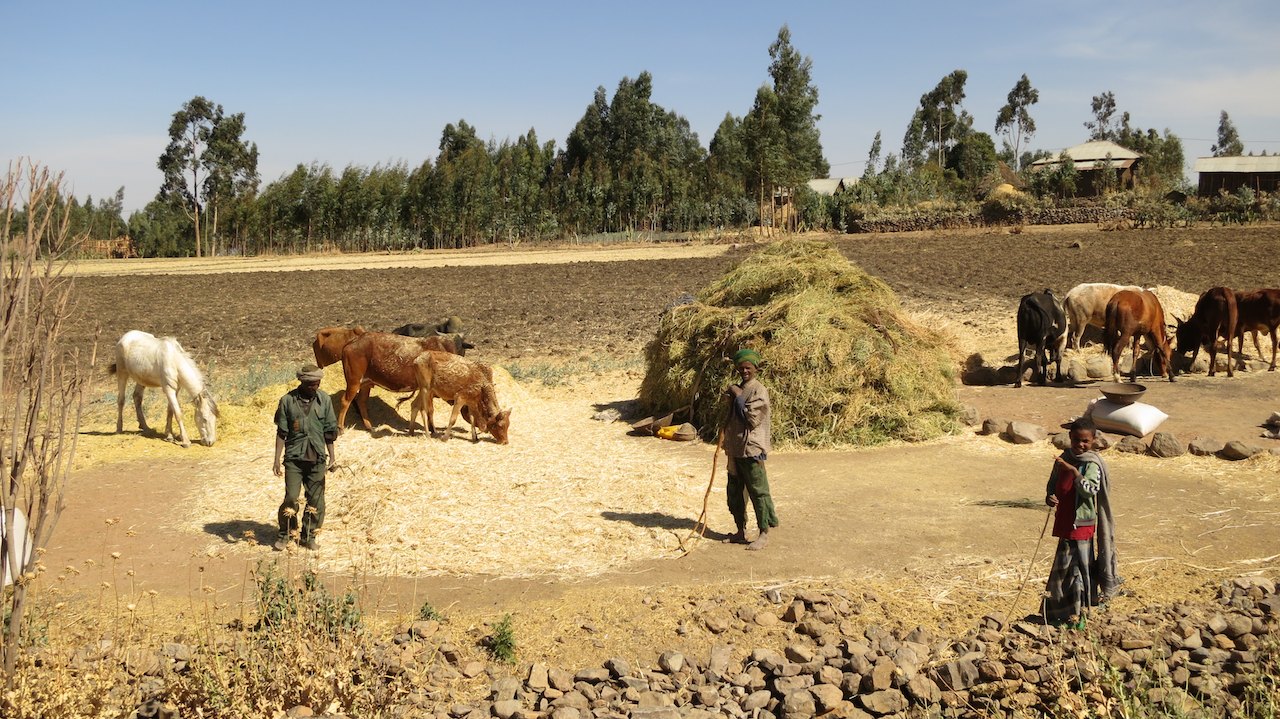
Once we are out of town we immediately drive on a beautiful road in the hills. What is striking is that virtually every piece of land is cultivated. On steep slopes terraces are made to grow different crops. There was not much rain lately, so the fields are dry and yellow. From the high road, we look down on a yellow patchwork blanket. It is really beautiful. Behind every corner lurks another view.

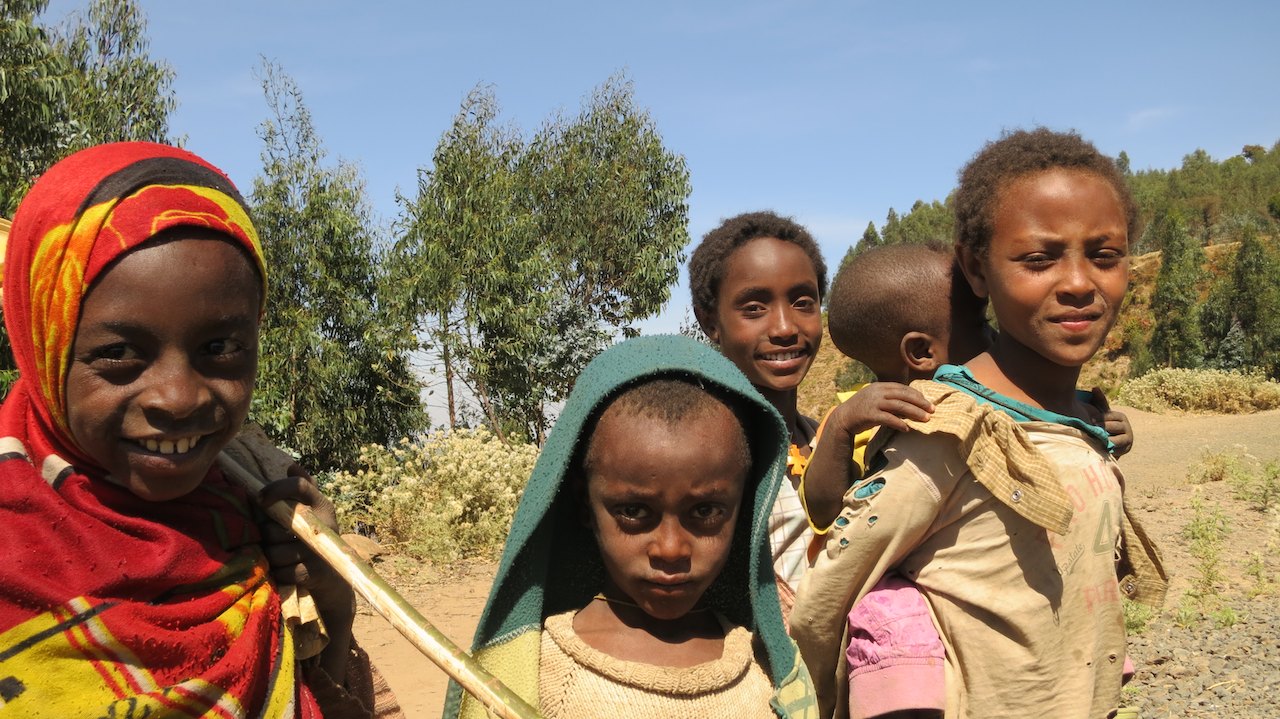
We stop very often to take pictures and look at the views. And while we often think we are alone, this never turns out to be the case. Every time we switch of the engines, we hear someone shouting in the distance: “ You, you, you, Faranji“. Before we know it there are a number of spectators around us who watch us while we are taking pictures, drinking or are trying to eat a banana. The latter is quit hard if you have a group of children with hungry eyes around you that have one hand to their mouth to indicate they would like something to eat or drink as well.
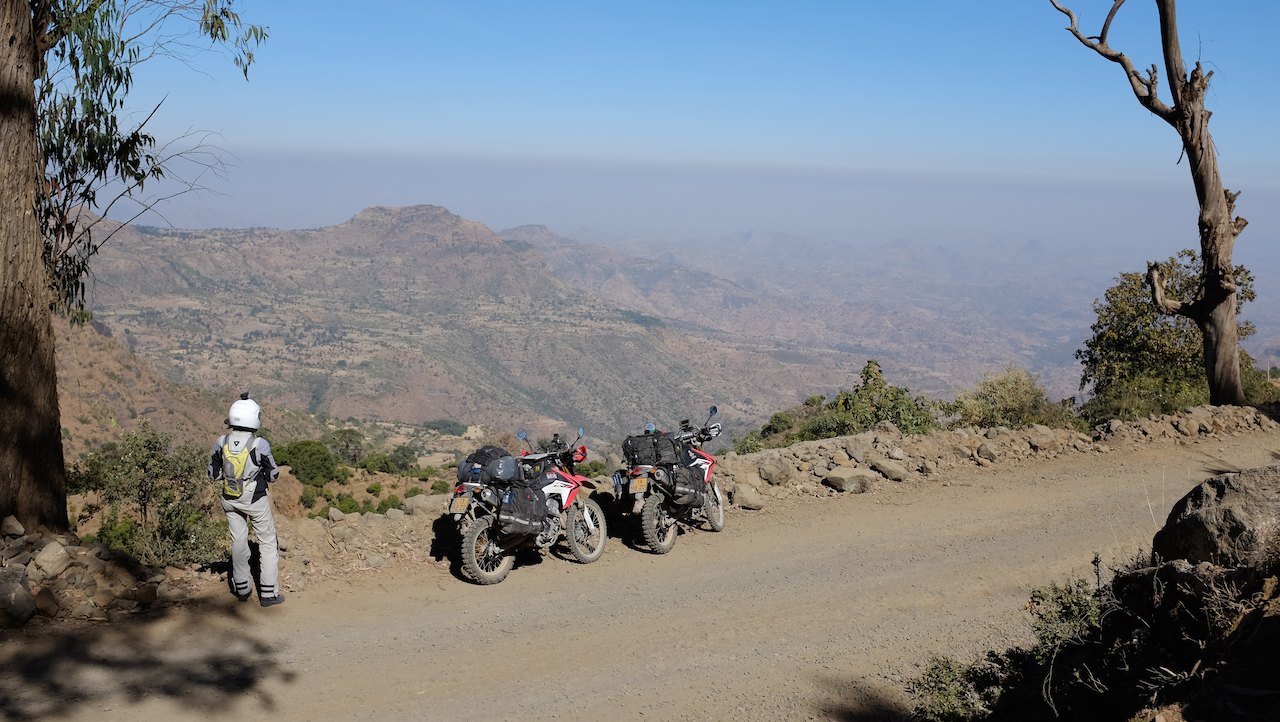

At dusk we arrive in Debark. The town is situated at 2800 meters altitude and is the starting point for hikes in Simien Mountains National Park. For the first time since a long time we see a lot of tourists and tour groups. It is so busy that the first three hotels we go to are full, even camping is not possible. We eventually find a single room with a large cozy bed. There is no running water. In the corner of the tiny little bathroom is a big bucket of water to wash and to flush the toilet. Despite the fact that we sleep in one of the better hotels in the town, it still feels a bit like bush camping.
We decide not to go hiking in the Simien Mountains, because we are both not really in shape and not used to the high altitude yet. We decide to drive to Axum the next day. We attempt to fill our tanks again at the fuel station in town, but are soon told that we can only get fuel in Axum, the next big town. Even on the black market in Debark there is no fuel. With our extra jerrycan of fuel we should be able to make it to the next pump in Axum.
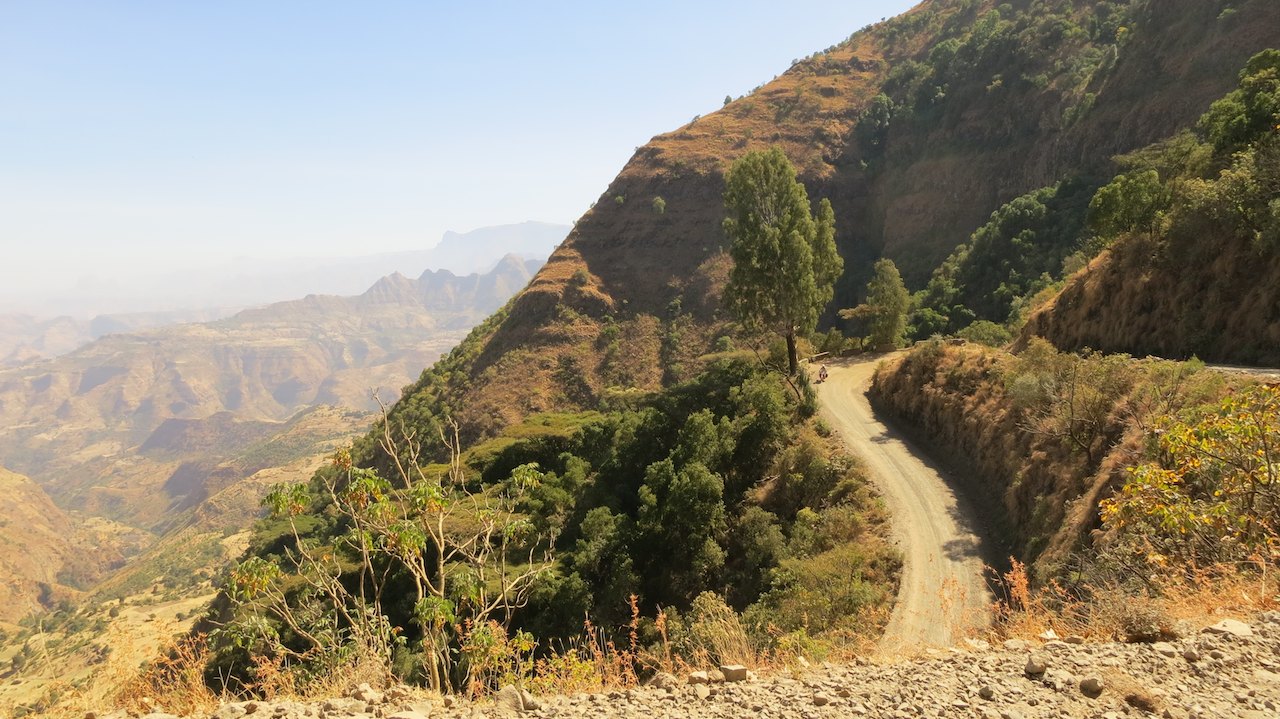
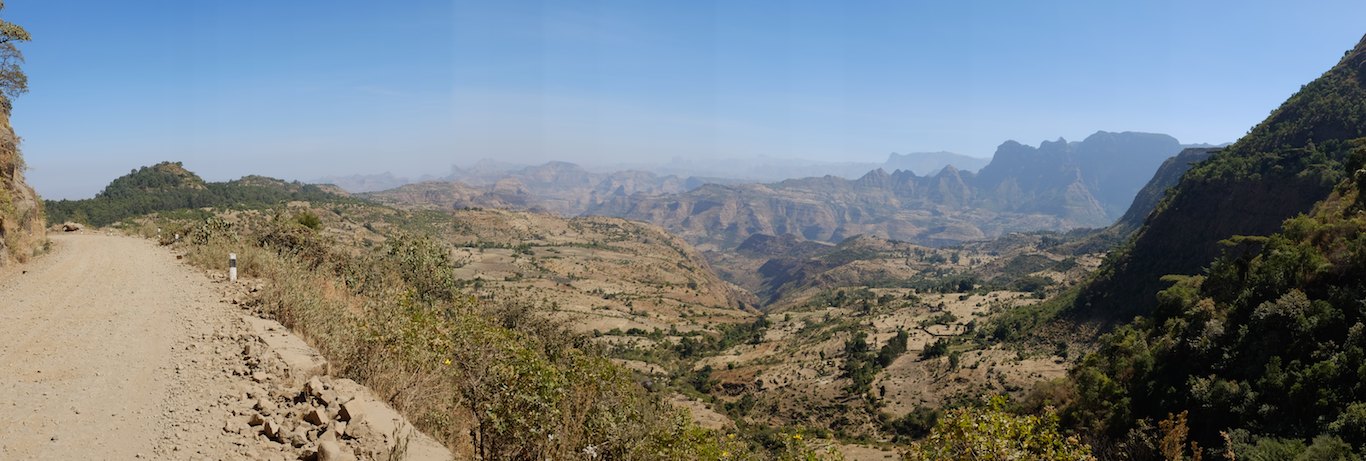
Once we leave the village, we also leave the asphalt road and ride on a nice gravel road. In some parts the gravel is very deep. It makes the bikes ’dance’, but overall it is not very hard to ride here. Though we are standing still more than we are riding, because it is so beautiful. We often stop to take pictures. The views, steep cliffs and the shapes of the hills are very impressive. The only traffic we encounter are coaches that ride slowly up the mountain and then roll down the hills at high speed. Behind the each bus is a huge cloud of dust. So much dust that we cannot see a thing anymore and have to stop to avoid that we would drive off the road.
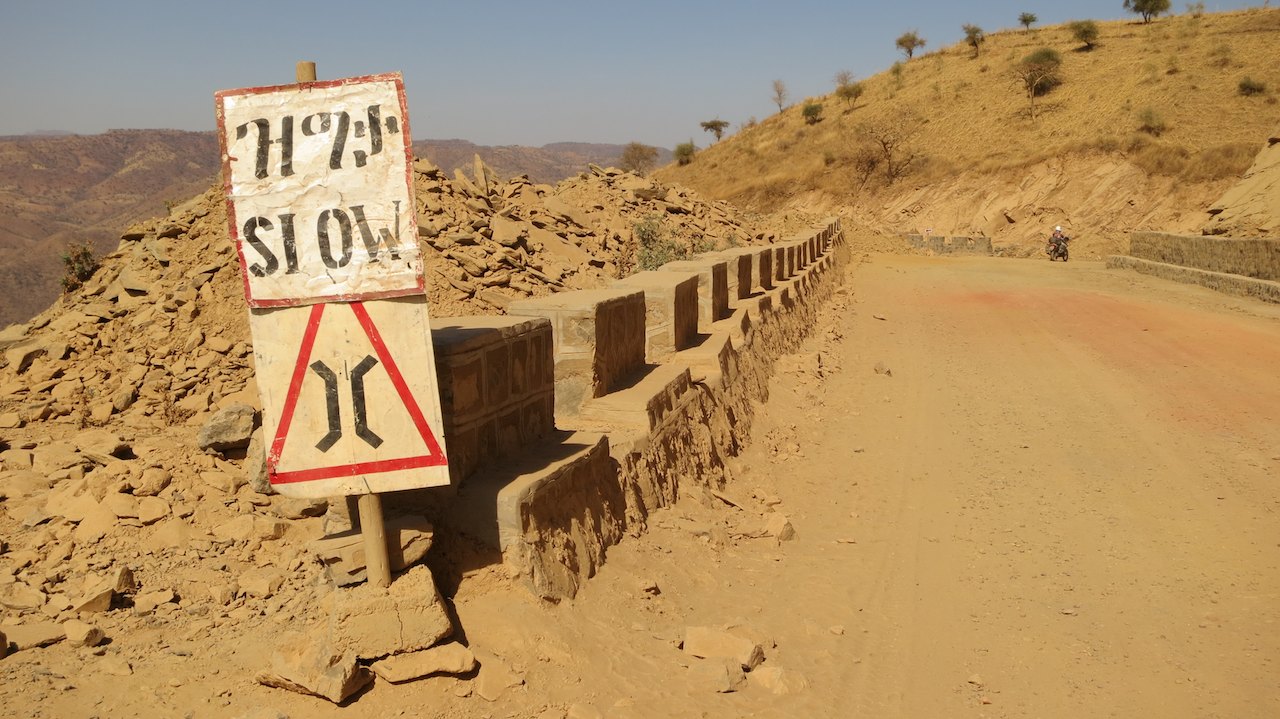
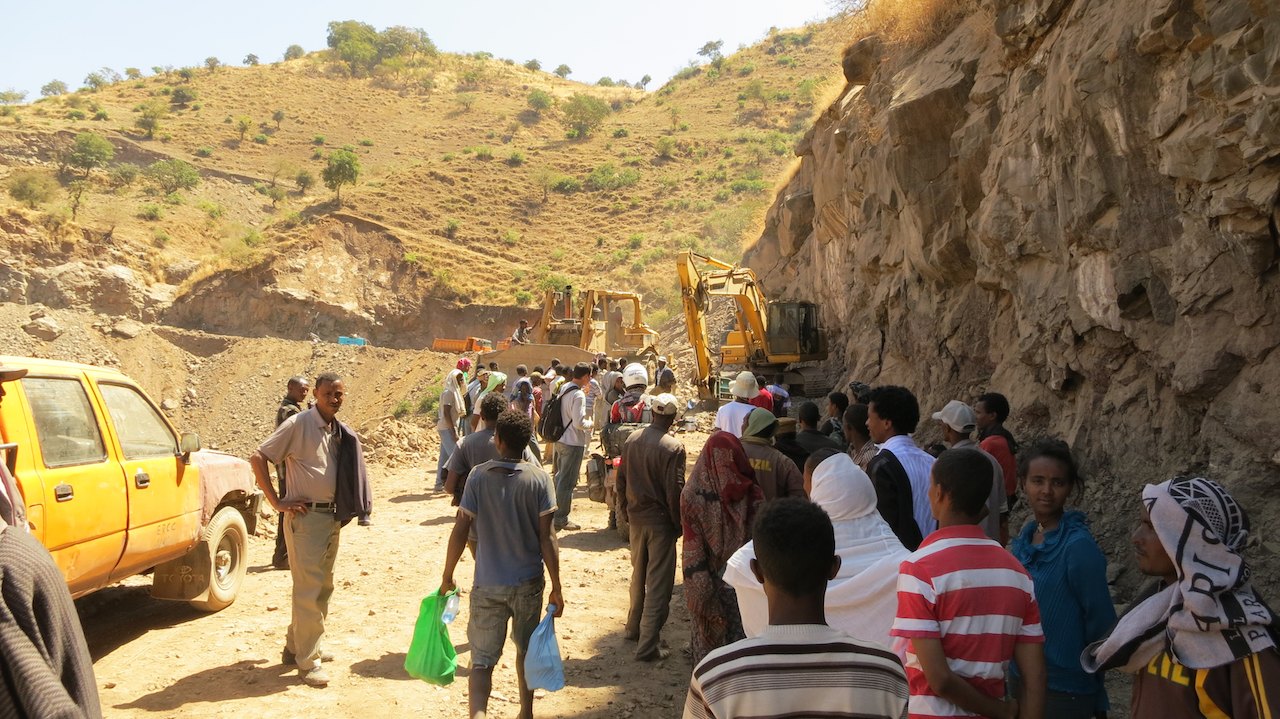
Halfway through the day we run into a traffic jam. Along the entire route there are road works. As in Sudan, the Chinese also build new roads in Ethiopia. With local workers, they cut out the mountains and smooth the gravel to pour a layer of asphalt on it. The traffic jam is caused by two large machines that are drilling out the mountain to make the road slightly wider. No luxury, because it was not wide enough for two buses to pass at the same time. We ride our bikes along the long line of waiting cars until we cannot go any further and join the other spectators. Between all Ethiopians is one “Faranji”, Brian from the U.S. He is backpacking through Ehtiopia and is on the bus to Axum. He has been here for several hours to wait until the road reopens. While we are talking to him, one of the machines moves and the workers gesture that we can ride our bikes along the road works. We say goodbye to Brian, maneuvering past the machines and continue our way up north. For now without any busses or dust in front of us.
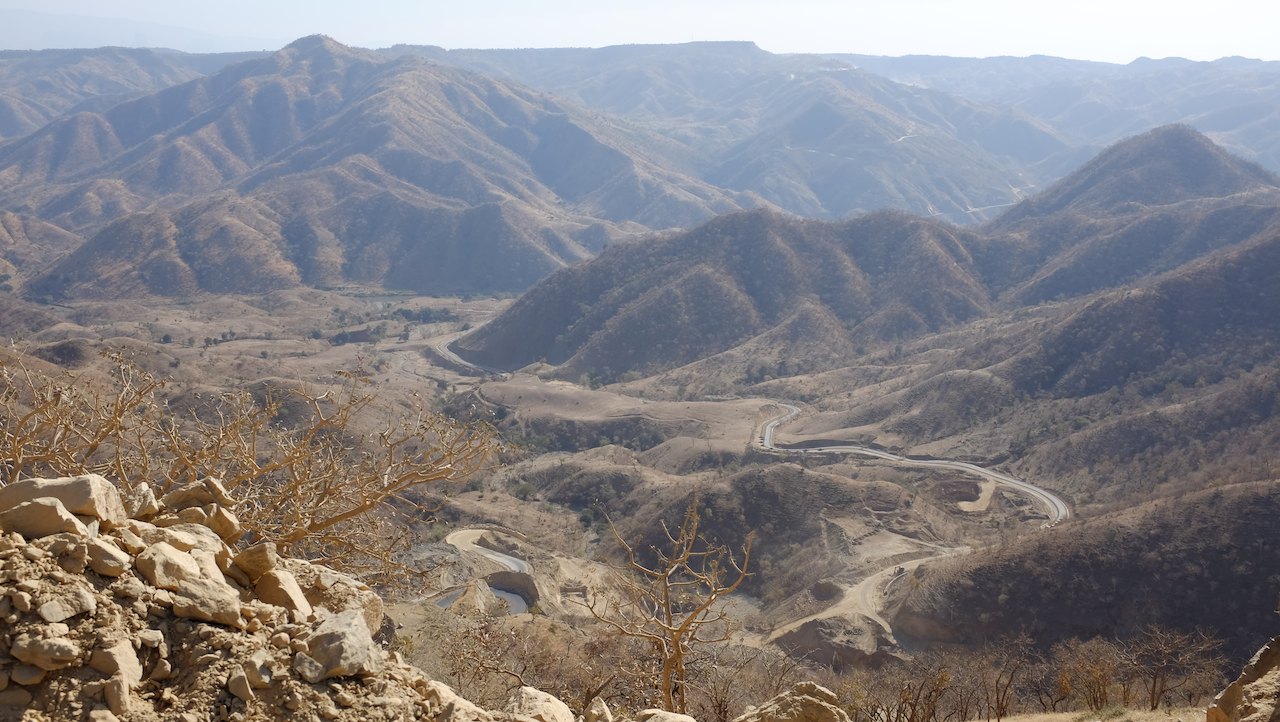
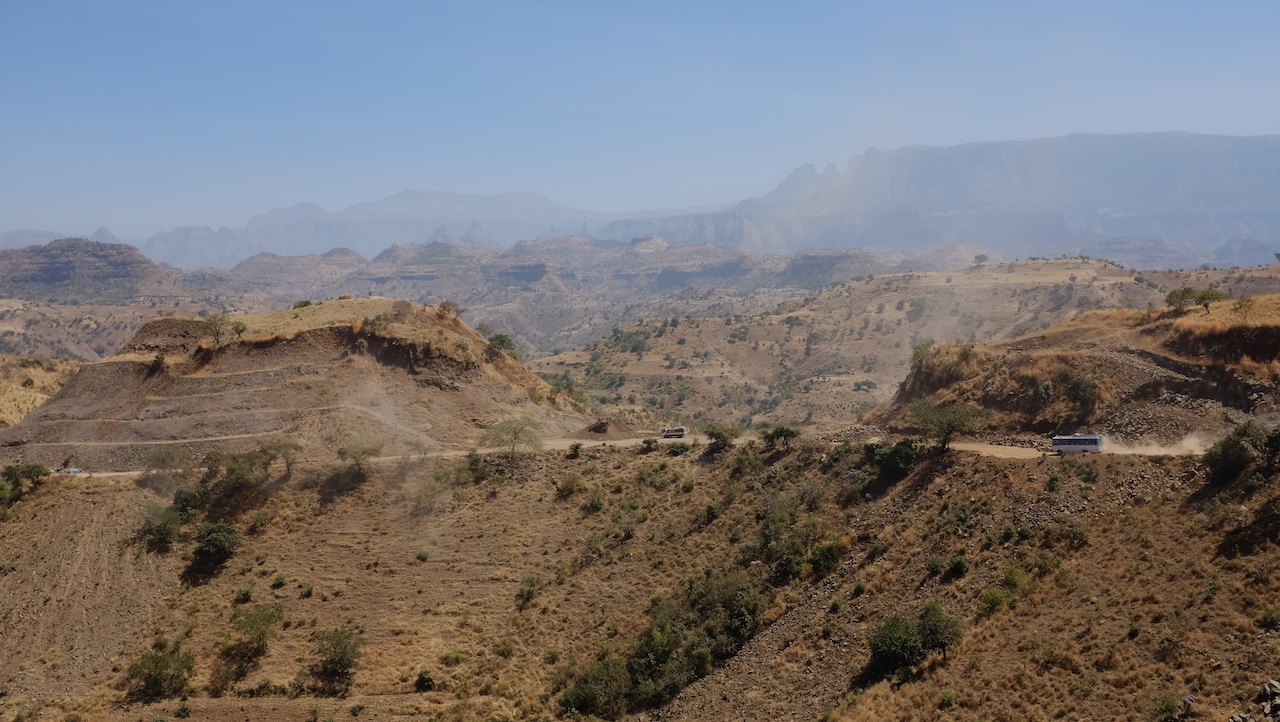
If after a few kilometers we look back, we see that the road is open again and the busses are in hot pursuit. While we stop for a sandwich the first bus and its dust overtakes us. After lunch we take over the bus again, but each time we stop to take a picture, we are caught up and have to overtake them again afterwards to avoid the dust. This ritual is repeated several times, until we arrive at the tarmac in Shire. In the last sunlight we drive from Shire to Axum, where we check in at the Africa Hotel. When I look in the mirror, I see my face is black with dust. I did not only drive in the dust of the buses, but also more than 200km in the dust of Peter who drove in front of me. Fortunately the showers at the Africa Hotel do have water!

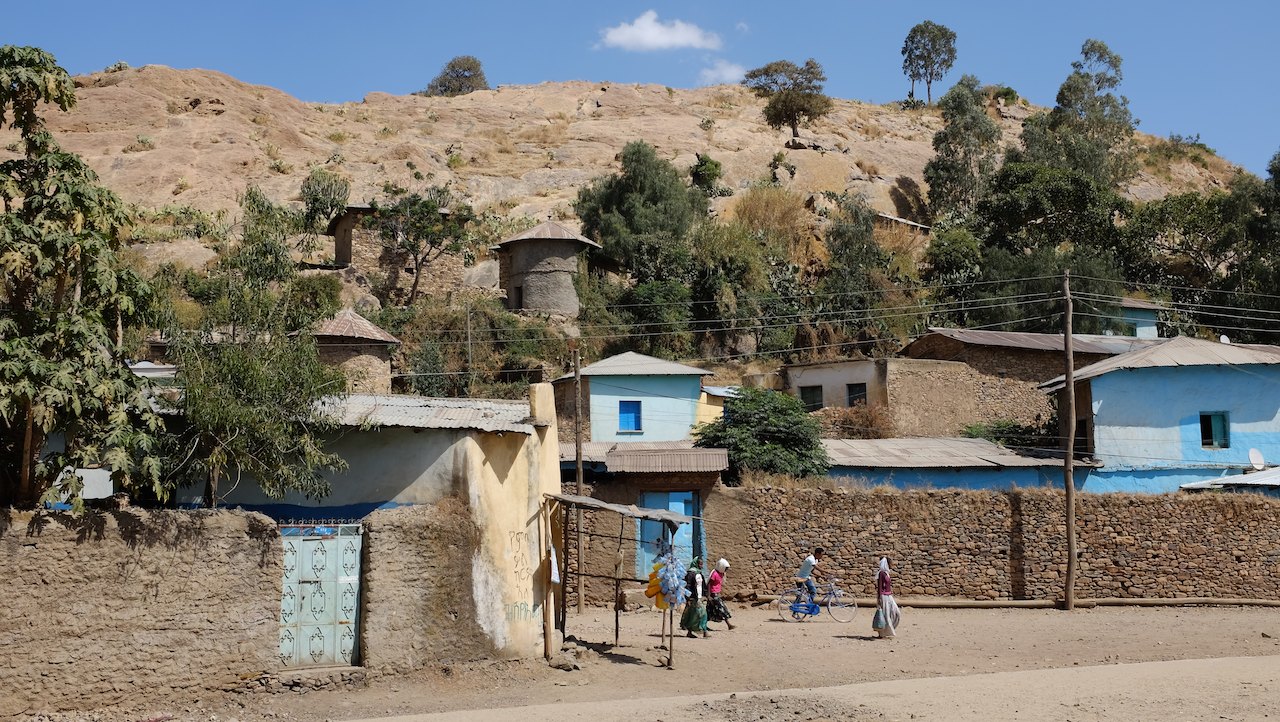
When we go to the centre of Axum the next morning, we walk past another ETC office, recognizable by the blue phone booths on the street. We decide to have the dongle checked once again. Like in Gonder, it is very busy in the office with people buying phones. When it is my turn, and I explain our problem, the man behind the desk looks at me with a stern face. He takes our problem very serious and apologizes on behalf of ETC for the poor service. He will personally investigate my dongle and if necessary contact his colleagues in Addis Ababa. He writes down all data and promises to call as soon as he knows more. Meanwhile, I should visit the city, as waiting would only be a waste of my time.
We follow his advice and visit the one attraction of Axum: the pillars of Axum. In the town, as well in its surroundings, several field with stone pillars can be found. The pillars were built around 400 ac as tomb stones. In Axum itself three pillars can be visited. One of the pillars has been in Rome for a long time, but some years ago the Italians gave it back to Ethiopia. At the gate we buy a ticket, that is handwritten by the men behind the counter.
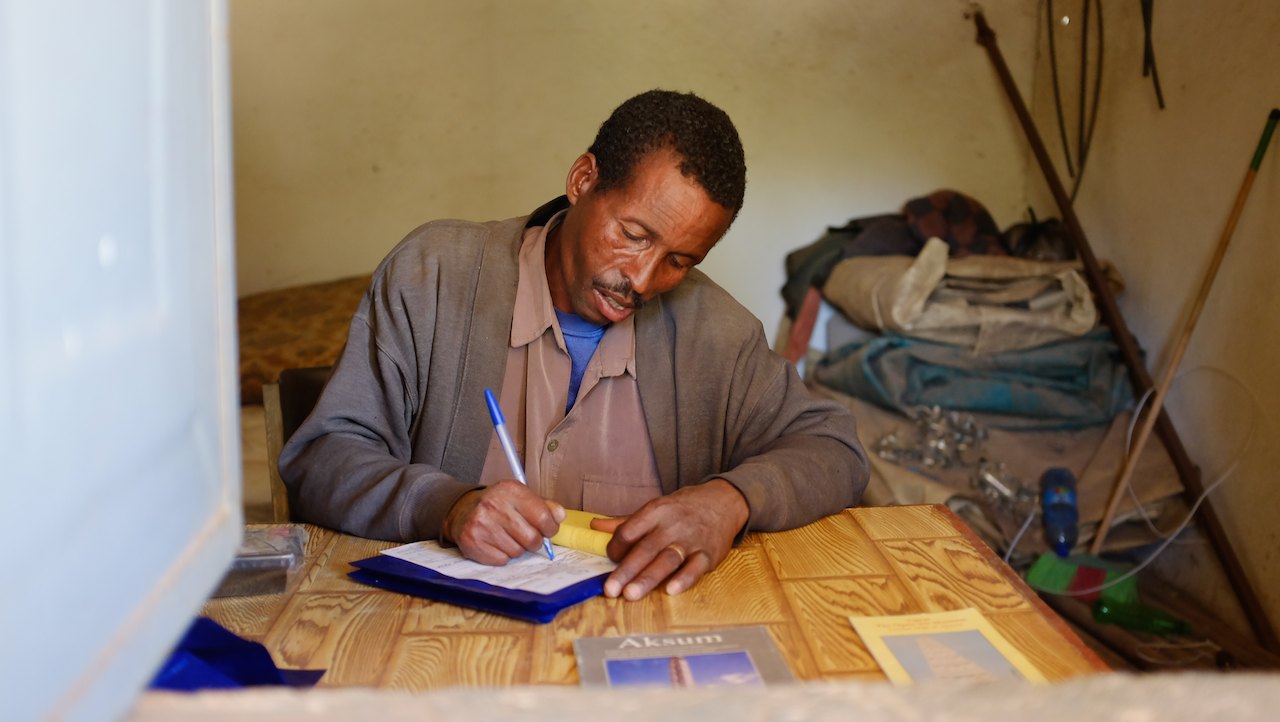
At the foot of the pillars we bump into Brian again. The roadworks took so long that his bus did not go all the way to Axum. He had to stay the night in Shire and had taken a very early bus to Axum that morning. Brian advises us to go to the cattle market in Axum. It is market day today and farmers have taken their animals to the market. A good idea to visit the market! We say goodbye to Brian and agree to meet for dinner that evening.
To go to the market, we hold down a tuktuk and negotiate the price. Just when we want to get in, it appears there is already someone sitting in the back of the tuktuk. We assume that the other passenger will be dropped off and that we drive to the cattle market after that, so we get in the tuktuk anyway. The cattle market is a little out of town. The road is very bad and we are bouncing in the back of the tuktuk. When we arrive at the market area it is completely empty. No cows, no sheep, no goats or even a chicken to be seen. We are too late and just see the last farmer with his cattle disappear over a hill in the distance. Unlucky.
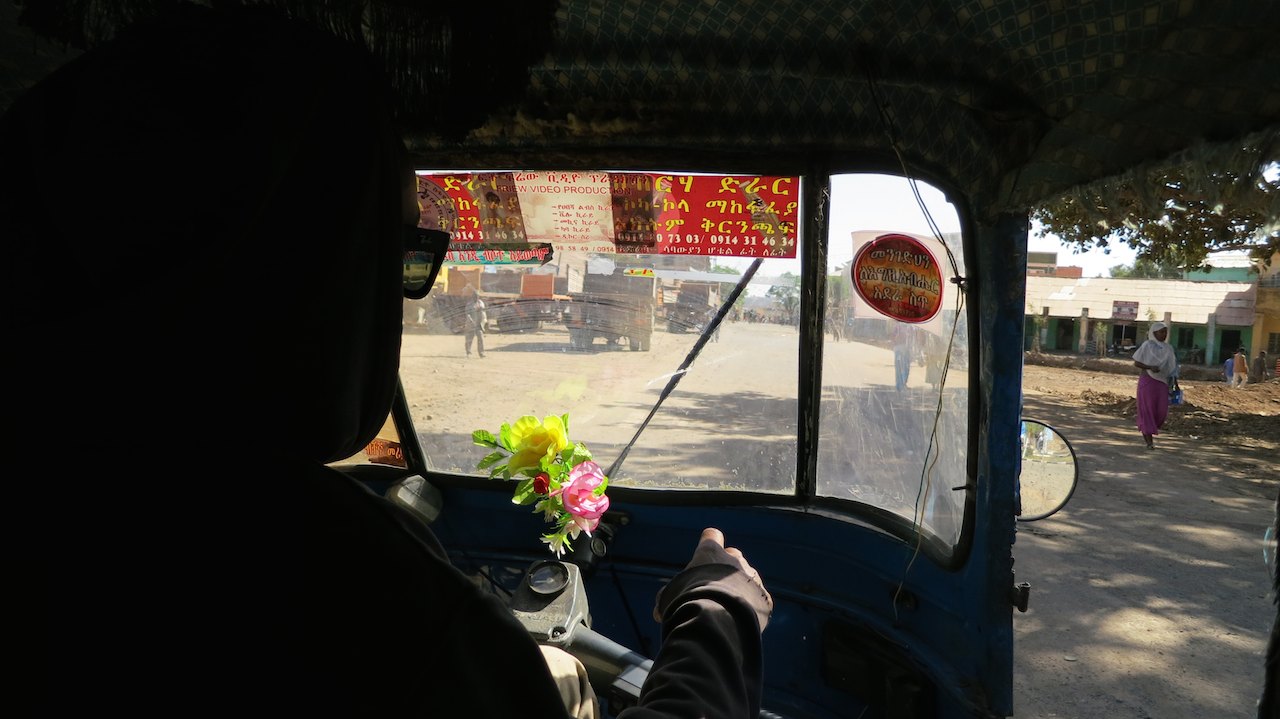
We ride back over the same bumpy road as Peter suddenly shouts: “ GET YOUR HANDS OUT OF MY POCKET! That man tries to pickpocket me!” While we were tossed around the tuktuk the third passenger had put his hand in Peters pocket. Peter had initially not noticed. Only when he accidentally stuck his hand in his pocket he felt the hand of the other guy! Angry, Peter begins to check his pockets. It turns out that one pocket -the one with the zipper- is empty. The camera batteries and SD cards are gone.
Peter yells and says the man must give him back his stuff and searches the man. The door of the tuk-tuk is on my side, so long as we do not get out, the crook can get nowhere either. While the man is getting smaller and moans that he has nothing, Peter demands the driver to go to the police. Then the man in the back starts to moan louder and points to the ground. Maybe the stuff has “fallen”? We indeed find the missing items on the floor. After we have checked all our stuff three times, we get out of the tuktuk. The thief runs away. A little confused we have the chauffeur take us to the hotel where we pay him. Once inside we realize that the driver was probably in on it. If we had realized that before, we would certainly not have paid him. We were not so streetwise yet. Fortunately, we still have all our stuff.

At the beginning of the evening we meet Brian and walk to a restaurant in the center of the town. We enjoy a cold  and injera, the national dish of Ethiopia. Injera is a pancake made of teff flour, a cereal that is grown only in Ethiopia. The injera itself is not so good and really only good to eat together with the sauce. You eat injera with your hands (only with your ’clean’ right hand and never with your left hand), by tearing off a piece of injera and taking a bit of sauce with that. It is so common to eat with your hands that you do not even get cutlery. In North Africa, we had already learned to eat without cutlery, so we now have no problems to eat injera. Ethiopians eat injera throughout the day, at breakfast , lunch and dinner. A day no injera is a day wasted. We stick to one injera per day, Bozena Shiro is our favorite.
After the nasty tuktuk ride, it is ultimately a very nice evening with Brian. He tells us about his trip (14 days in Ethiopia, Djibouti and Somaliland), about his work in San Diego and the time he worked as a volunteer in Mongolia. He also wants to know everything about our adventure. At the end of the evening he is fantasizing about which motorbike he could do a similar journey. He tells us about “The True Size of Africa”. Most of the “flat” world maps give a distorted picture of the true size of countries, especially those on the equator. In reality, the African continent is so big that if fits the U.S., China, India, Japan and Europe and then there is still space left! No wonder it takes us so long to cross this beautiful continent.
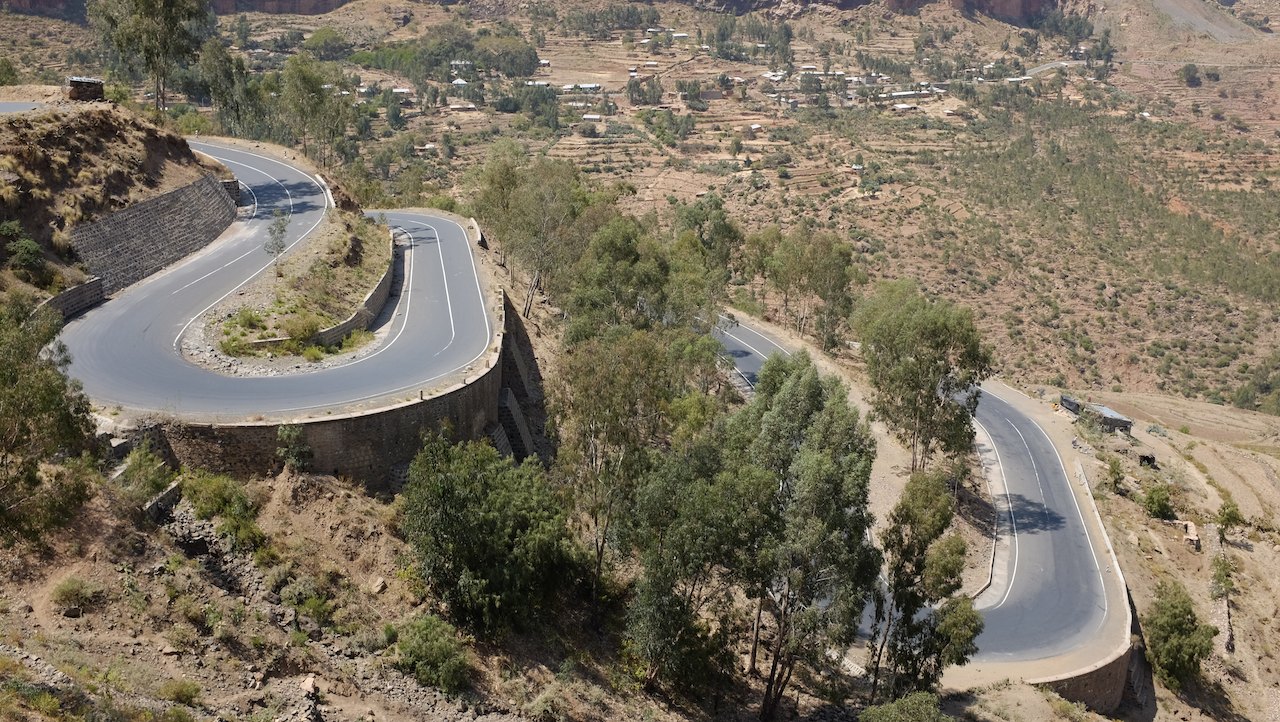
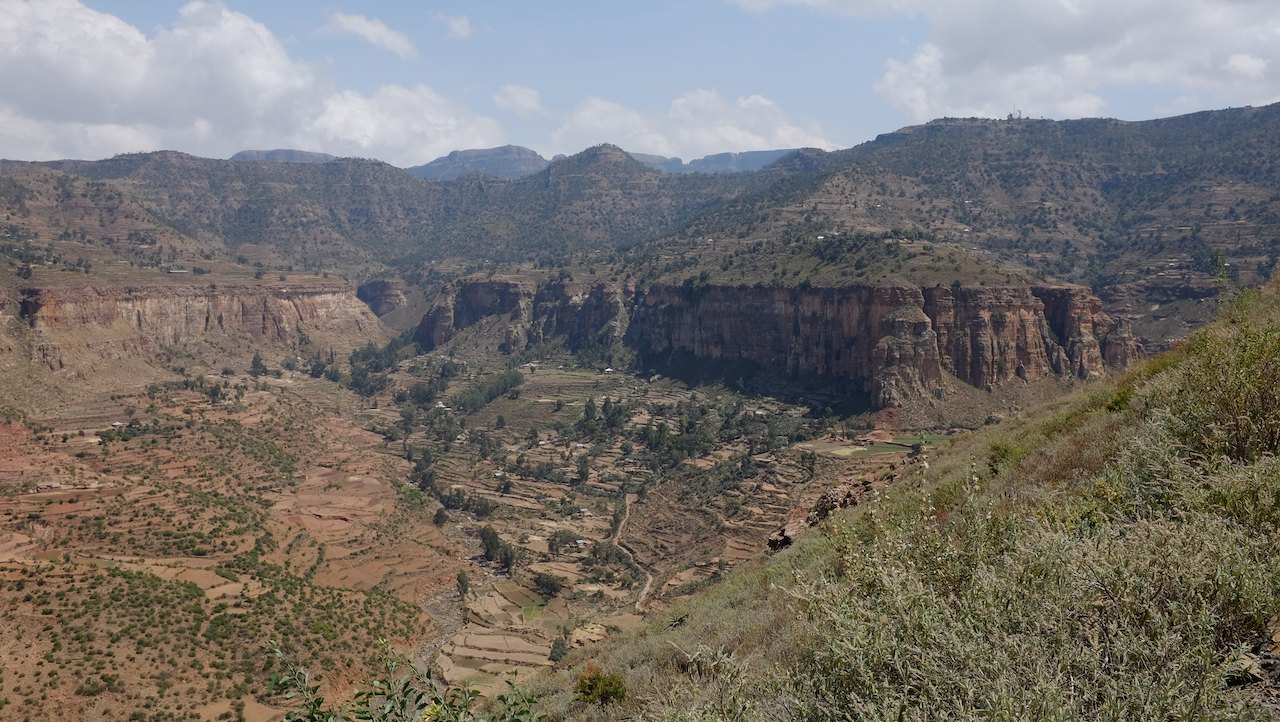
The next morning we sit quietly at breakfast when my phone rings. It is the gentleman of ETC who would check our dongle. As in Gonder, he concludes that the dongle works fine, but the network is down. He feels very bad, but has a solution. He is now outside our hotel with a sim card with which we can get on the Internet. The Internet will not be as fast as with the dongle, but it will work. I hurry outside. He wants to give me the simcard for free, but that really is not necessary. What a service! And that on a Sunday! We really went out of his ways to help us! And he was right, with the sim card he gave us we did manage to get on the internet. The remainder of the day we use it to read our emails and update the blog (which in the meantime was about time).
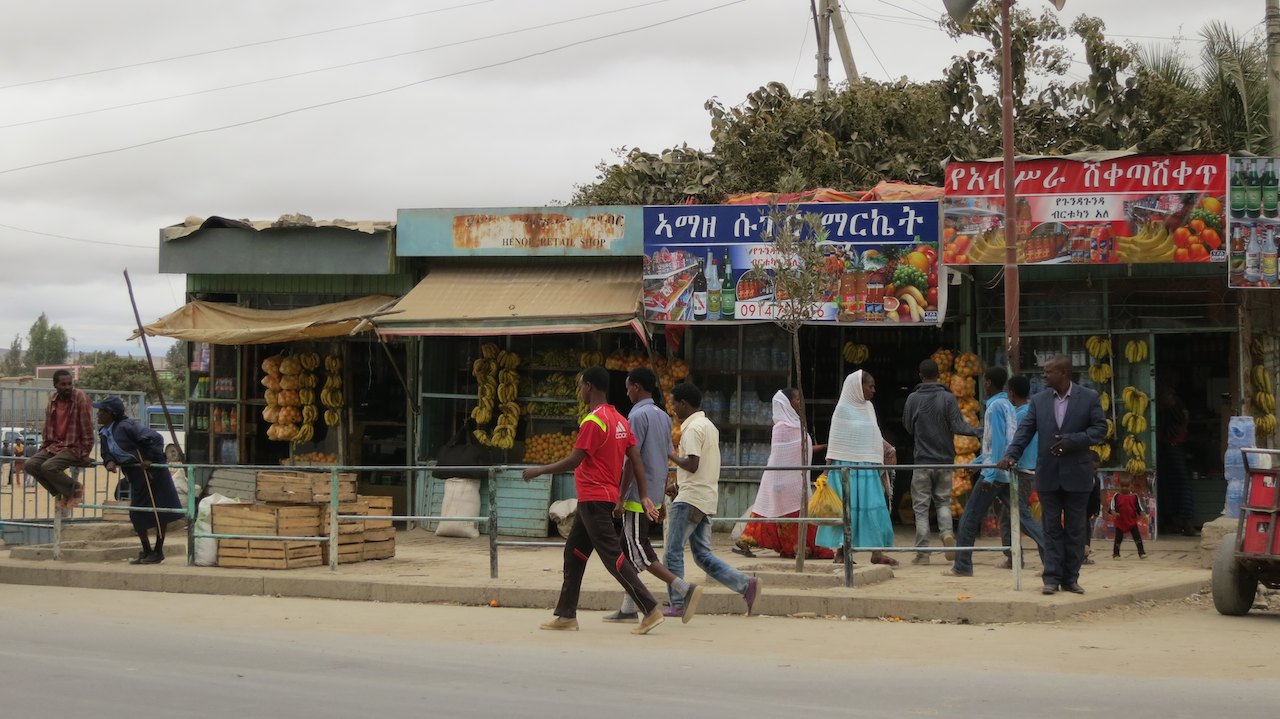
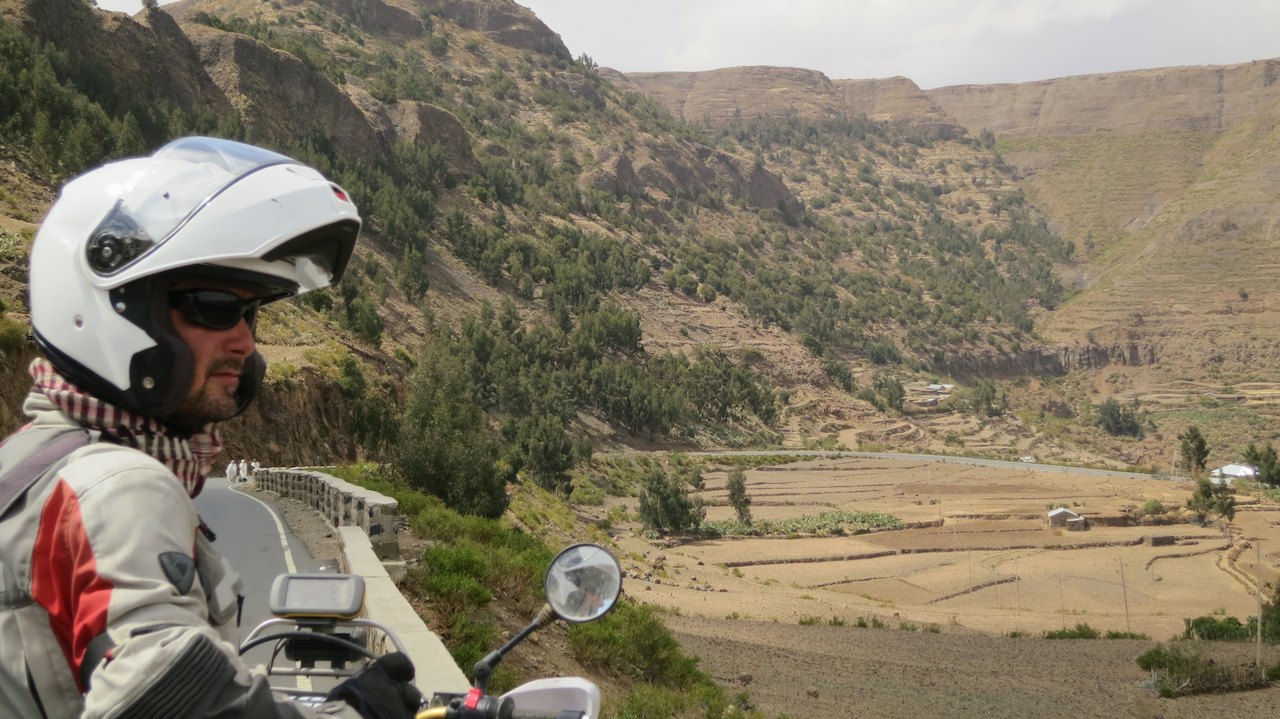
After a relaxed Sunday, we drive to Wukro on Monday to visit a rock church there. In the northern province of Tigray are more than 120 rock churches. The churches are carved into the rock and often beautifully painted. Most rock churches are very difficult to reach because they are carved into a steep cliff or hidden in a cave. Some churches may only be visited by men or by practicing Christians. The local priest determines -sometimes after an interview- whether you are allowed to visit the church. The rock church in Wukro can be accessed from the village and is open to both of us. On the way to Wukro we see a lot more colourful churches scattered in the landscape. Often on top of a hill, visible from far away. When we arrive in Wukro we are too late to visit the church, but we eventually go there the next morning. It is a small church with some beautiful paintings. A nice preview of what we can expect in Lalibela.
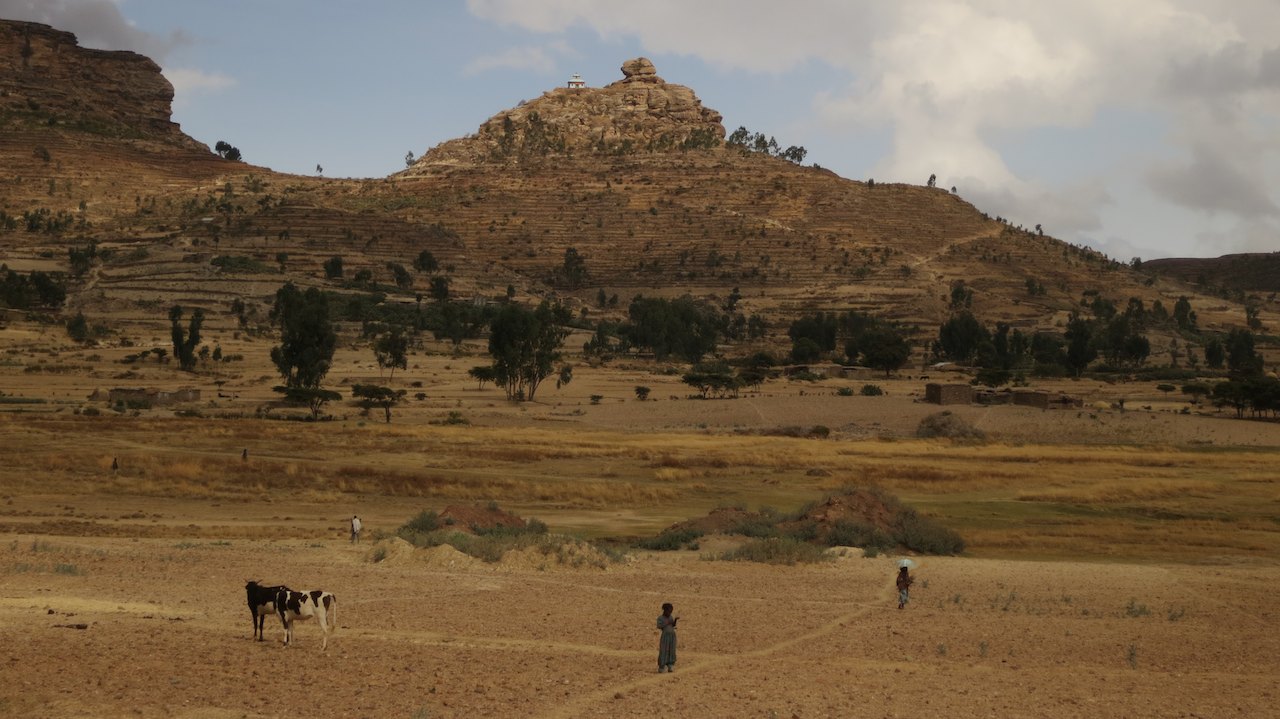
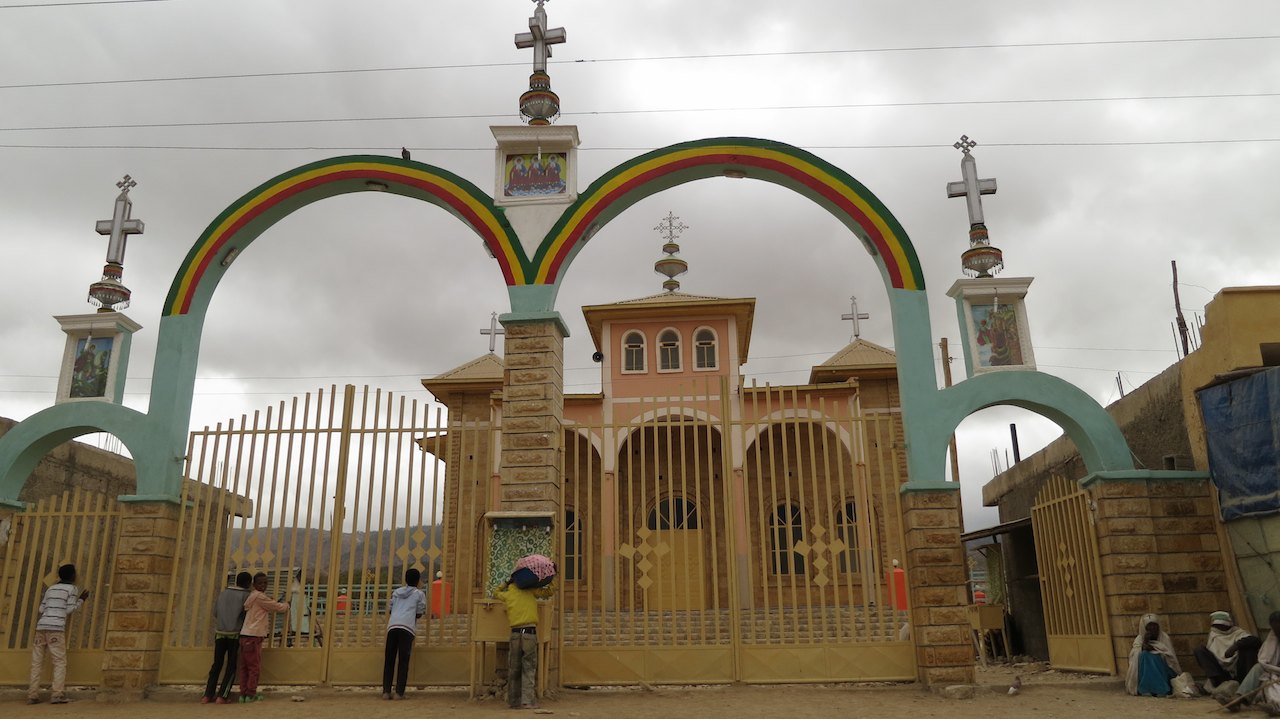
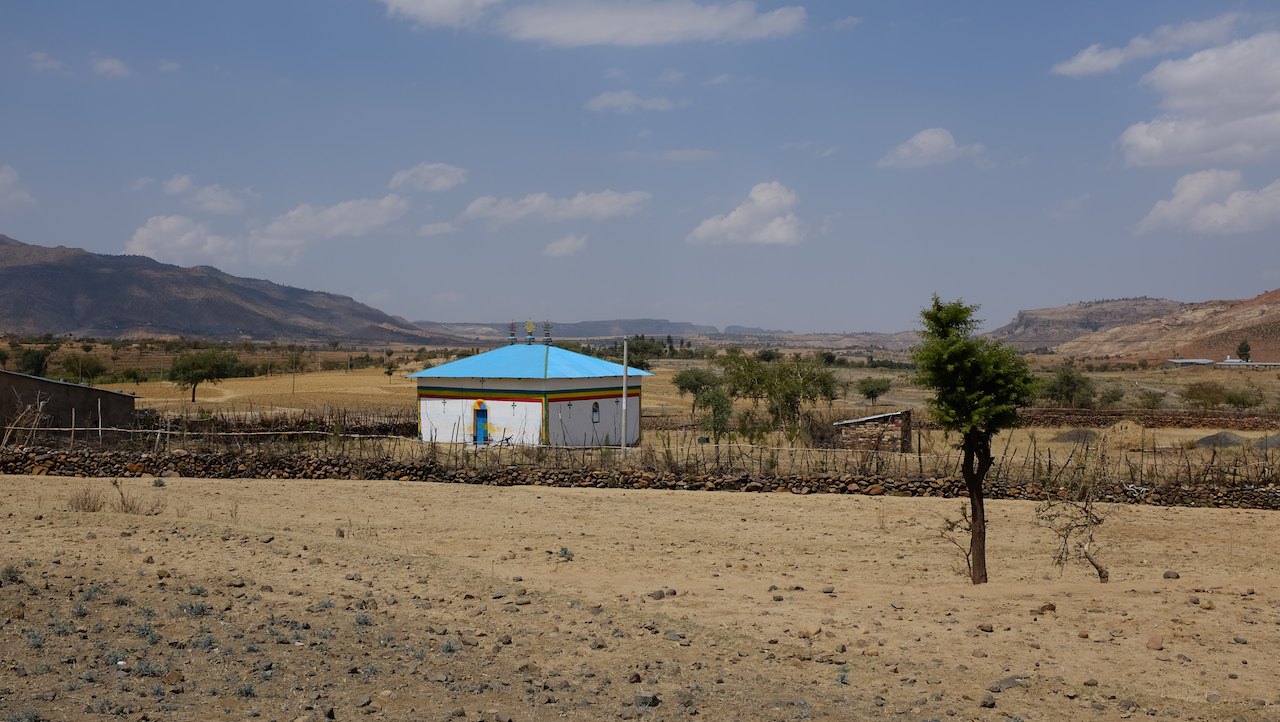
After our visit to the church in Wukro we drive to Mekele where we are invited by Kevin and Els and their children Jotan and Moshe. We met this Belgian family at Tim & Kim Village where they were on holiday with their sister (in law) Becky. They live in Ethiopia for several months now and work at the Mekele Youth Centre (MYC), a youth centre run by a major mission organization. Kevin is waiting for us in the centre of Mekele. We follow him to their house, park our bikes in the walled garden, put our stuff in Jotans room where we can sleep and then go with the family to a restaurant nearby for a delicious burger!
In the afternoon, Kevin takes us to the MYC where he gives us a tour and introduces us to his colleagues. The MYC is visited daily by about 800 young people from Mekele. Kevin and Els provide workshops in the field of health education. They also guide young people in their everyday problems such as housing, employment and education. A wonderful project and very inspiring to see how committed they are to help the Ethiopian youth.
In the evening we enjoy a lovely meal made by Els, we talk endlessly about their lives in Ethiopia and I fill my time with Jotan and his book about the knights. Great we could visit them!
The next morning, when daily life starts again, Moshe goes to school and Kevin to the MYC. We pack our stuff and start our trip to Lalibela. More about that in a future post.
Distance travelled to Mekele: 10,756km (6,684 miles)
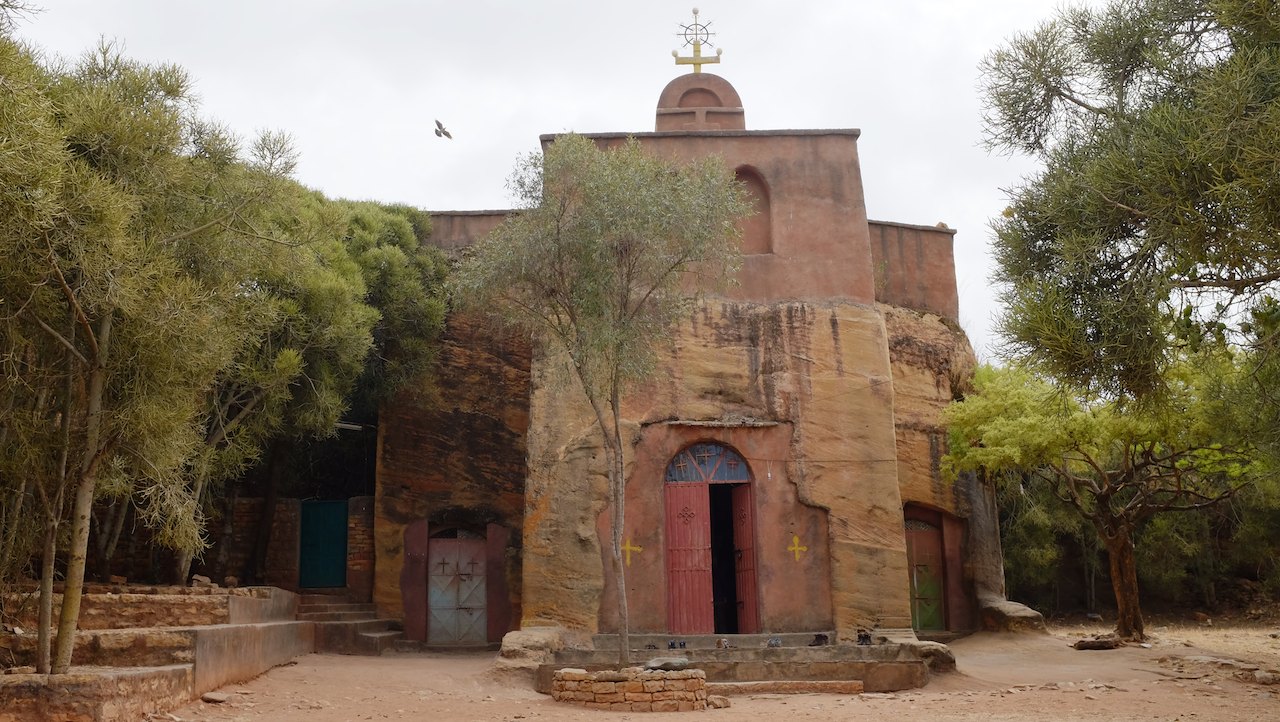
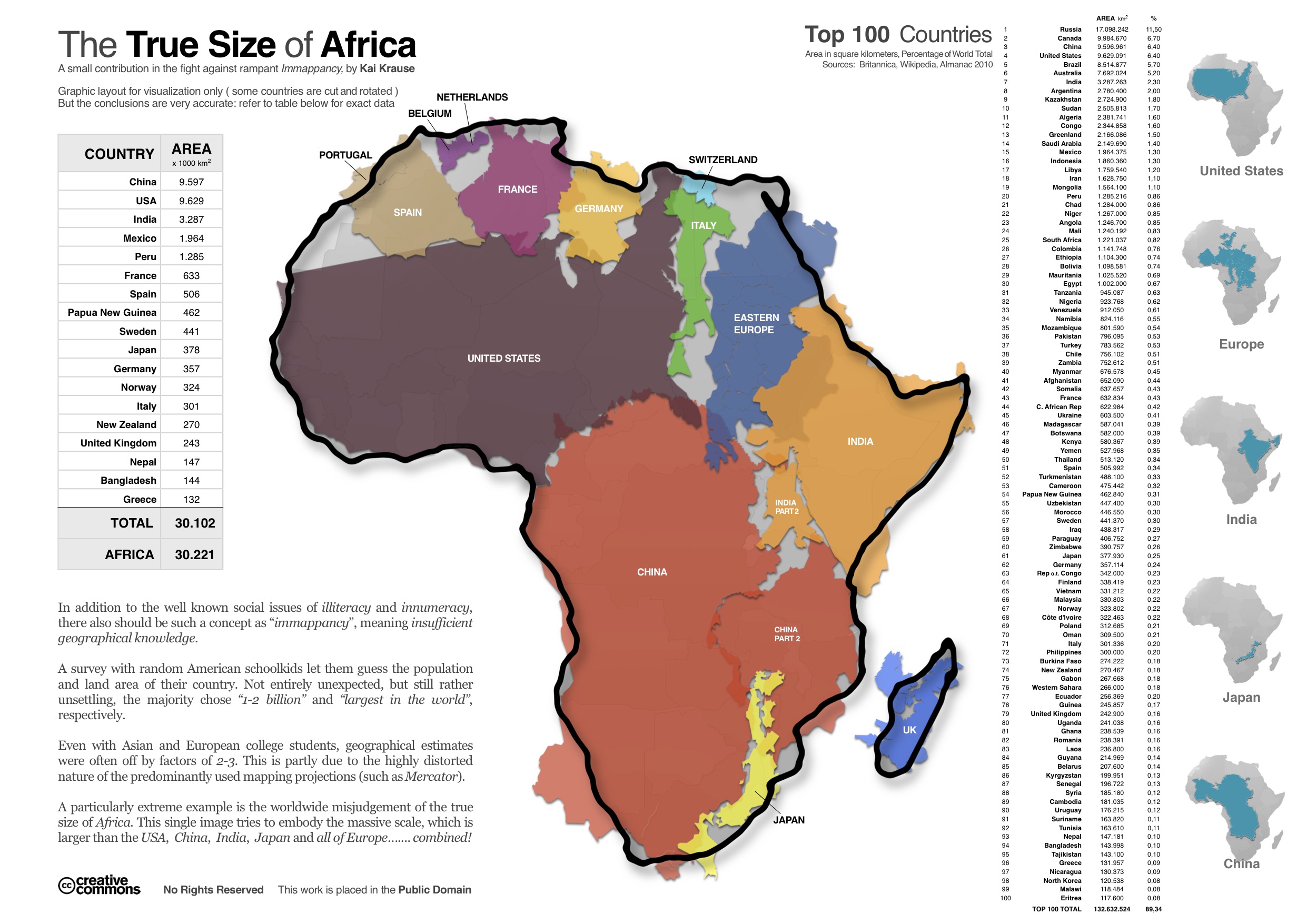
|

29 Dec 2014
|
|
Registered Users
HUBB regular
|
|
Join Date: Dec 2009
Location: The Netherlands
Posts: 66
|
|
|
Rock-hewn churches of Lallibela
In most guidebooks it is listed as one of the highlights of Ethiopia: a visit to the rock-hewn churches of Lalibela. In the small village high in the Ethiopian hills eleven beautiful churches were carved out of the rocks in the 13th century. The village is a place of pilgrimage for the Orthodox Christians in Ethiopia, for tourists a ’must see’. It is a 360km drive from Mekele to Lalibela, a trip that we do in one long day.
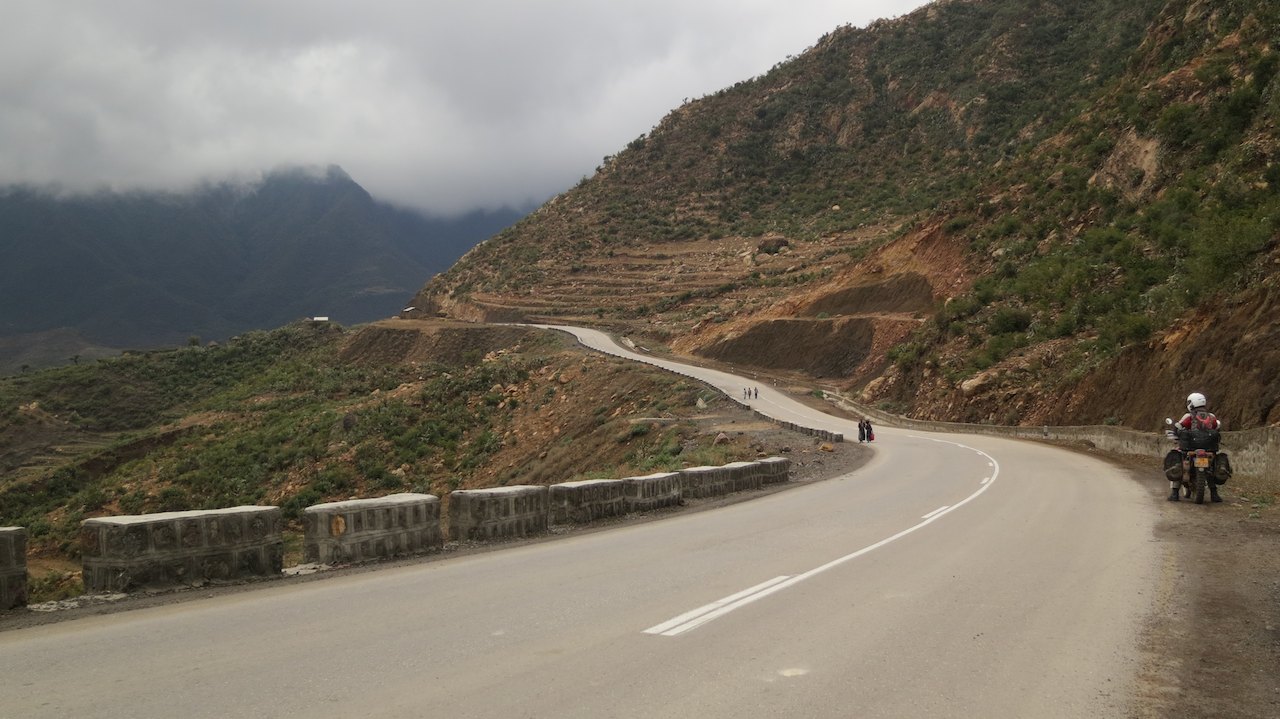
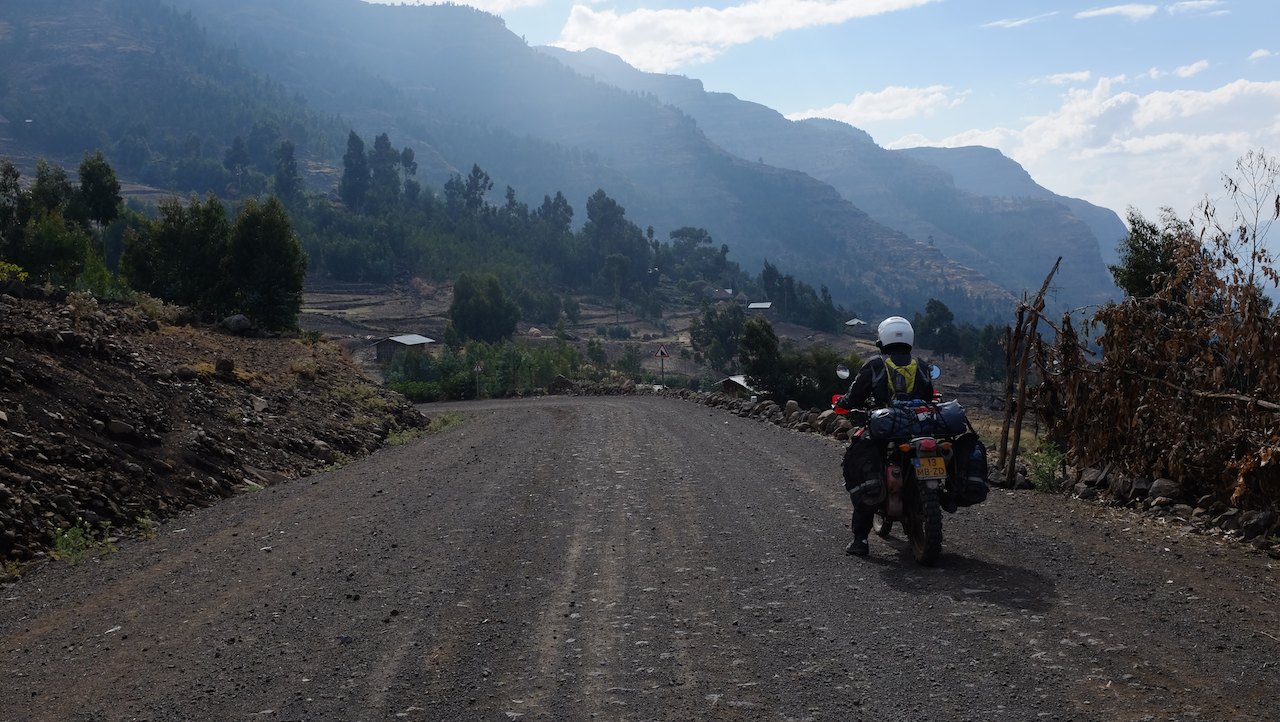
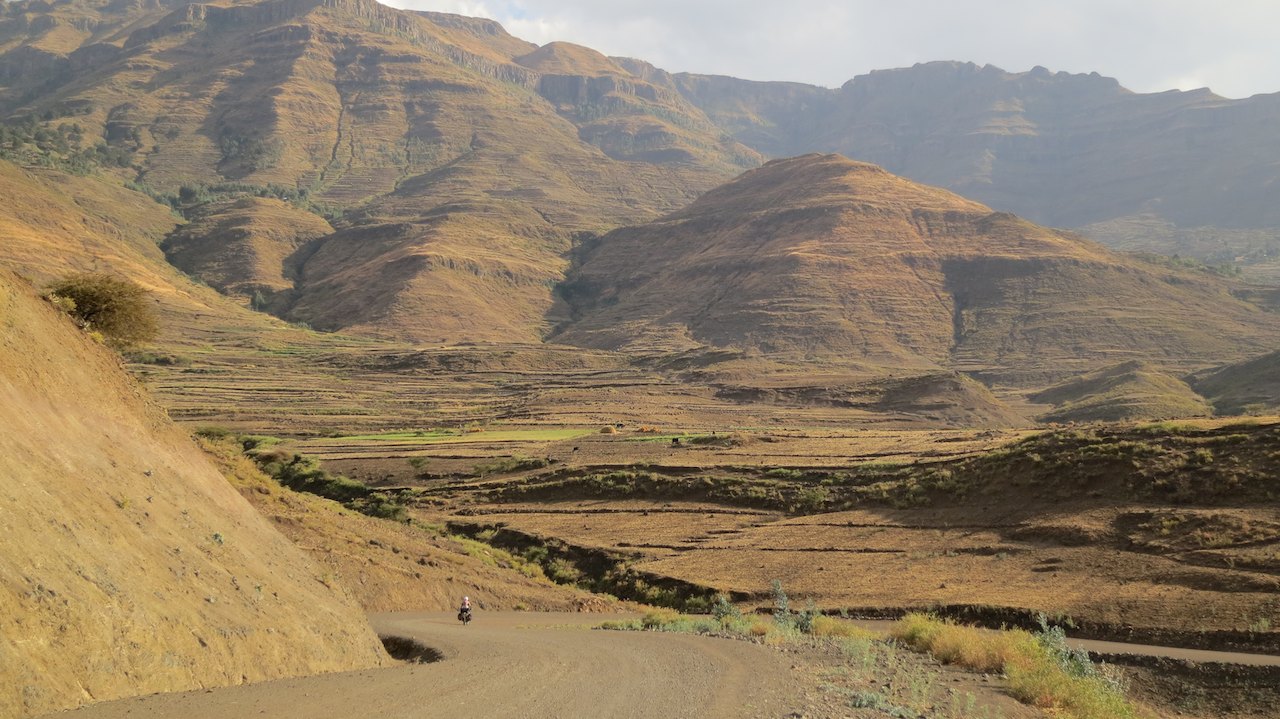

Once we have left the city we ride through the beautiful hills of Ethiopia. After 300km we leave the main road to go to Lalibela following a beautiful back road. The last 60km we drive on a gravel road higher into the hills. The road is in some parts very bad, too bad for cars and trucks. For that reason we do not come across any other traffic. In the villages we pass, we are a true attraction.
Like before, it is beautiful! Very impressive views, especially in the sunlight at the end of the afternoon. After a long day, we arrive in Lalibela where we find a room in “The Seven Olives Hotel”, where we enjoy the best injera bozena shiro of Ethiopia.
The next morning we get up early to visit the churches. At least that is what we thought. As we walk to the motorbikes, we smell fuel. The motorcycles are parked in front of the reception and underneath my bike is a puddle of gasoline. Peter gets out his tools. It soon becomes apparent that the rubber gasket between the fuel tank and the fuel pump is pushed out and does not fit anymore, causing fuel to leak from the tank. We decide to postpone our visit to the churches one day and fix the leakage first.
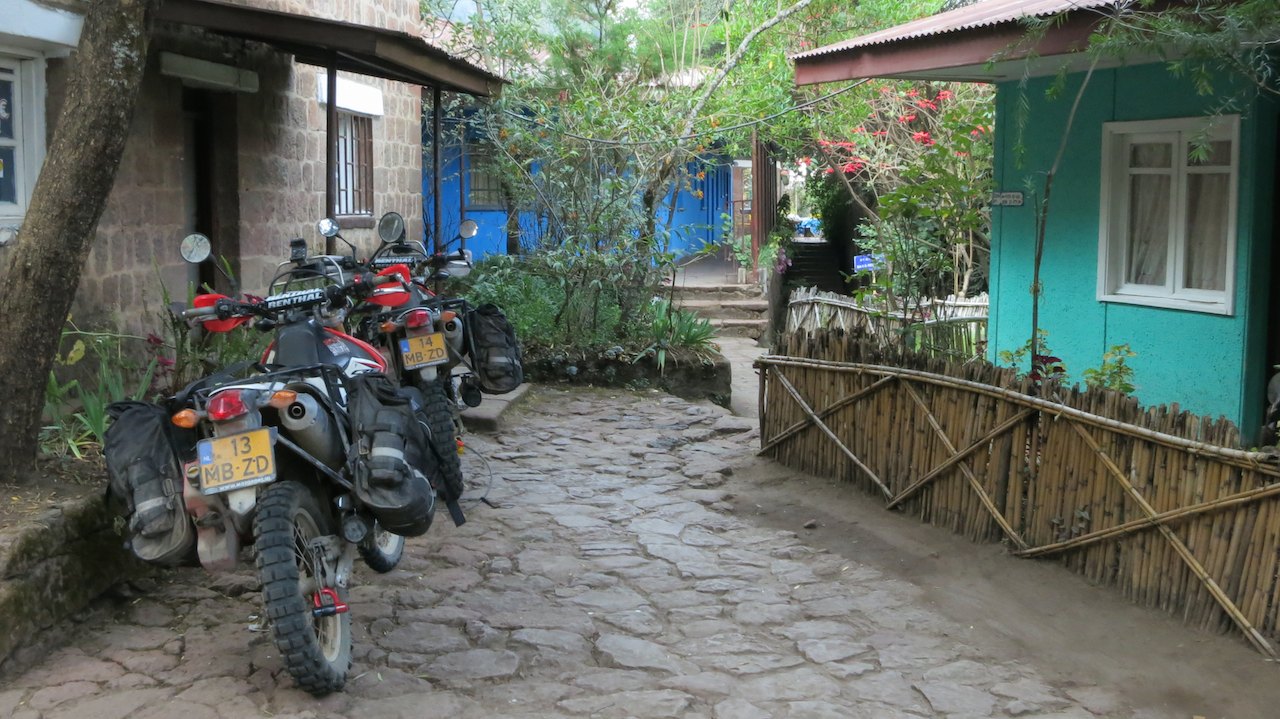
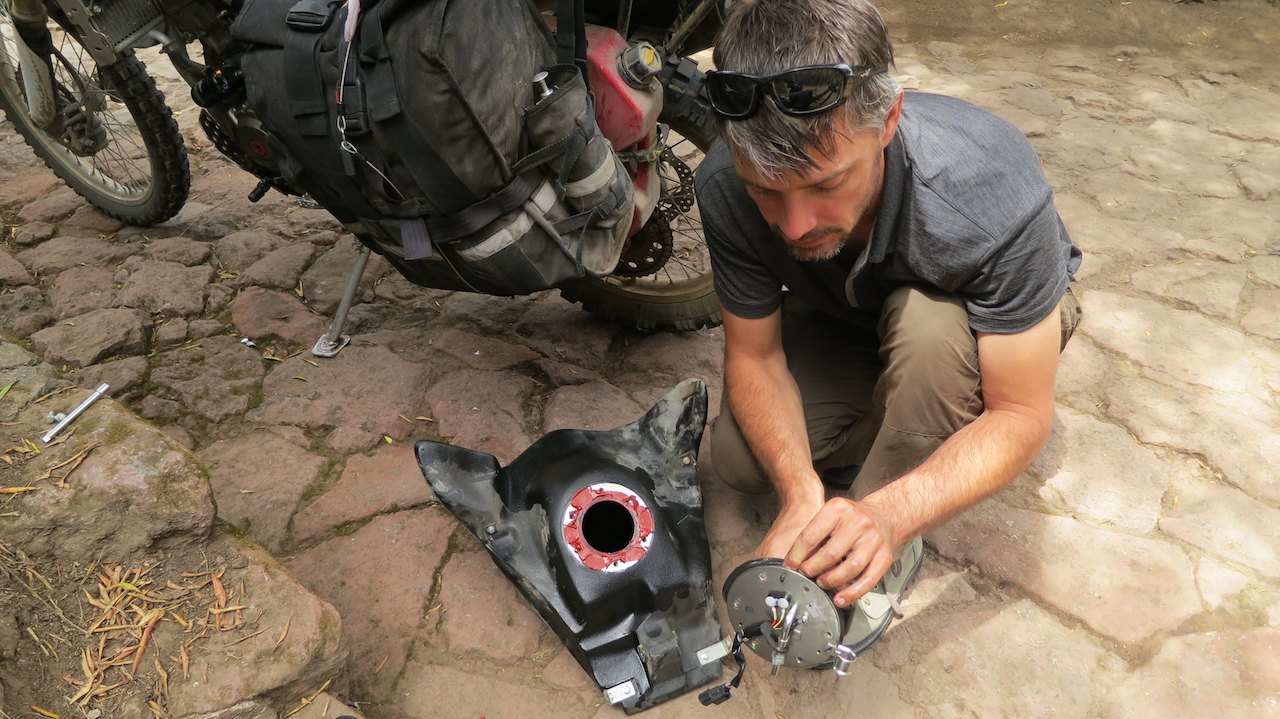
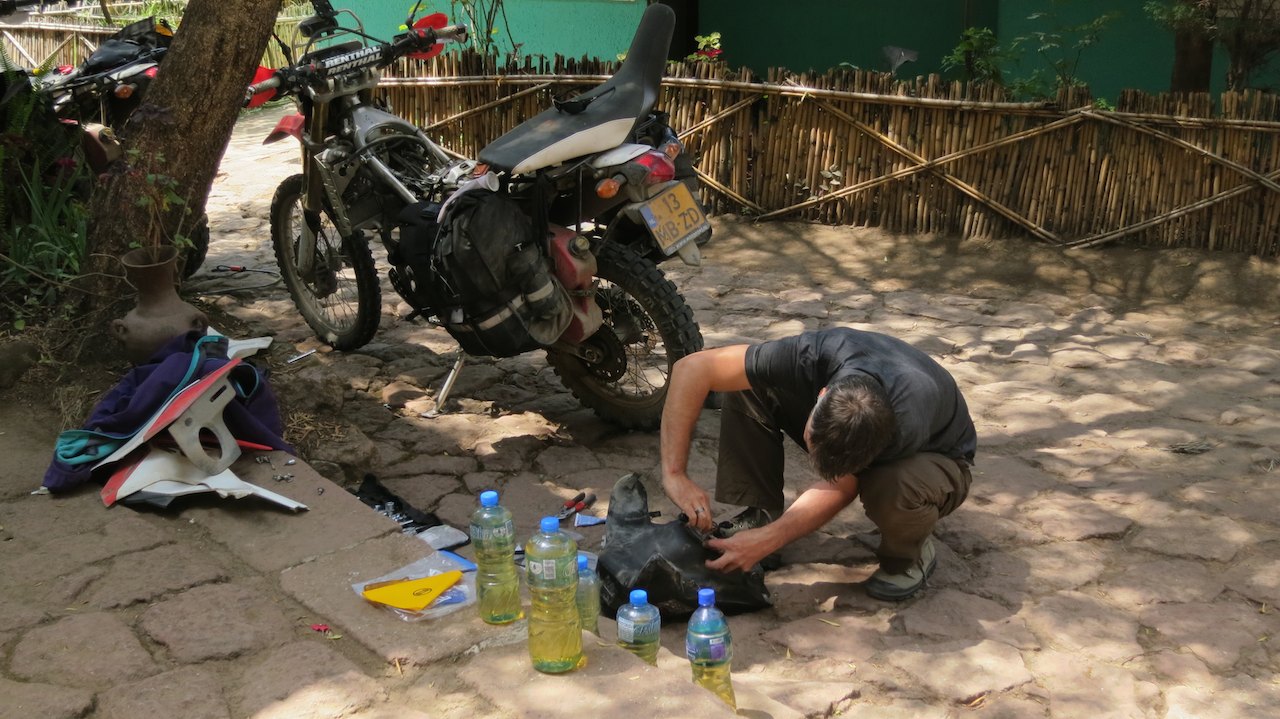
Peter takes my bike apart, while I, as his assistant, hand him his tools. Both the tank and the fuel pump must be cleaned before the ‘liquid gasket’ can be put on again. With toothpicks, napkins and scrapers we clean both parts. Around us are now a number of spectators. They are all giving advice from the sidelines. One of them gives us some empty water bottles so we can get the gasoline out of the tank, another give us cable ties. At the beginning of the afternoon the pump is neatly fitted on the tank with liquid gasket. Now it should only dry before Peter can mount the tank again and before we throw the fuel back in the tank. If we were to do that now the gasket might dissolve again.
That afternoon we send an email to the Dutch automobile association (ANWB) asking if they can send a new gasket to Ethiopia. Not even half an hour later we receive a phone call from the ANWB. A friendly gentleman has already figured out exactly what part he needs to order from Honda. If we give him the address in Addis Ababa, he will order the part and have it delivered in Ethiopia within a few days. What a service!
The next day we get up early and visit the rock-chewn churches of Lalibela accompanied by a guide. King Lalibela had wanted to build “little Jerusalem” with replicas of the tomb of Christ, the tomb of Adam and the River Jordan. This way, his citizens could go on a pilgrimage to Lalibela if they could not afford to travel to Jerusalem. The eleven rock churches are divided into two groups. In the morning we visit the churches in the north, above the river Jordan. After lunch we cross the river and visit the remaining churches, including the most famous Bet Giyorgis that was built in the shape of a cross in honour of St. George.
It is a special place and the churches are impressive. No wonder they are on the World Heritage list.
Distance travelled to Lalibela: 11.118km (6908 miles)
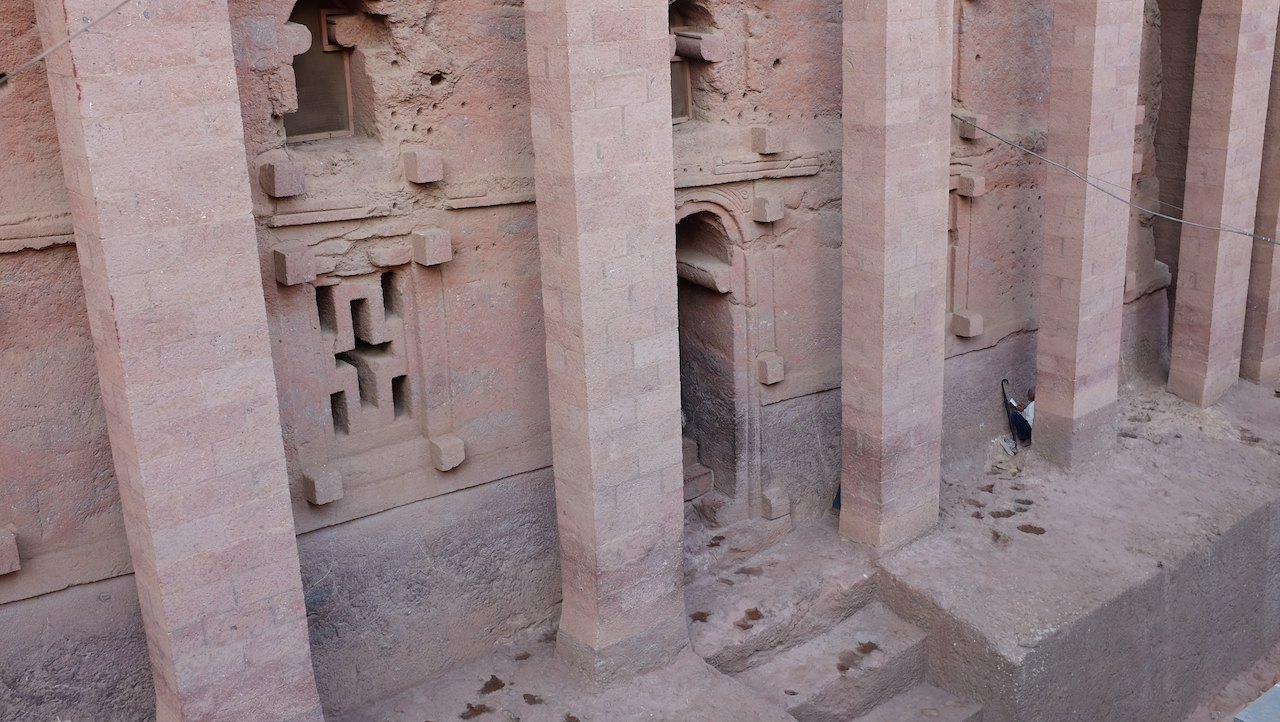
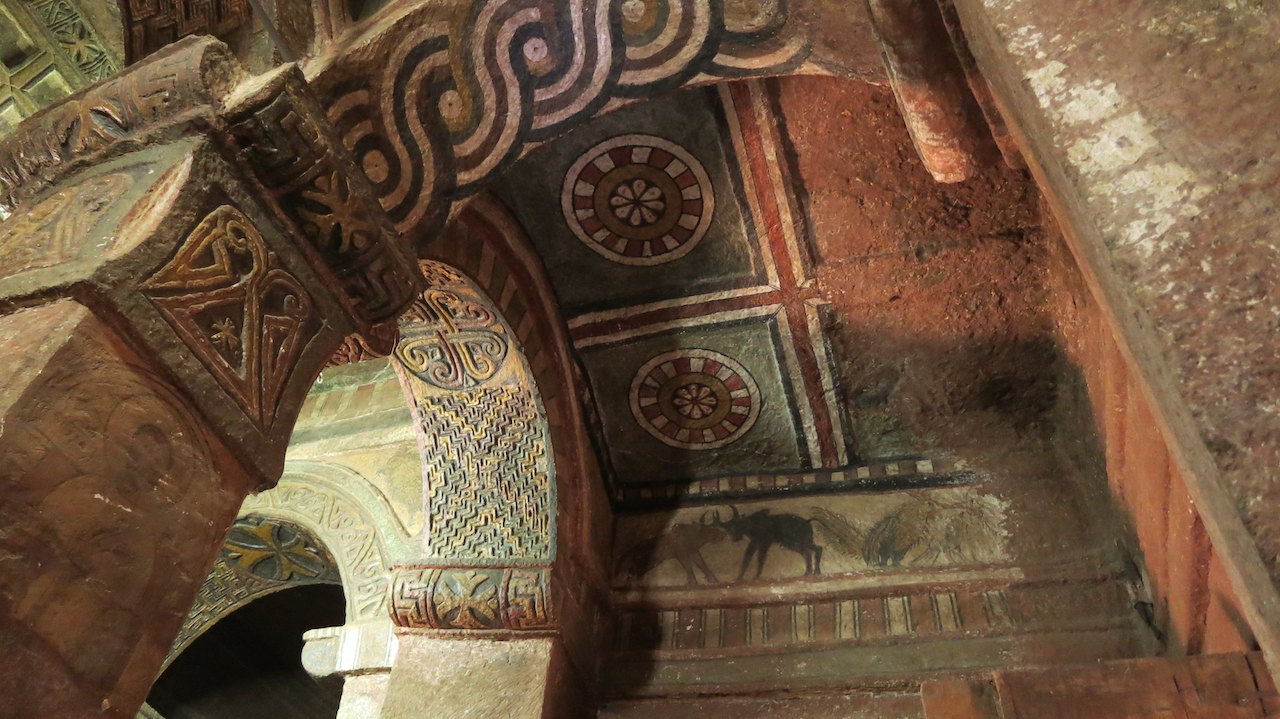
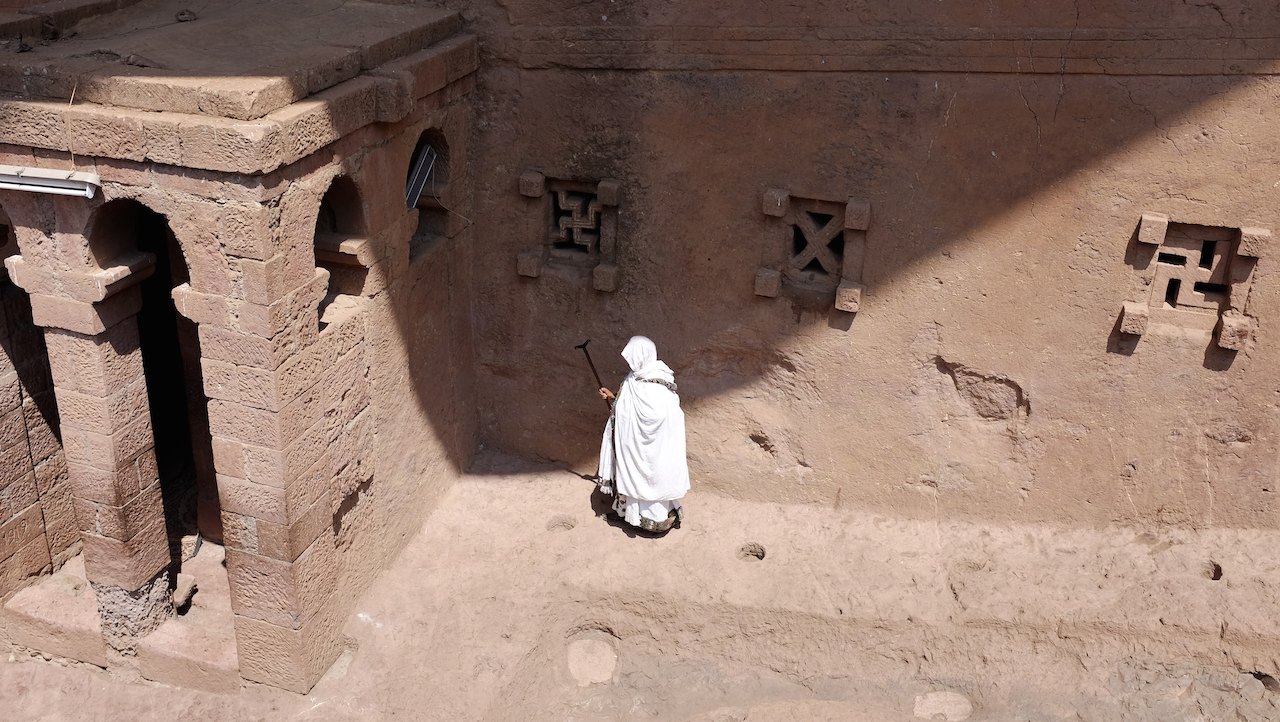
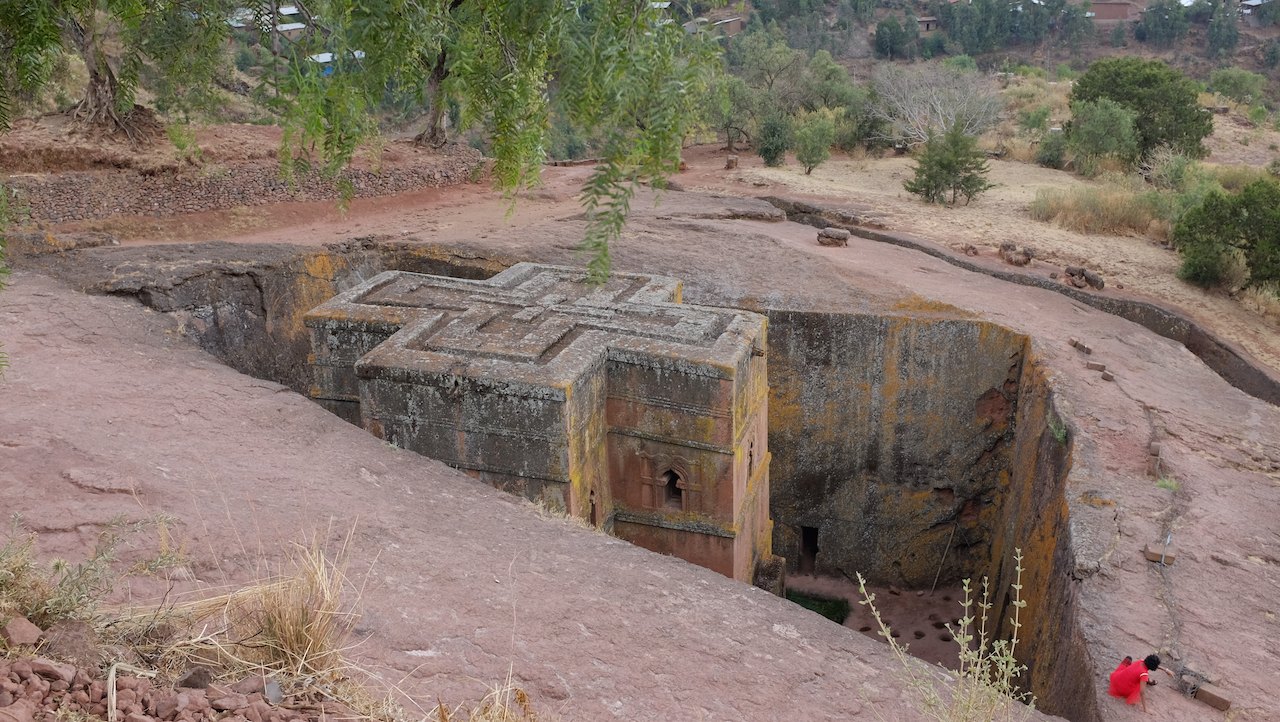
|

7 Jan 2015
|
|
Registered Users
HUBB regular
|
|
Join Date: Dec 2009
Location: The Netherlands
Posts: 66
|
|
|
"Boerenkool" and "Bitterballen"
After our tour through the north of Ethiopia and our visit to Lalibela, it is time to drive to the south again. We will go to Addis Ababa, the capital city of Ethiopia, where we have to apply for a visa for Kenya. But to me that is not the main reason to go to Addis. I especially want to go to “Wim’s Holland House”. In the middle of the city Wim has a bar that serves Heineken  , a restaurant with Dutch specialties as “Boerenkool” and “Bittenballen” and a camp site for overlanders. It is like a hub where many travelers get together. That is where we will go!
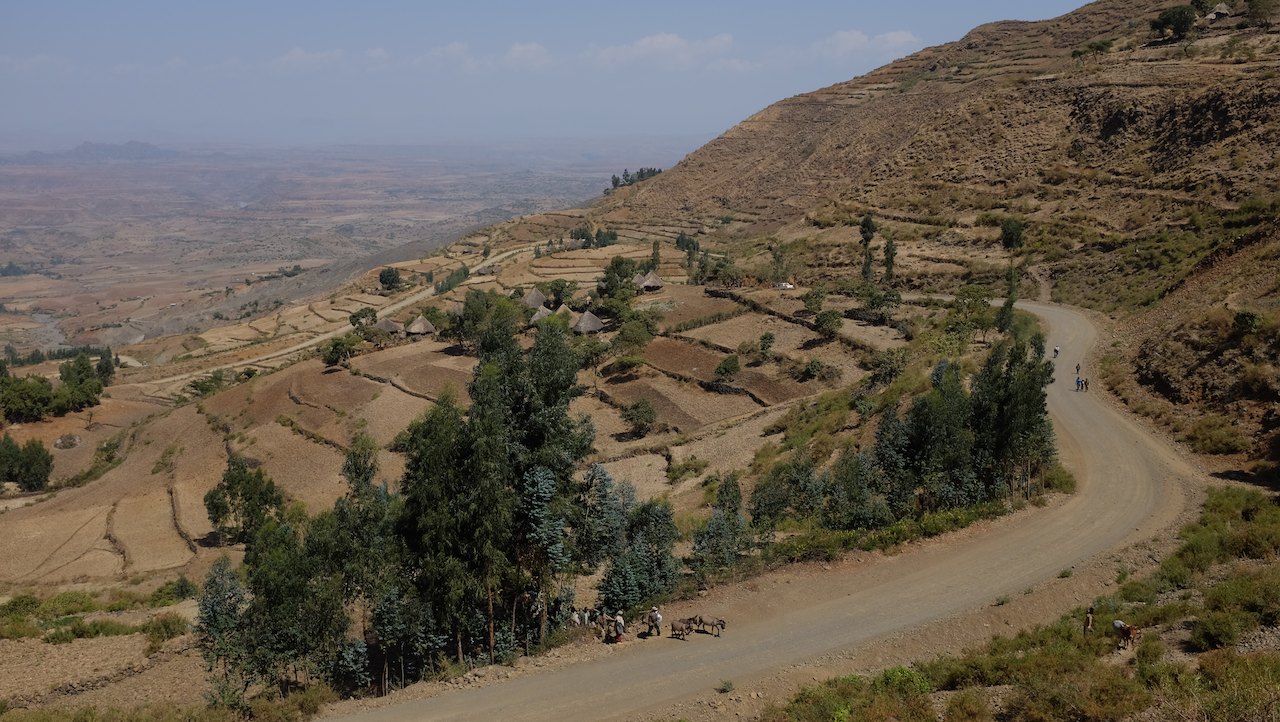
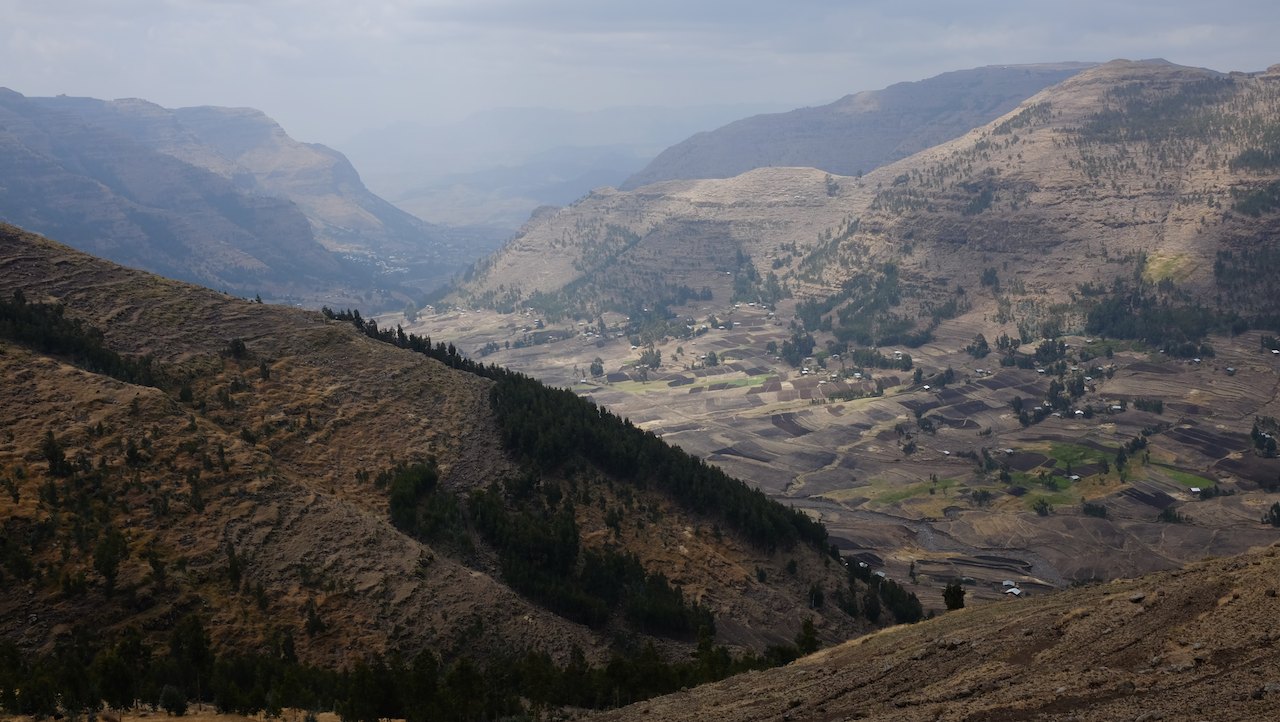
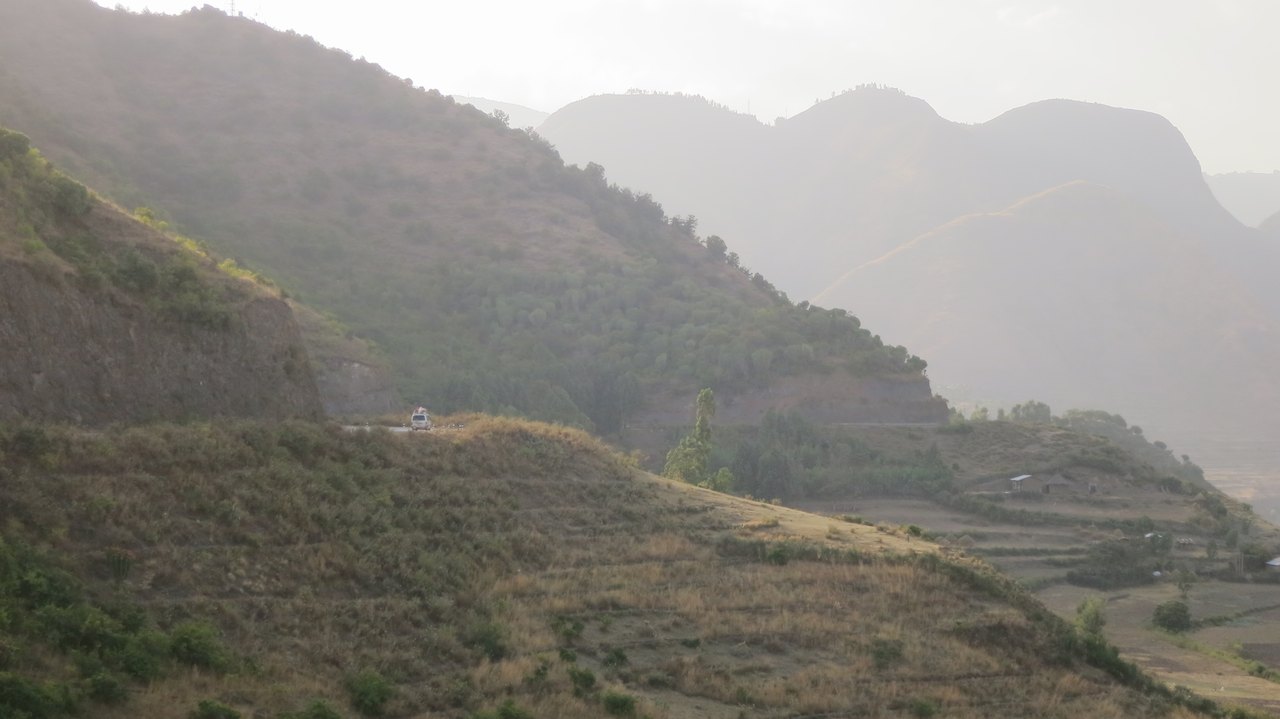
From Lalibela we drive to Addis in two days, spending one night in Kemissie. On maps very often a green line is drawn along roads which are nice to drive, so-called “scenic roads”. In Ethiopia they can easily draw such a green line along all the roads, because it again is beautiful! As in the north, the scenery is amazing, especially the rows of hills becoming a shade lighter as they disappear into the distance.
And we can enjoy the view, because we cannot really drive fast. This is despite the good asphalt and the great curves that do invite to speed. There are way too many people and animals on the road. It often happens that we have to break hard to avoid a donkey that is standing or even lying on the road. Occasionally it happens that the cattle crosses the road just before we arrive, encouraged to cross by a farmer who is hitting the back end of a donkey of sheep on the side of the road. Sometimes we even have the impression that they push their animals on the road in front of our bikes in the hope that we will hit them after which they can ask us for a compensation. We have to watch out!

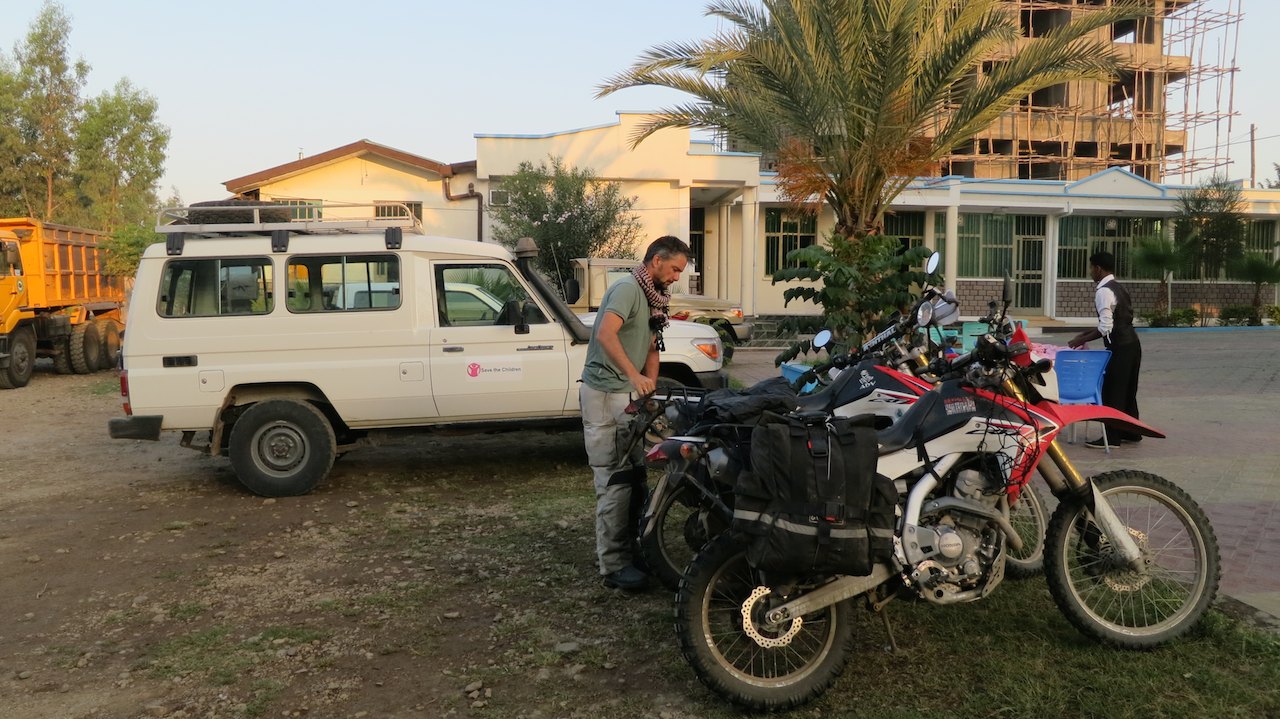
The other traffic on the road mainly consists of Toyota Land Cruisers. There are countless of these large and expensive cars around in Ethiopia. They are not driven by the Ethiopian ‘John Doe’, but by tour operators and NGO’s. The number of aid organizations that are active in Ethiopia is very high. In the villages we pass through all sorts of signs stand along the side of the road with the name of the organization and the nature of the project. It is indisputable that the assistance provided is badly needed and that the outcome of the projects is good. We have experienced that first hand in Mekele where we learnt about the project of Kevin and Els. Yet we have also raised some questions about the way help is in some cases offered. For example, would it really be necessary to have a team of aid workers drive in an expensive Toyota on the predominantly good roads in Ethiopia? And would it not be possible to spread the aid a bit more? In some villages the organizations seem to stumble over each other, we see so many signs along the side of the road. A big difference with Sudan, where it seems a part of the population could also use some help.
We also have the impression that the presence of aid organizations has somewhat affected the population of Ethiopia because we have not previously encountered so many people who hold up their hand as we drive along. The motto in most travel books is: do not give what is asked for. The population would be helped more by programs in education, health and food distribution run by aid organization than by just receiving money, food or water along the side of the road. The latter would especially not encourage children to go to school and to learn to work for what they need. Yet it is not easy to follow this advice. Having lunch by the side of the road with five pairs of inquiring eyes looking at your sandwich remains extremely difficult and a challenge we do not want to face everyday. On the way to Addis we have lunch twice in a hotel before we drive on with a full stomach.
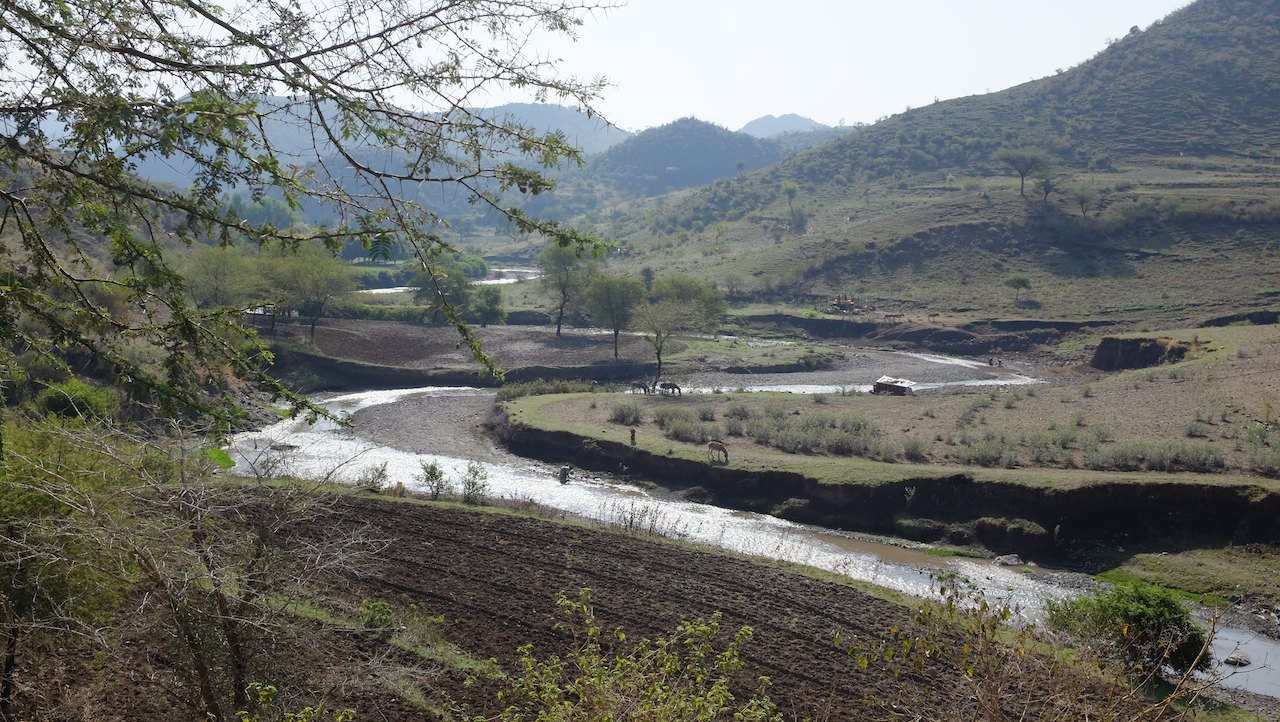
At the end of the second day, we arrive in the outskirts of Addis Ababa. From the elevated road we look out over a crowded neighborhood with small houses that are built closely together. Between the houses we see unpaved streets that turn into mud slides after a downpour. All shops are located along the road on which we ride. Although it is Sunday many shops are open. It is buzzing. With a full bag of groceries shoppers stand along the side of the road to stop a minivan that can take them home. The minibuses stop at the oddest places and sometimes even suddenly cross the street to pick someone up on the other side of the road. Very dangerous if you just want to take over that minivan. In front of us a long row of minibuses, taxis and motorcycle taxis drives in to the city. We follow a speeding taxi that zigzags through the traffic further into the city.
The further we drive into the center of Addis, the more modern and high buildings we pass. A two-lane road with several flyovers leads us along high office buildings and large hotels. Until we reach the first road construction. The first, but certainly not the last, because the entire city is a mess! The GPS is puzzled at some times. Whenever he wants to send us to a certain direction we drive passed that closed road after which the GPS needs to recalculate. But even on that new route we came across several junctions where the road is closed. It is in some parts a big chaos and a muddy mess because of the rain that has fallen in the previous days. However, we do have bikes that are made for this kind of work! We drive past the gates, onto the muddy street towards the bus station in the direction of Wim’s Holland House. After a huge detour through the city and a major quest for the bus station, we stand in front of a big ‘SHELL’ sign and we see a Heineken flag fluttering over a red-white-blue fence. We made it!
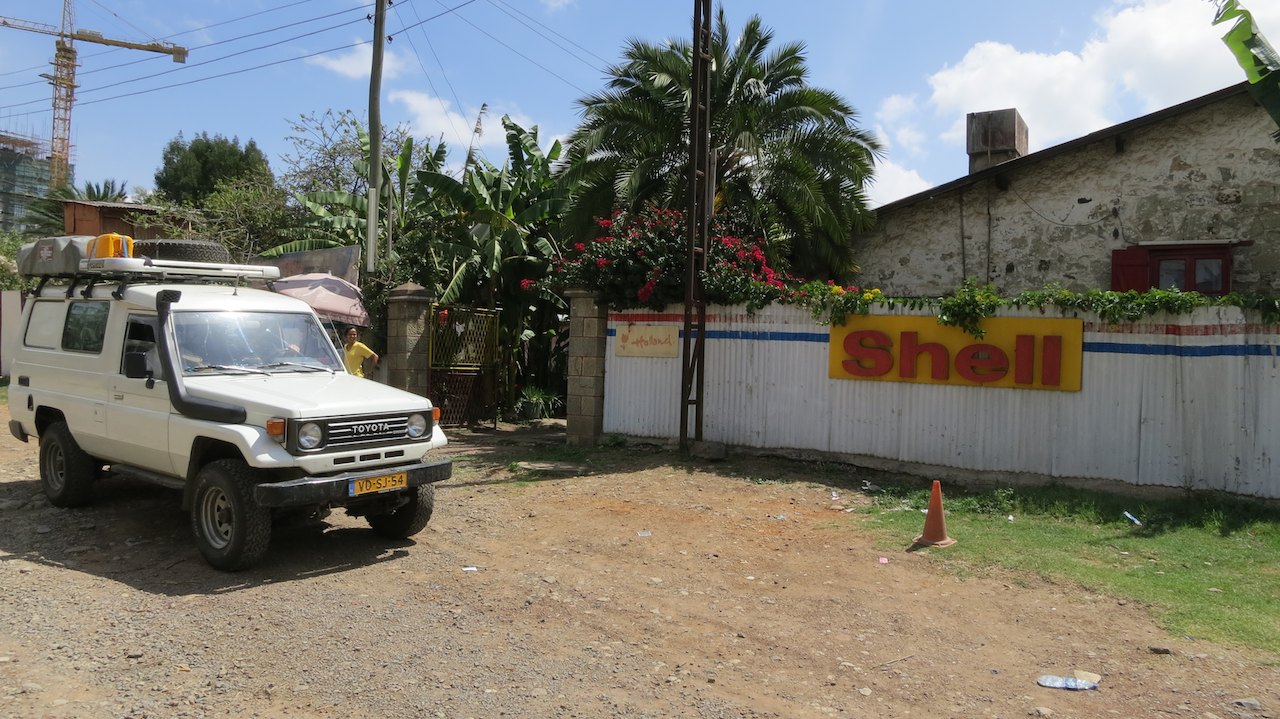
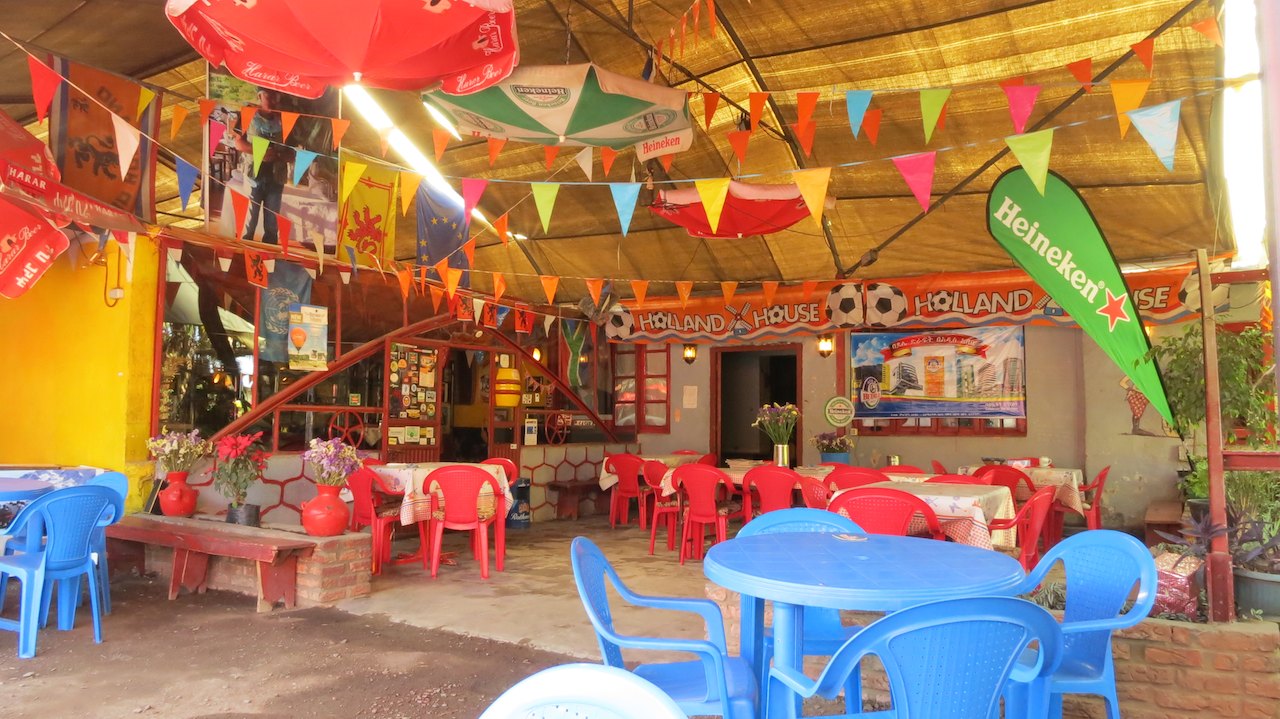
Wim is playing cards with his friends in the restaurant. Once the round is played, he comes to meet us and says “ So you are Peter and Leonie? You are already famous around here“. Then he points to the wall behind us. On the gray wall a message is written with pink chalk:
” Dear Leonie & Peter, Happy New Year! The fries and fried rice are delicious! Enjoy it. We think a lot of you. Also note messages in Hawassa and Arba Minch. Big kiss, Leon & Celine”
A message from my cousin Celine and her boyfriend Leon! Great! Leon works in Ethiopia and Celine had come to see him in Ethiopia early 2014. During a trip around the country they had left messages for us of which we had now found the first one! What a surprise.
And there was not just one message on the wall at the Wim’s. Underneath it was message by Billy and Ross, the motorcyclists with whom we had traveled through Libya, saying: “ Leonie, Peter, Just a quick hello. Hope you are well! Billy + Ross”. While we take a look at the messages, Wim is standing behind us, grinning about our cheerful response. For two months he had been wanting to know who the mysterious Peter and Leonie were and he thought it good that we were in Addis now. Then he takes us to the other side of the road to the campsite.
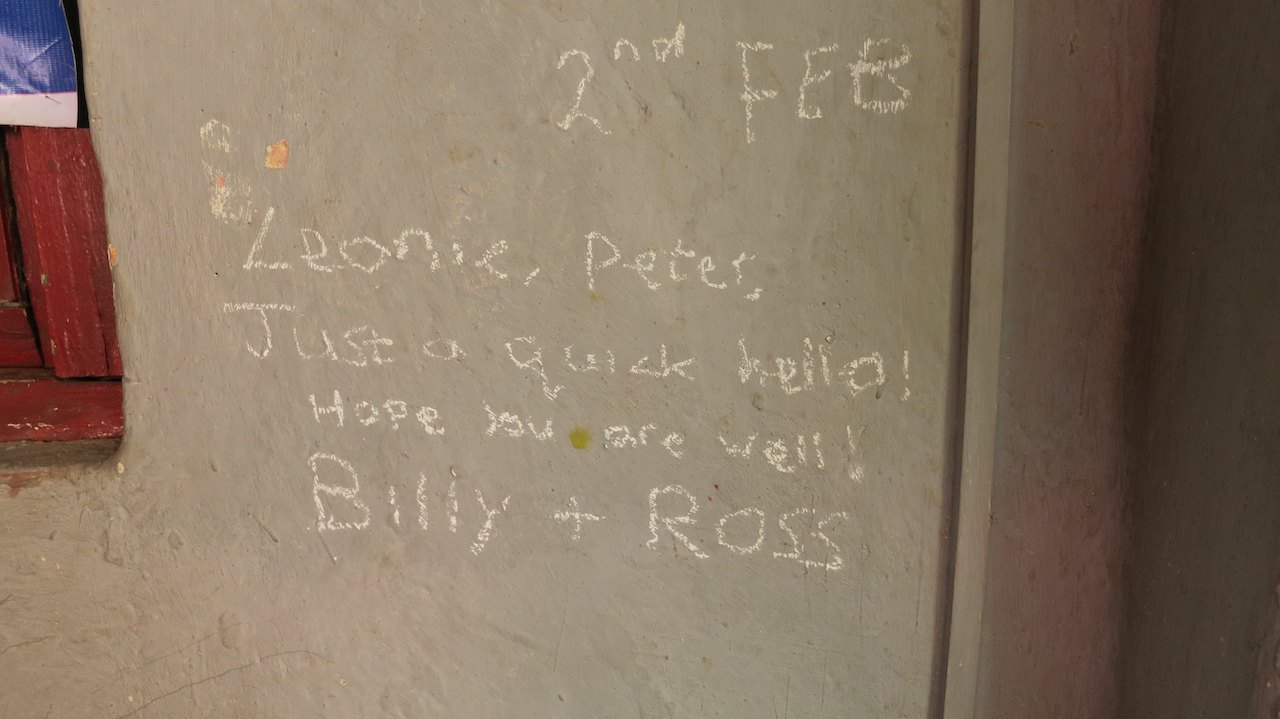
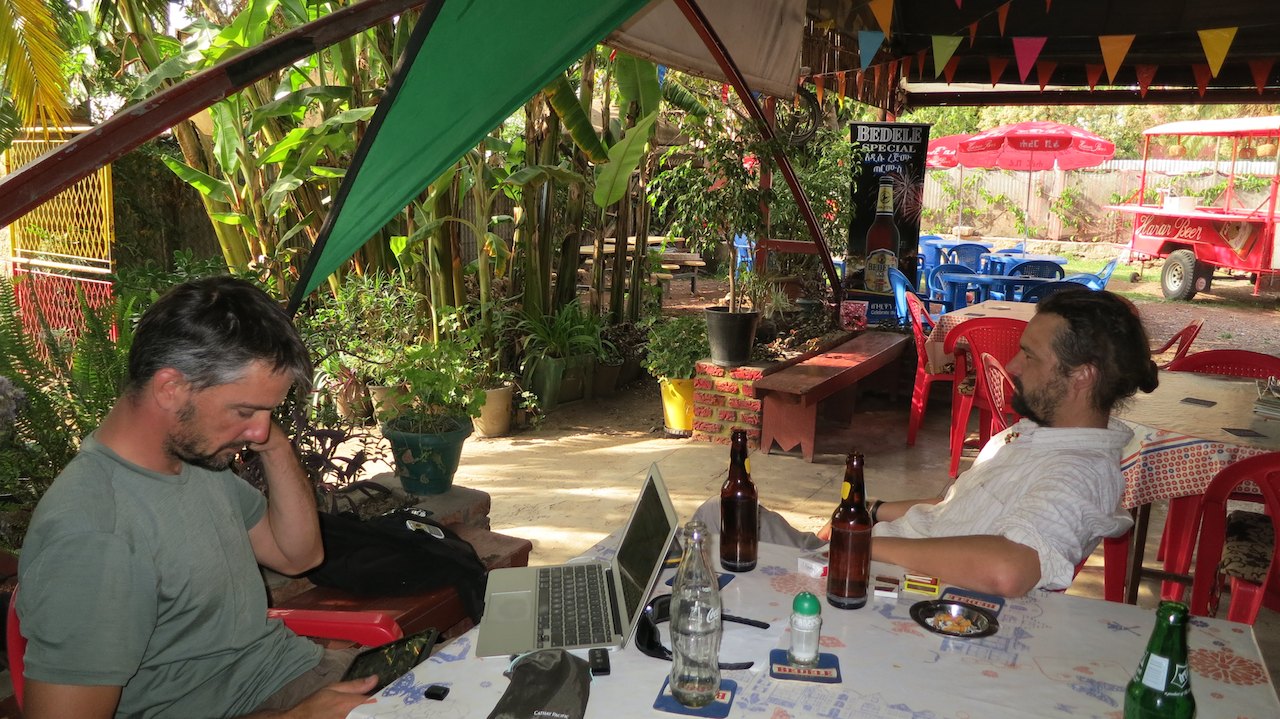
At the camp a big Toyota Land Cruiser with Dutch license plates and a roof top tent is parked. We meet Pim, who is en route from the Netherlands to southern Africa through the Middle East. We had already been in contact with him by email after we had left a message in the guestbook at Tim & Kim Village that we were looking for other travellers with whom we could drive to Kenya via Lake Turkana. Pim had responded to that message. Nice to now meet him in person and exchange stories.
Once we say that we have traveled with Billy and Ross in Libya he says, “ Ross? From England, with those curls? Yes he is still here. I think he is in his hammock.” He points to a blue plastic tarp that hangs between two trees. Ross still at Wim’s? What a surprise! Form his messages on Facebook we had understood that he was on his way to Tanzania, but it now turned out that he had engine problems again and had had to return to Addis. At that time, the plastic tarp starts to move and then Ross steps out of the hammock in his boxershorts. A cheerful encounter and embrace (still in his underwear) follow. Really nice to meet him again so unexpectedly. Once our tent is pitched and Ross has put on some trousers, we all go to the bar where we exchange stories while enjoying a  and a plate of nasi goreng. It would be a long night.
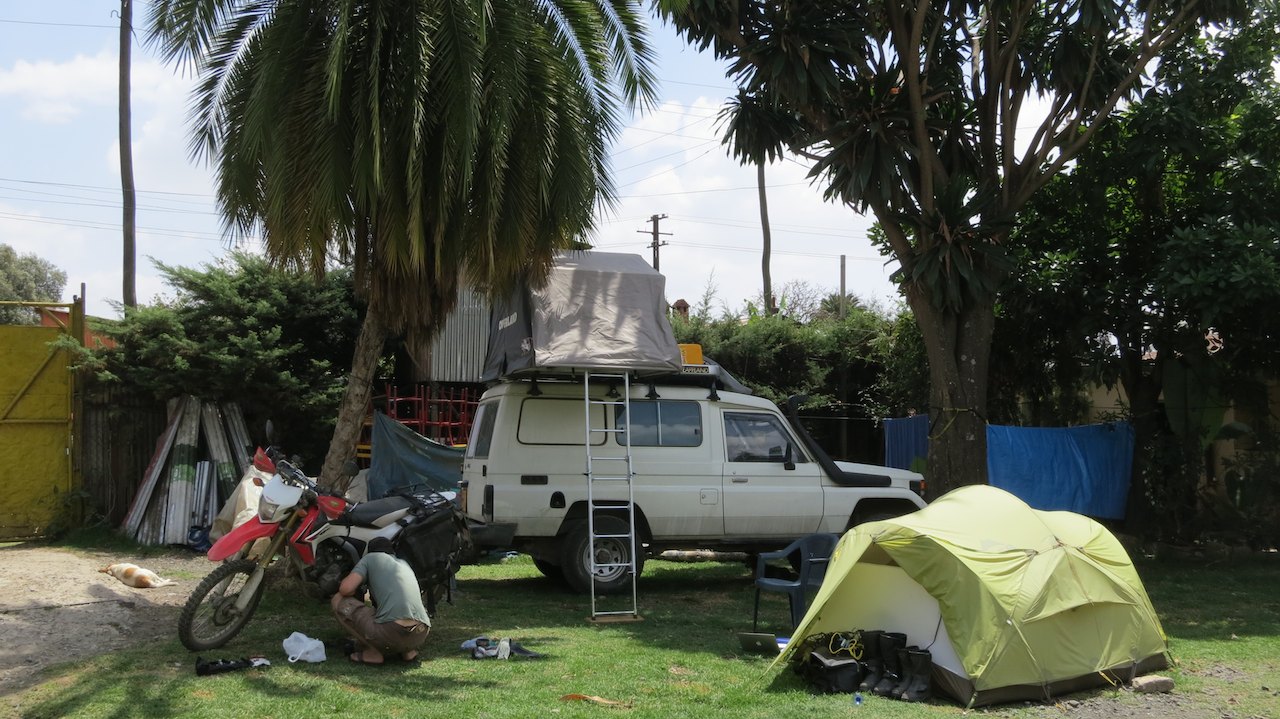
After the first successful evening, seven more follow! In those days we chat with Pim and Ross, we get to know Wim and his wife Rahel a bit better and we are introduced to Jim who travels through Africa on his bicycle. We enjoy pancakes with syrup, fries with “Bitterballen” and delicious cold  s. We toast with Philip, the Consul of Belgium, chat with Dutch flower farmers who also love “Bitterballen” and meet Chiel -cousin of Wim- who starts his ‘gap year’ by visiting his uncle. We exchange waypoints with the Dutch couple Peter and Carla who make a tour with their car from Uganda through East Africa. We drive through the city to the Kenyan embassy to apply for a visa and ride the same route back again a few days later to pick it up. Peter works on his motorcycle and that of Ross, while I update the blog and our administration. We walk into the city to find a hotel with a decent internet connection, find a hairdresser for Peter and do some shopping. Finally, we are also introduced to Michael and Judy from Australia, who shipped their (great!) Toyota Land Cruiser to South Africa and ride from there, via Africa, the Middle East, Russia, Mongolia and China back to Australia.
A wonderful week at Wim ‘s Holland House and a great time with Wim and Rahel. As we pack up our tent after a week, Wim comes to say goodbye: “ Welcome to the Wim’s Holland House Family! Keep us updated on your whereabouts.“
Please note that we visited Wim’s Holland House in February 2014. Sadly, a few months later Wim lost his battle against cancer and passed away. We feel very fortunate to have met this lovely man and will never forget his warm welcome at Wim’s Holland House.
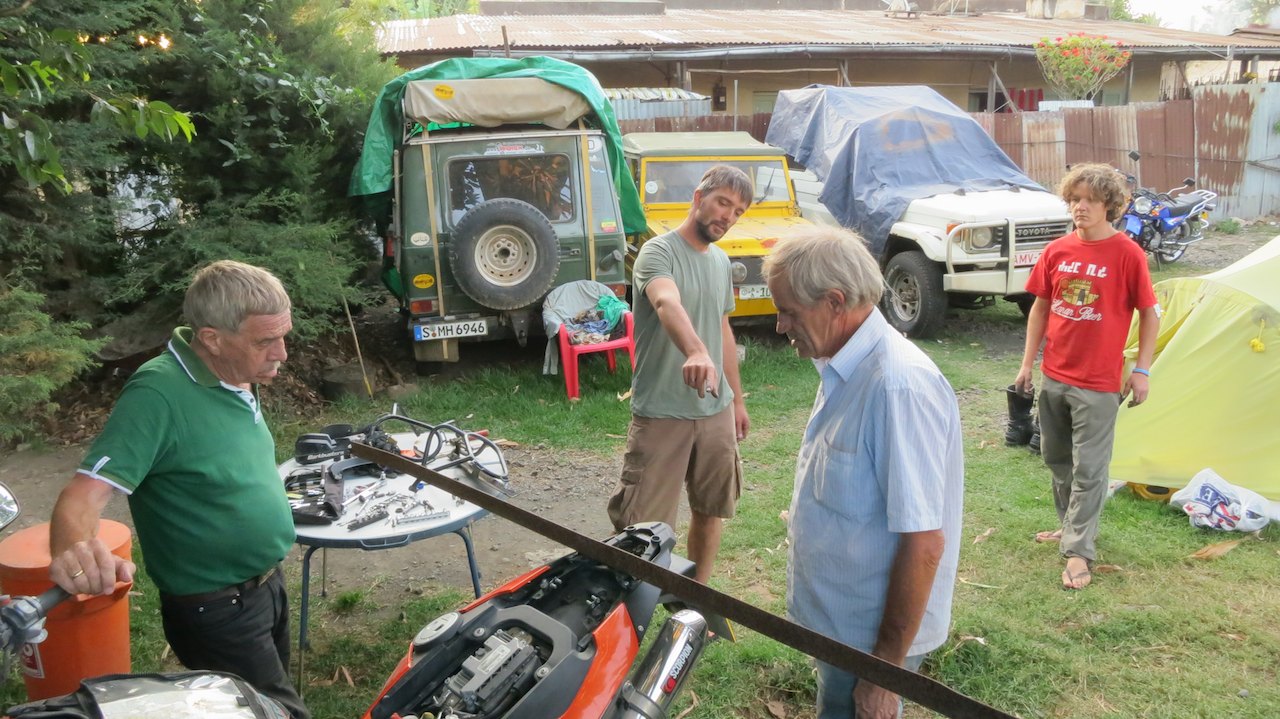
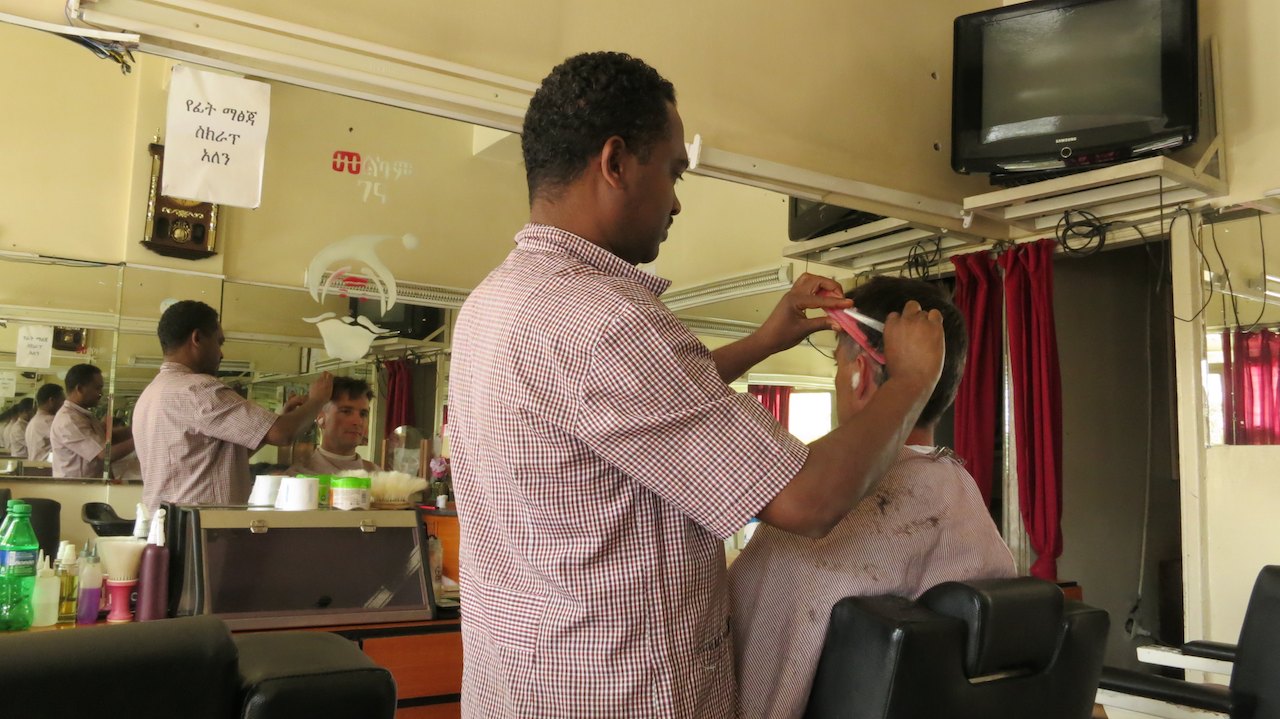
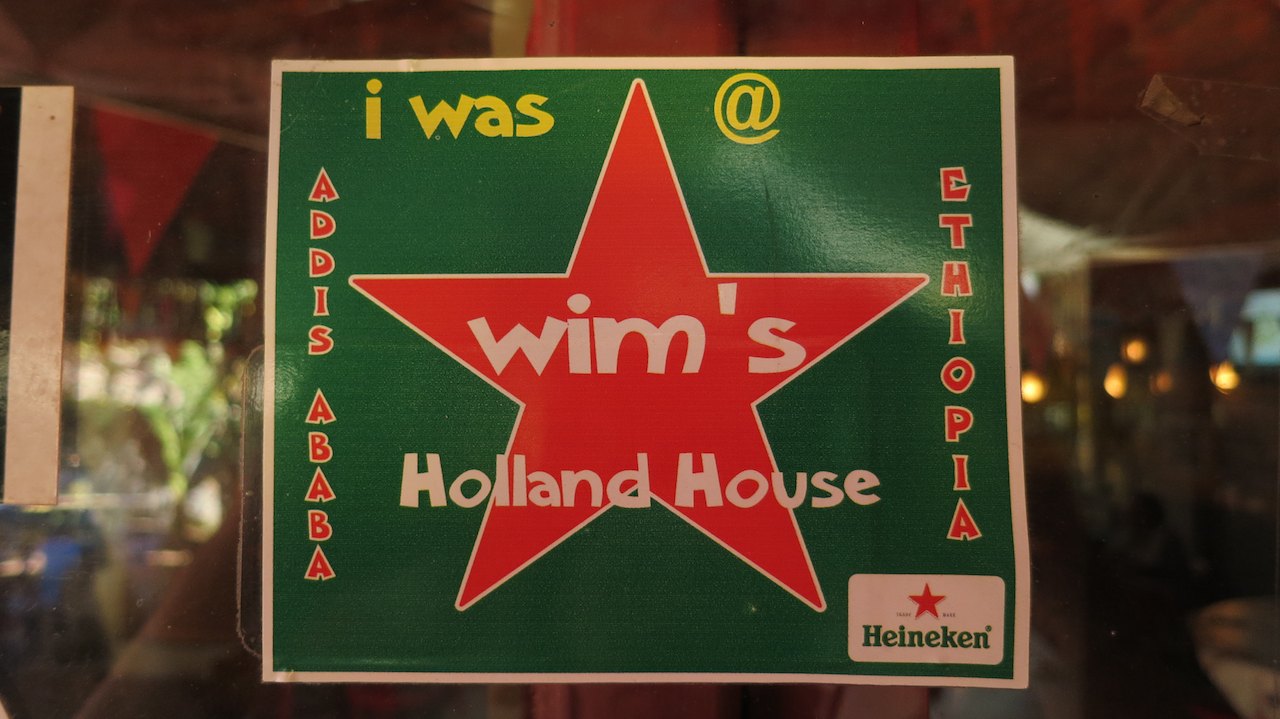
After we have refuelled in Addis, it takes an hour before we are really out of town. From Addis Ababa, which is at 2,400 meters, we slowly drive to the lower part of Ethiopia. The lower we go, the hotter it gets. Mid-afternoon, Peter hears a strange noise coming from his motorbike. We drive off the main road and find a place in the shade to check it out. The front sprocket does not seem to fit perfectly any more on the shaft and makes some noise. Peter must replace it to prevent any damage on the splines on the output shaft. That means the rear wheel has to be taken off, so that the chain can get off and the sprocket is free to be replaced. While Peter is working on the motorbike and I hand him his tools, there are already a number of people around us. After about an hour the sprocket is replaced and we can continue.

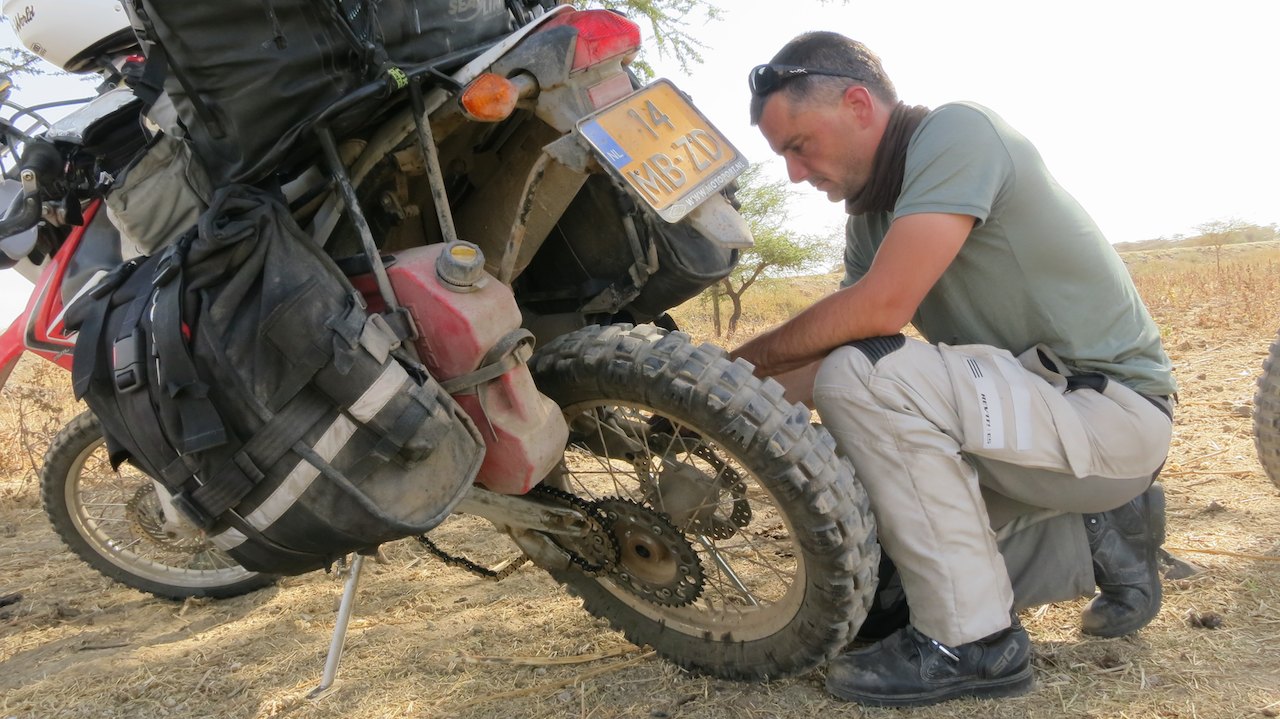
At the end of the day we arrive in Hawassa. In this city Celine and Leon had also written a message with chalk. To find the messages they sent us the GPS coordinates. The coordinates lead us to the entrance of the Agricultural University in Hawassa. Unfortunately, we could not find the message any more as the rain had erased it. It was still fun to try to find it. They had also recommended a hotel, where we indeed find a nice room. We can park the motorbikes in the courtyard.
The next day we set the GPS for Arba Minch. There we will again meet Pim to ride from there to the south and eventually through the Omo Valley to Kenya. Along the Ethiopian lakes we descend further and when we enter Arba Minch the GPS indicates that we are at 1.250 meters. It quite warm there. We try to find a room at one of the hotels, but cannot agree on the prices at the first four hotels. Above the reception desk of every hotel is a form with the prices for 2014. Prize for ‘Faranji’ is twice as high as the price that Ethiopians have to pay. We have not seen that before in Ethiopia. It is low season and the hotels are almost empty, so we try to get a reduced price. A win-win situation you would say; we have a good room, they have paying customers. But no, if we want to stay, we have to pay full price. Then we will try somewhere else. Finally we have had enough of it when we arrive at the Tourist Hotel. We finally accept a room at a slightly reduced Faranji-price. As soon as there is water from the tab, we freshen up, take a shower and dive into our sleeping bag liner under the mosquito net.
Tomorrow we will search for Pim and go shopping in preparation for the “Turkana Route”. More about that in the next blog posts .
Distance to Arba Minch: 12,457km (7,740 miles)
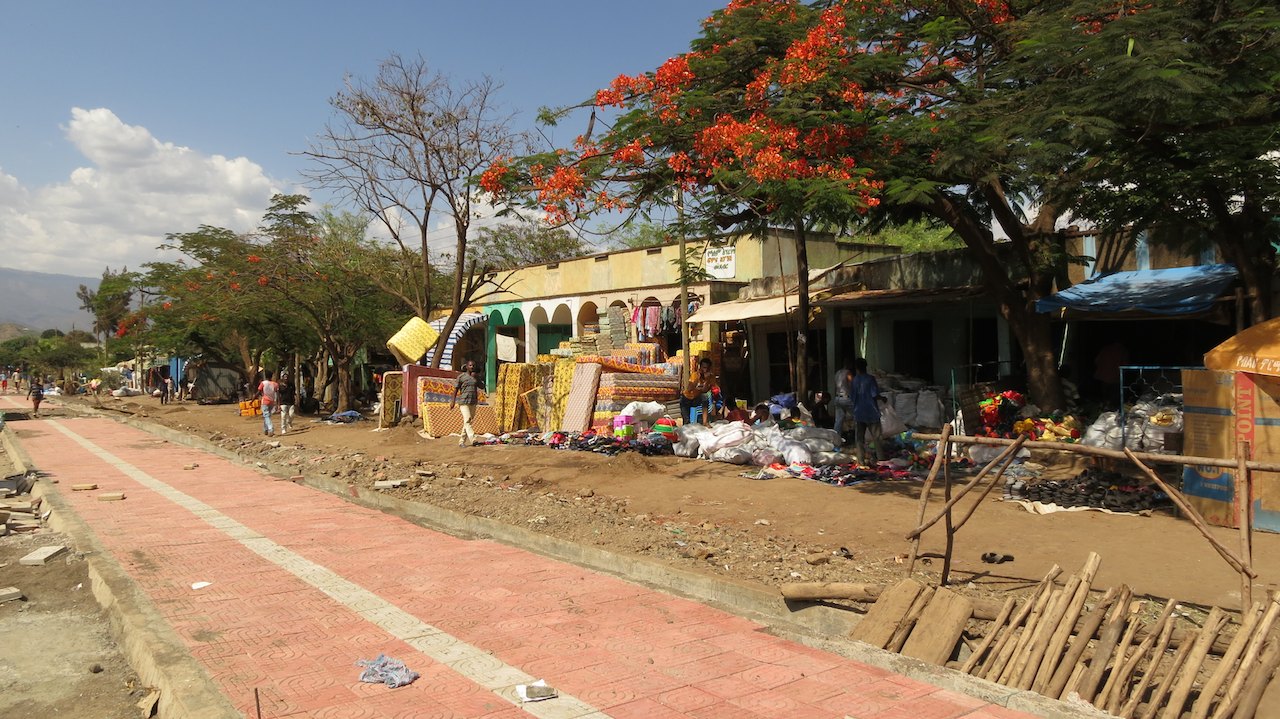
|

19 Feb 2015
|
|
Registered Users
HUBB regular
|
|
Join Date: Dec 2009
Location: The Netherlands
Posts: 66
|
|
|
Turkana Route I: To the Omo Valley
To go into Kenya from Ethiopia there are two routes we can take. The first route is from Moyale in Ethiopia to Marsabit in Kenya. A route that is known for the poor condition of the road and the many freight trucks and also the road that is sometimes referred to as the “Bandit Road”. The second option is from Omorate in Ethiopia, along Lake Turkana, to Maralal in Kenya. This route leads through a remote part of Kenya without any tarmac roads for over 800km, where facilities are far away and where gasoline, food and water is hard to get. But this is also the route through one of the most beautiful and unspoiled parts of Kenya. We chose to follow that Turkana route.
Still, this sounds easier than it is. The advise on the Turkana route is: “Do not travel alone.” The area is remote and difficult to reach, so help is far away when you go get stuck in the mud, have engine troubles or -even worse- get hurt. And in addition to that, we cannot take enough water, food and fuel on the bikes to cover the entire track. Space on the bikes is limited. We would therefore only ride the Turkana Route if we would meet another traveller who would want to travel with us and who would be willing to carry our fuel on the roof of his car. But gasoline on the roof of the car; that is not something everyone would agree to. And besides that, there are currently not many overlanders in Africa anyway. Yet, against all odds, we did find a travel companion!
We had placed a message in the guest book at Tim & Kim Village in Ethiopia: “Wanted: fellow traveller for the Turkana Route”. One week later we received an email from Pim. He wanted to ride the Turkana route and was willing to take fuel on the roof of his Land Cruiser. He also mentioned that he had met another Dutch couple that might want to ride along Lake Turkana. In Addis Ababa we met Pim, we planned the route and came into contact with Jan and Margriet. Peter and I went to Arba Minch, where we would meet Pim again to do some shopping. After that we would drive with Pim to Turmi in the Omo Valley. There we would meet Jan and Margriet to convoy to Kenya. A good plan!
———-
It is warm in Arba Minch. During the day the temperature rises far above 30 degrees Celsius and at night it does not seem to get any cooler. Even the thin cotton sheet we sleep in is too hot. Bonding with sweat, we are awakened at dawn by the announcer of the Orthodox Christian Church across from our hotel. Over an hour we hear him sing one song after another, very loud and quite out of tune. No chance to sleep anymore and a refreshing shower is not possible either, as there again is no water. Alas, with some wet wipes and lots of deodorant we are “not-clean- but-all-fresh” and sit down for breakfast a little later. We have some coffee to regain energy for the rest of the day.
After breakfast Pim joins us and together we go out to do some shopping. We have calculated that we need about six days to drive to Maralal (in Kenya). According to the information we found on the Internet, we would be able to find fuel, food and water there. Therefore we take food for six days. Fresh vegetables for the first few days, but cans of vegetables for the next few days, because in this weather vegetables go bad without a refrigerator very quickly. In Arba Minch we can get anything we want to take: pasta, rice, cans of tuna, cans of peas, tomato paste, noodle soup, biscuits, jam, peanut butter and even chocolate paste and Snickers! With this we can get a long way!
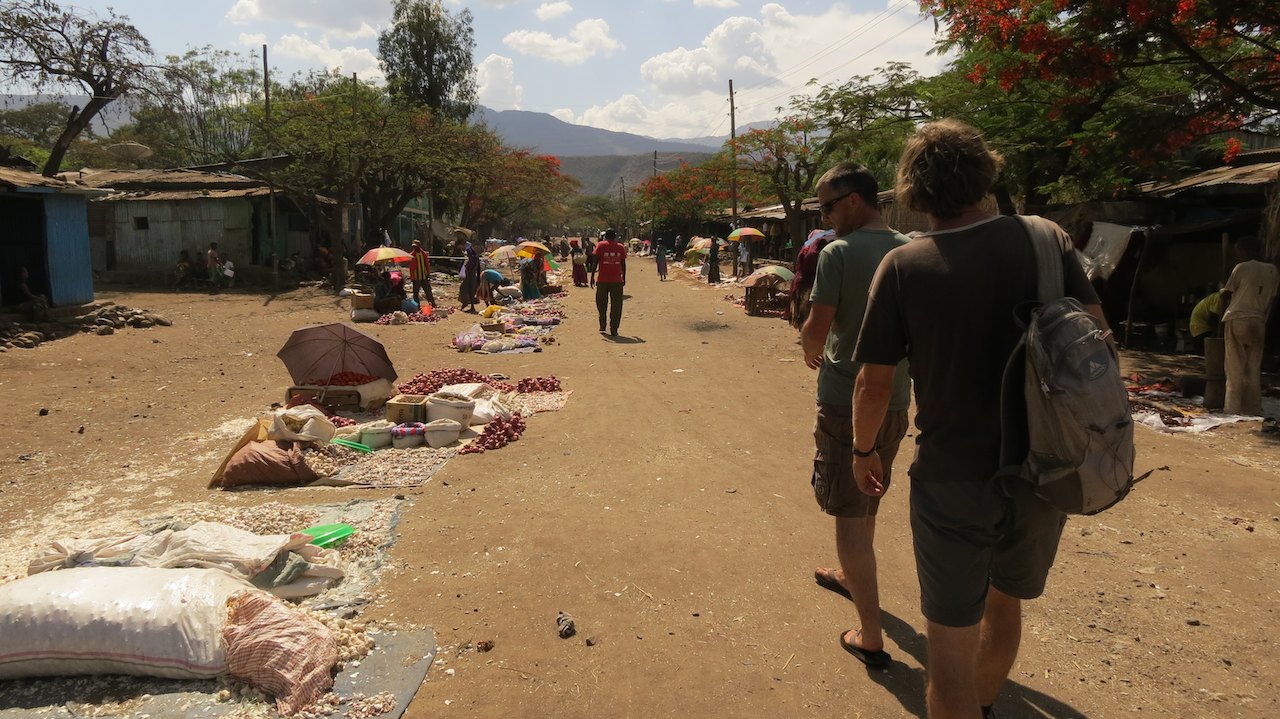
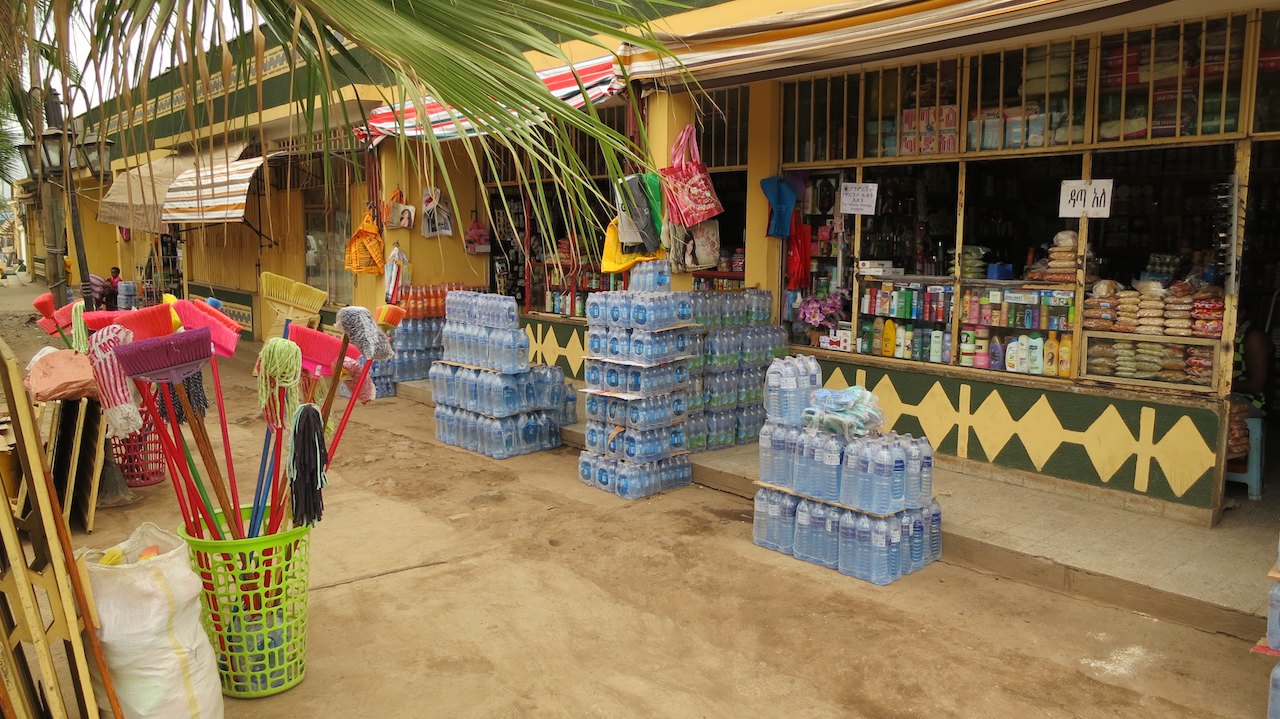
We also need drinking water for at least six days. In this hot weather we both drink lots of water. Especially when we ride offroad we drink at least three litres per person per day. To make sure that we have enough water, we end up buying more than 40 litres of drinking water in large bottles of two or five litres. We cannot bring all this on our own bikes and are happy we can put this in Pims car.
Then the extra fuel. With the help of a man at the hotel we buy three jerrycans in which we can take gasoline and water. They are large yellow cans which were used for cooking oil. Perhaps not quite CE or DOT certified to transport fuel, but for a few days it will be fine. With two of the cans on our bikes we drive to a gas station in the city centre. Initially the attendant refuses to fill the cans with fuel. He points at a sticker on the pump that says: “No plastic containers.” At the same time, at least three tuktuks are filling the same plastic cooking oil cans at the pump next to us. We point to the plastic IMS tank on our motorbike and take another look at the tuktuks beside us and then he gives in and fills the cans.
Back at the hotel we fill the third can with tap water. We cannot use it as drinking water, but if we boil the water we can use it to cook rice, pasta, tea and coffee. And we can also use it to wash and do the dishes. It takes some time to fit our three jerry cans, next to the cans of Pim on the roof of his car, but it fits. After an hour, the fuel and the “cooking water” are rock solid strapped to the rack on his roof.
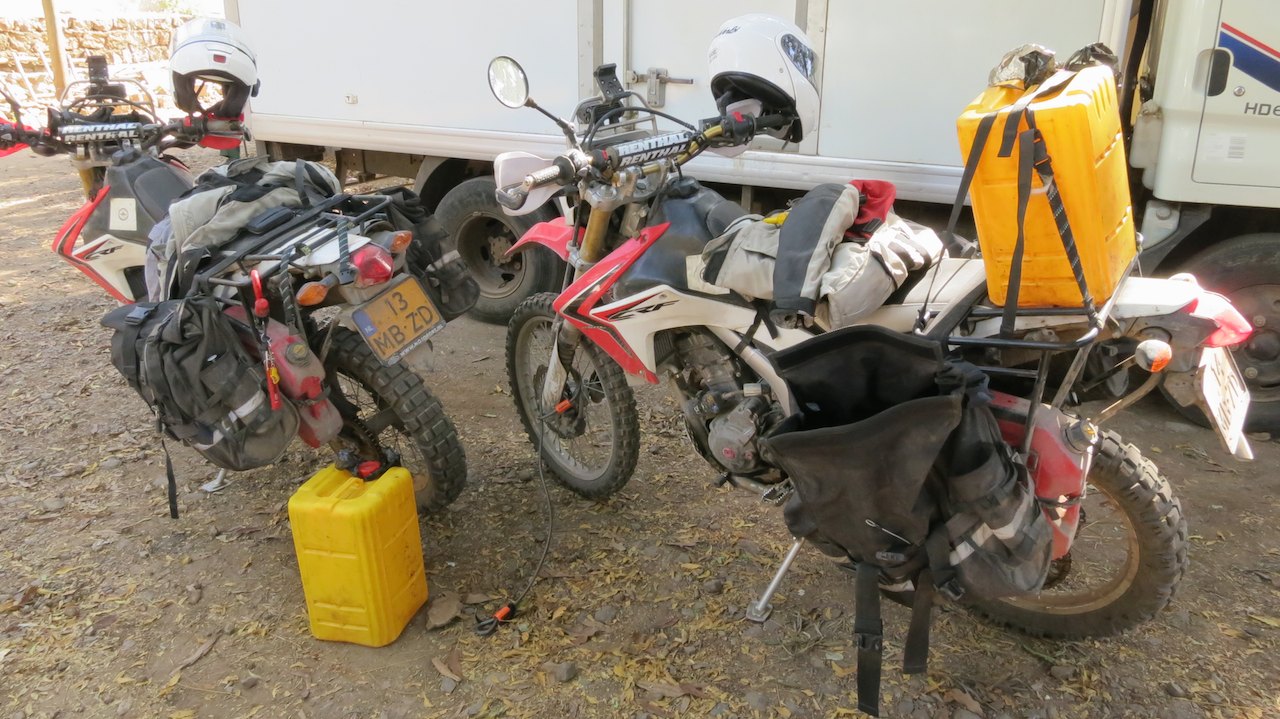
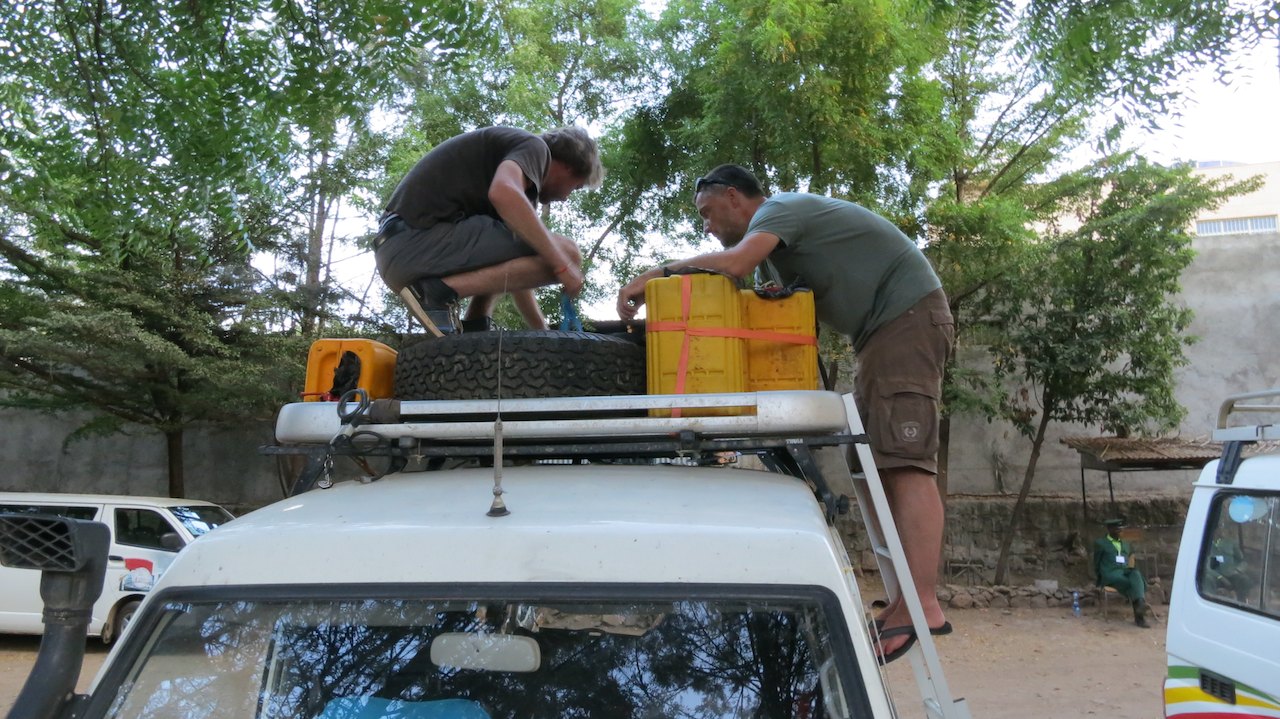
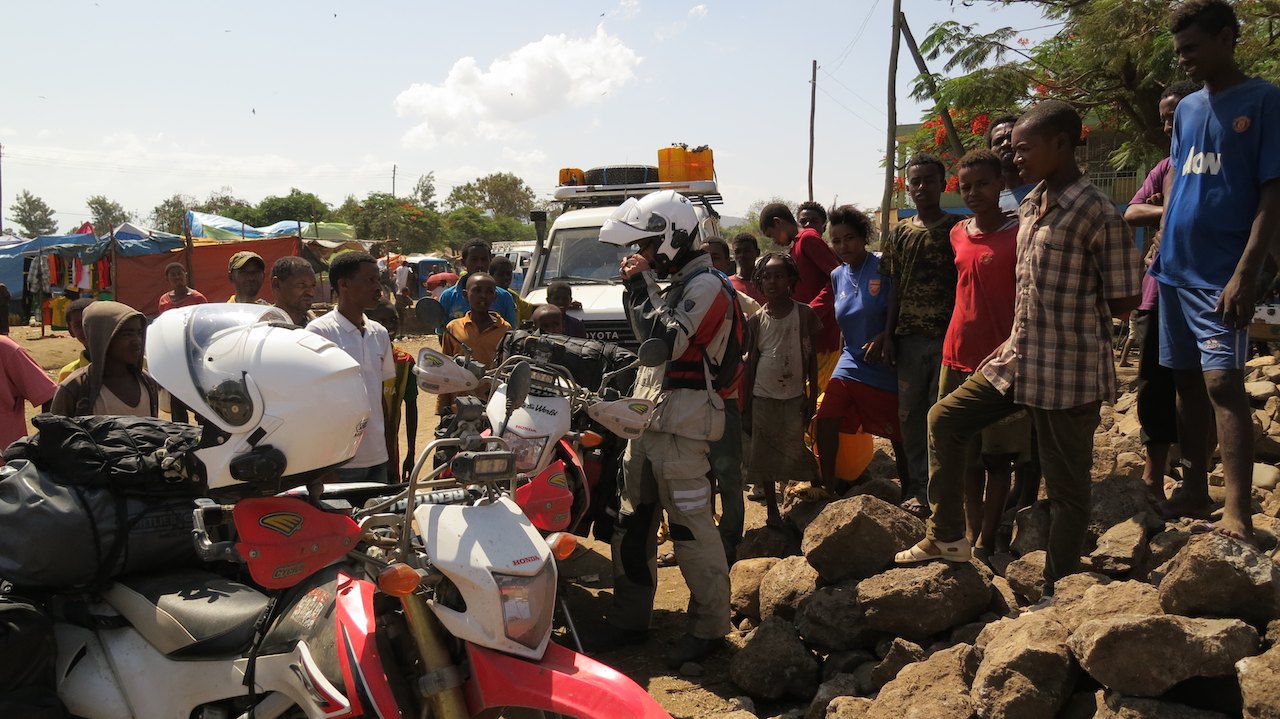
The next morning Pim arrives at our hotel early in the morning. We have breakfast together and again head for the market in Arba Minch to buy fresh vegetables and bread. Peter stays with the packed motorbikes and I go to the market with Pim. When we come back, we cannot even see Peter because there are so many people around him. They all want to see the motorbikes and preferably touch all buttons. It is too hot to be standing in the full sun, we should get on the road to have some airflow. When we start the bikes and open the throttle a bit, most bystanders take a few steps back and we have enough space to turn the bike and drive away.
We leave Arba Minch and drive along Lake Abaya south to Konso. It is a beautiful and paved road along golden fields in which people are at work in the blazing sun. The landscape is very different than in northern Ethiopia. Less mountains, much lower and much warmer. On the road dozens of women and girls are carrying huge bundles of branches on their back. Apparently a task for the women, because throughout Ethiopia we have not seen a man carrying such bundles of wood. We pass a river that is buzzing with people. In the small trickle of water in the wide riverbed people stand to wash, cattle are drinking, laundry is done and mopeds are polished.
Every time we stop to take a picture or to eat something, there is a group of Ethiopians around us within seconds. “ Where are you go?” is a question that is often asked. To date, we are still not entirely clear whether they want to know where we come from or where we are going. It is even very doubtful whether they themselves know what they ask us. It often happens that we properly answer the questions and then ask a question ourselves to make a chat, but get the exact same questions again as their response: “ Where are you go?” or “ How are you?” or “ What is your name?“.
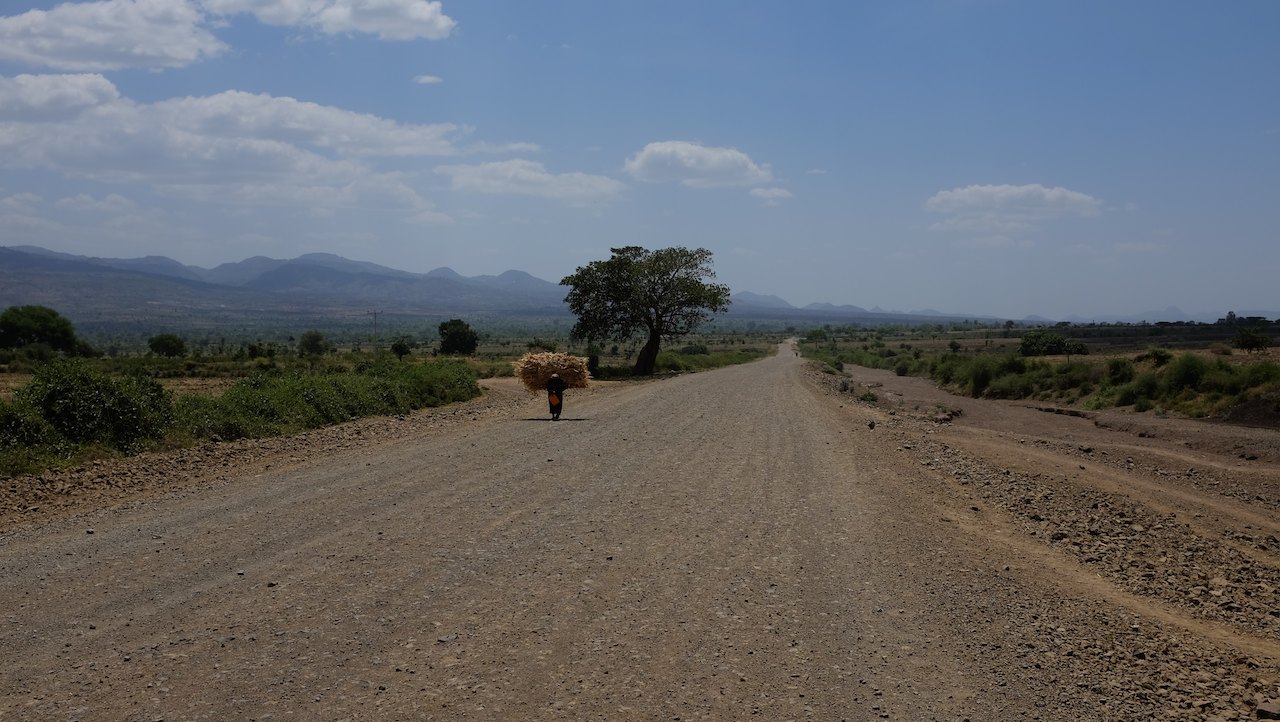
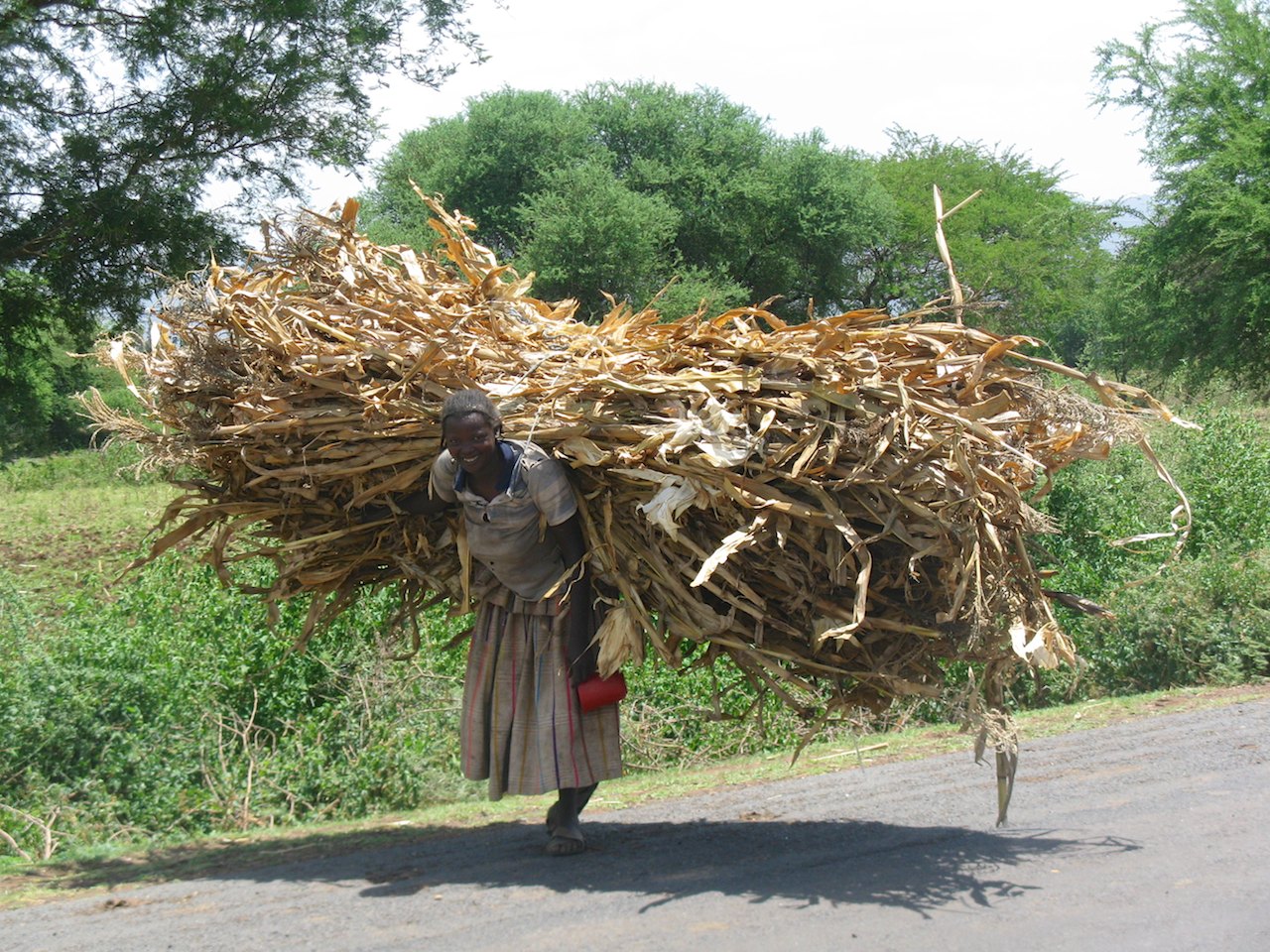
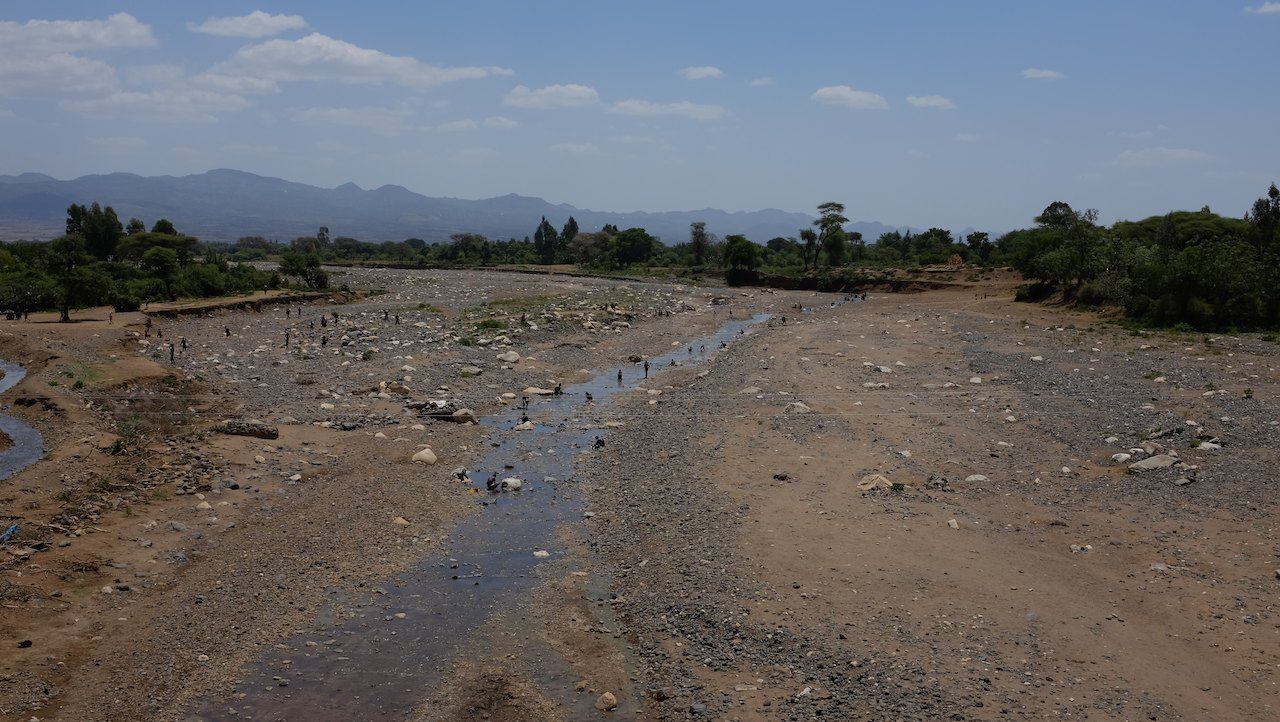
The road from Konso to Weita (also known as Woyto) still consists of smooth asphalt, but once we take the exit to Arbore we drive on a gravel road. The first kilometres of at least another 800km without asphalt. It is dry and the road is good to drive on. That is a different story in the rainy season. The wide rivers are then full of water, blocking the roads and cutting off the villages from the rest of the world. The roads then chance in muddy paths with deep tracks that are not easy to ride on for most traffic. Our guidebook evens described the Omo Valley as a ‘No-Go Area’ in the rainy season. The rainy season is about to start, so we should not travel too slow and just keep driving now the roads are still passable.
We drive on, further into the Omo Valley. The area is known for the 24 tribes that live there, each with their unique characteristics. Well known tribes like the Mursi (famous for the clay plate in their lip), Hamer (known for their muddy dreadlocks) and Karo (known for painting their bodies). Although the roads are pretty good to ride, we cannot ride great distances because the average speed on some stretches is quit low. A distance of 20km may take 30 minutes, but depending on the condition of the road can easily take an hour.
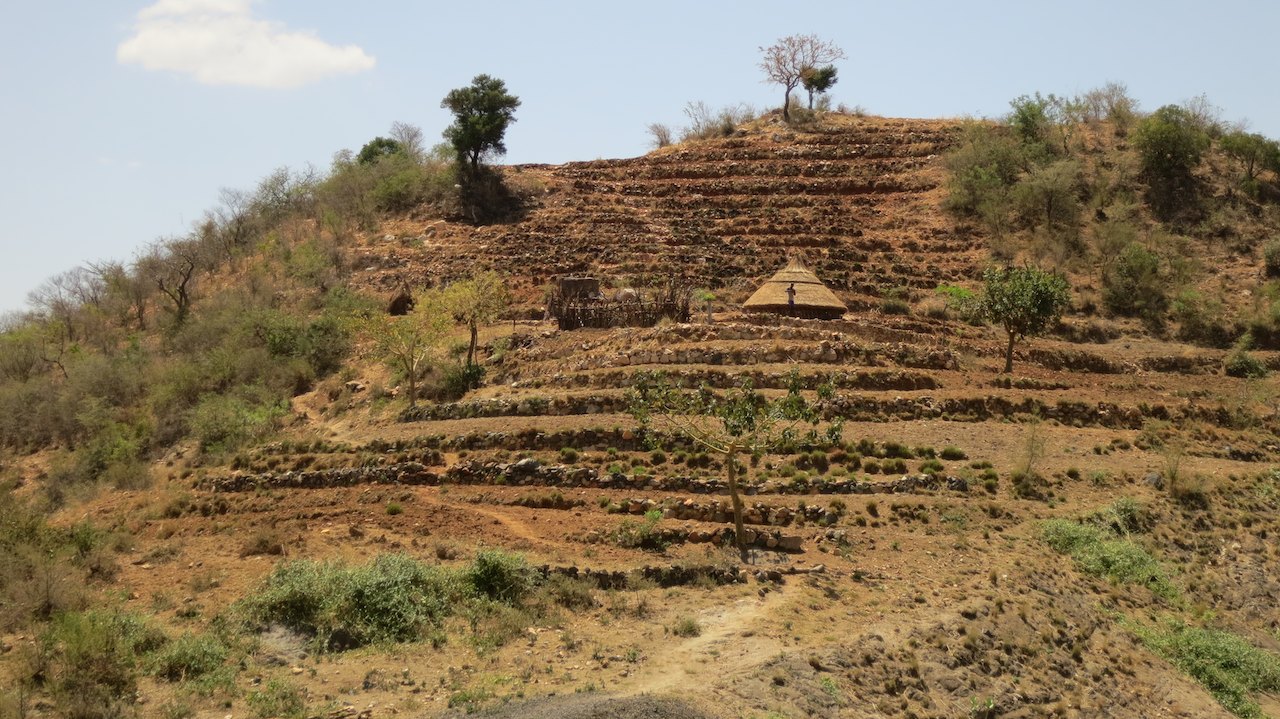
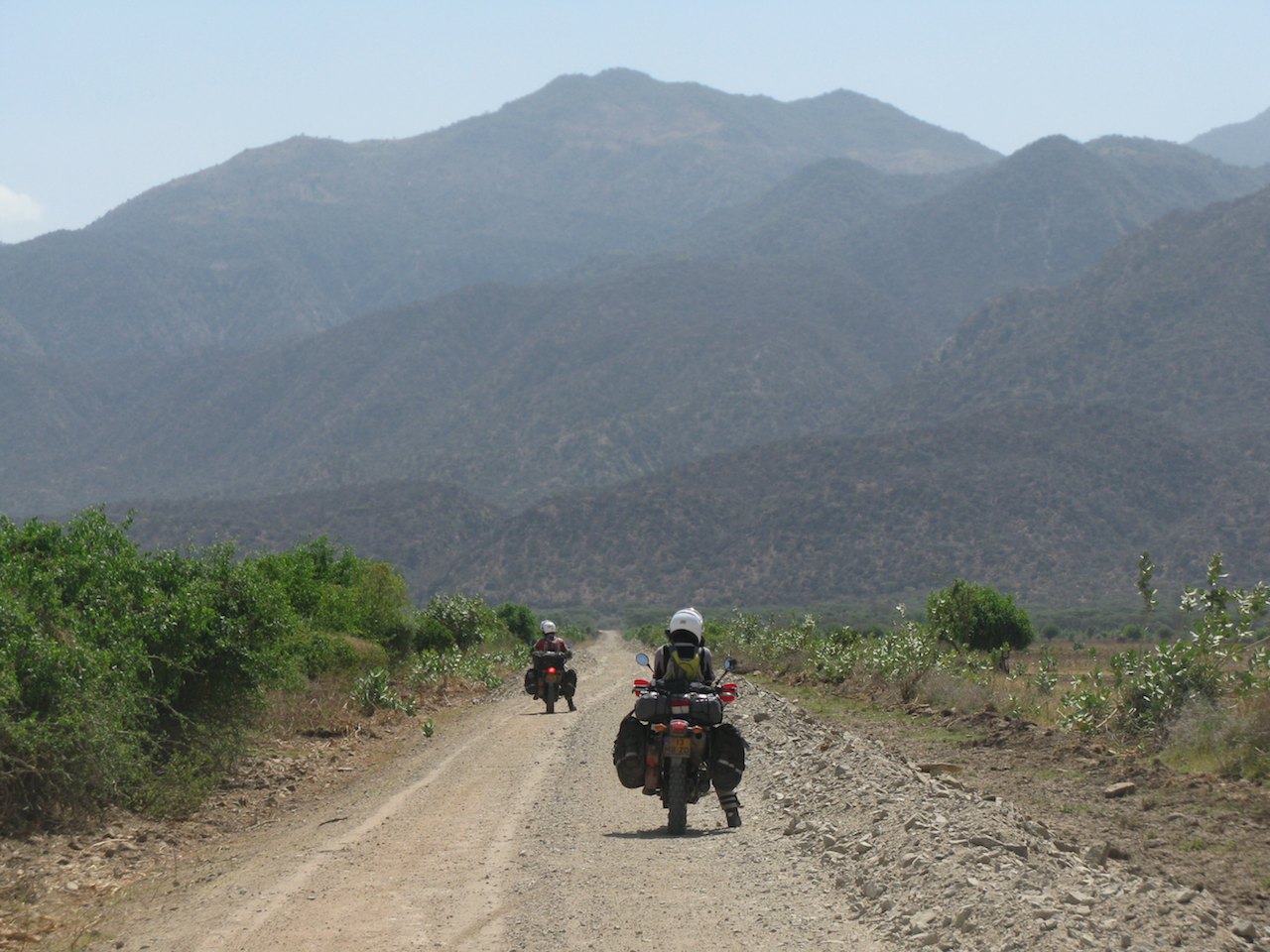
At the end of the afternoon we arrive in Arbore. A village that consists of no more than a handful of huts. The village also has a campsite. Although it is not much: there is no running water, no electricity and the toilet is a squat toilet over a hole in the ground. But at least we can camp quietly, because there is a large fence around the field and at the gate is a friendly security guard who keeps most bystanders at some distance. We are welcomed by some boys on a moped that offer to bring us some cold drinks. After a long a hot day that sounds like a great plan. The drinks at the camp are not cold yet, but once the generator has run for a while in the evening we receive our drinks. Not really cold, but colder than the outside temperature and even warm  and lukewarm cola tastes OK after a day in the heat.
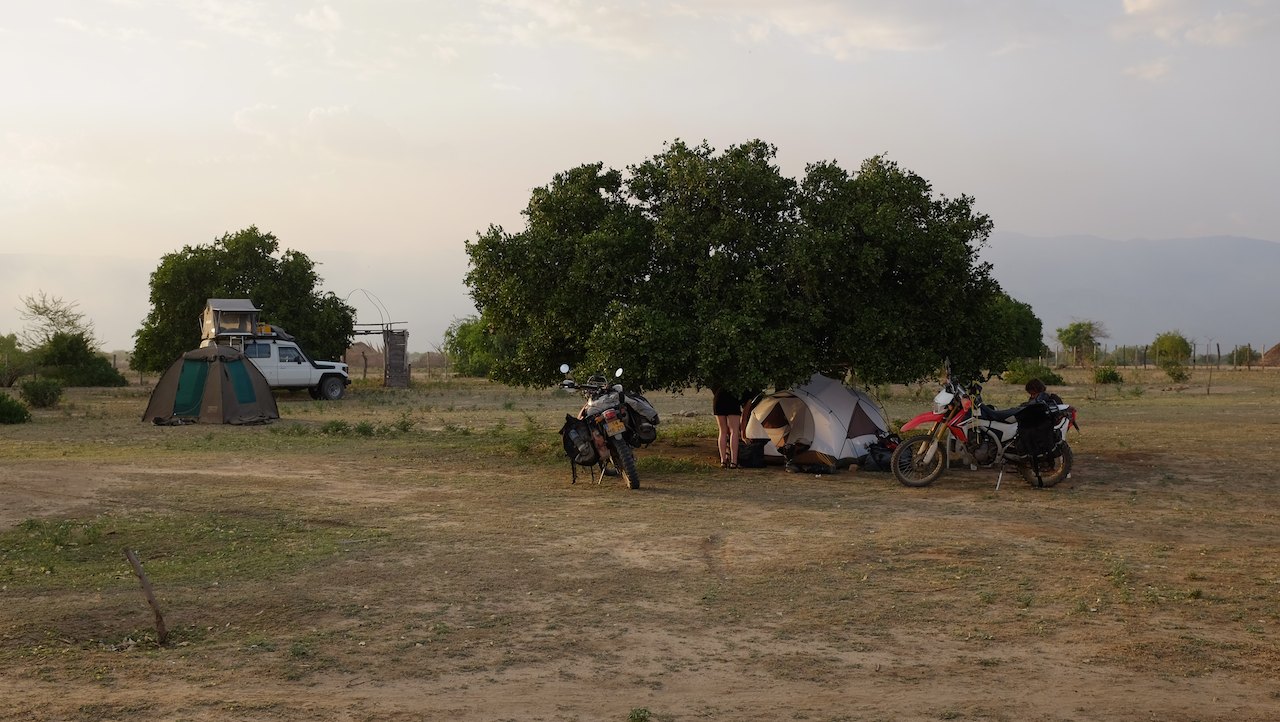

The next day we drive to the south-west, to Turmi. The route is beautiful! Golden yellow gravel paths lined with low acacia trees and the occasional small antelope (dikdik) and beautiful birds. This is the real Africa! We pass several tribal members wo let their cattle graze among the acacia trees. They look beautiful with painted faces, beautiful hairstyles, special clothing and beautiful jewelry. We find them as interesting as they find us. If they have not run off the road in fear, they stands as if petrified with an open mouth staring at us. If we wave at them, we often only get a response when we already are a few 100 meters away.

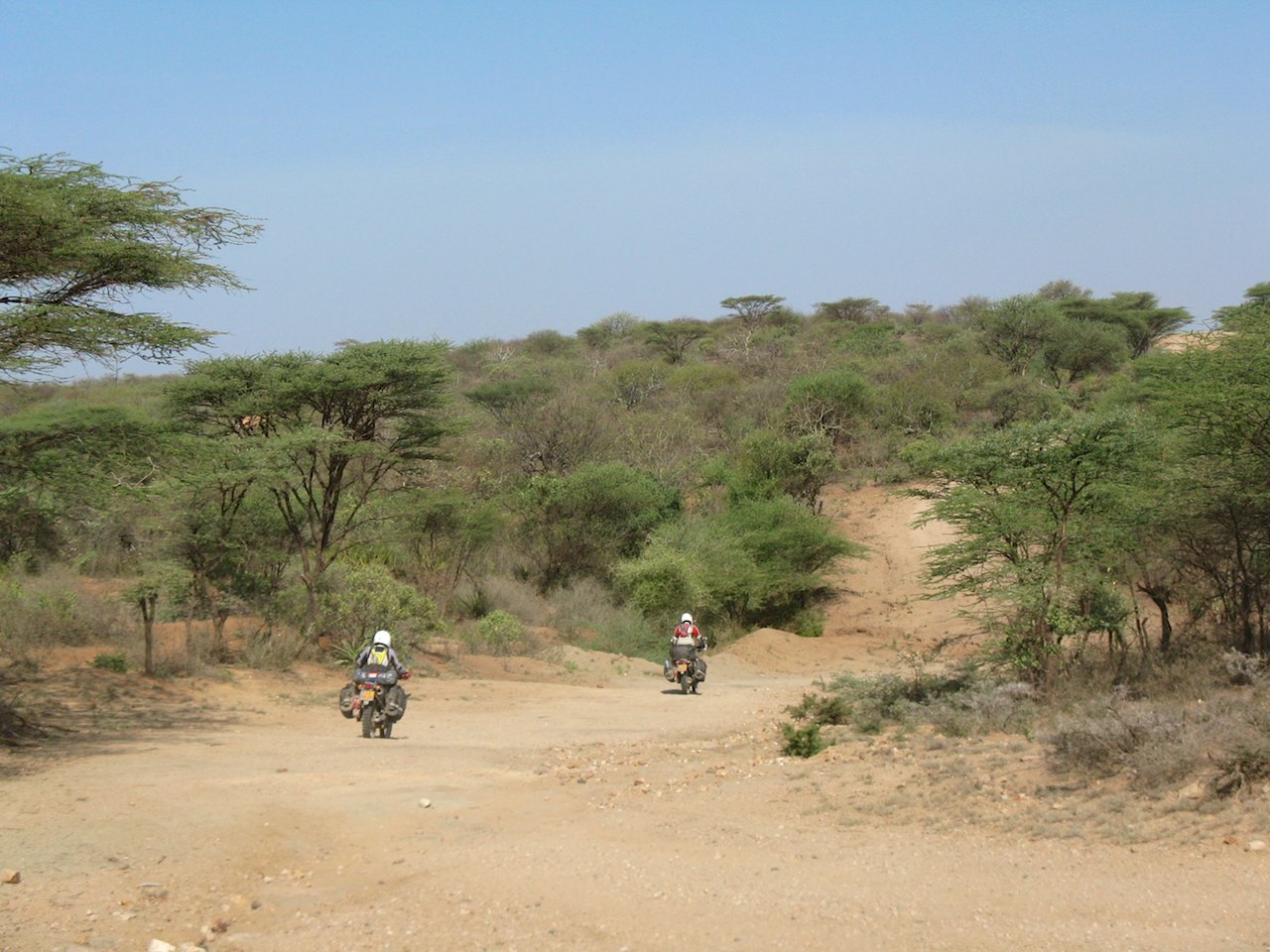
At the end of the morning we arrive at ‘Mango Campsite’ in Turmi. A beautiful campsite along a dry riverbed. We find a spot in the shade of the large mango trees and pitch our tent. Then we get into the car with Pim to go to Dimeka. It is Saturday and it is market day in Dimeka. Hamer-people from the surrounding area all come to the market today to buy and sell stuff. The closer we get to Dimeka, the more villagers we encounter who are on their way to the market with their cattle. Once in Dimeka it appears that all tourists have gathered at the Tourist Hotel. In the courtyard of the hotel a large number of Land Cruisers is lined up. The terrace is full with a large group of Belgians that are listening to the story of their travel guide. Once we have eaten something, we are assigned a guide. He takes us to the market, tells us about the Hamer people and calmly answers all our questions.
Trading on the market is a little quiet. Most of the people seem to have come to the market to chat, to exchange the latest gossip and to flirt. Way more fun than just selling goats. Women and children under one tree and men under another tree in the shade. Most of them wear traditional clothing consisting of animal skins decorated with beads and beautiful necklaces. Some people, especially the younger generation, sometimes wears western clothing and shoes. Especially the younger girls wear a bra over their goatskin. The most particular still remains the hair of the Hamer people. They are known for the ocher-colored clay dreadlocks. They make them with butter and ocher-coloured sand which they smear in their hair. A peculiar sight, but also a peculiar smell. The butter in their hair starts to smell quite bad after a while in the sun. And there is also a strong ‘cattle -scent”. An hour on the market is really enough.


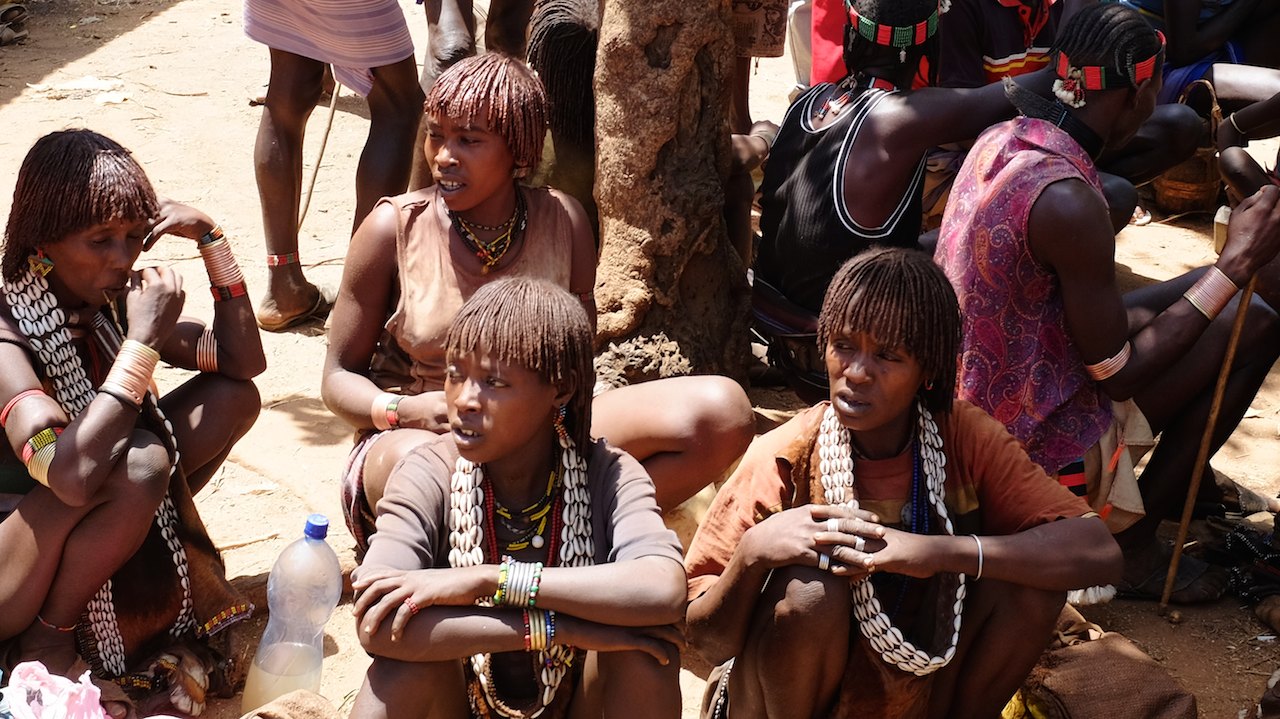
We walk along the stalls and look at all the beautifully dressed people. And all completely at ease, as -for the first time in a long time (and unique to Ethiopia)- we are left alone. There is no one who comes to us to ask for money, for a pen, for water or for food. The people on the market are primarily concerned with themselves and do not seem to take any notice of us. We are now the ones that watch and approach them. It does feel a bit awkward, like being in the Zoo, the way we watch their every move. Even more so since we have to pay for portraits we take after we have negotiated about the price per photo. But still it was very special and definitely worth the visit.
After an hour on the market and a lukewarm coke we get back in the car and back to the campsite in Turmi. Jan and Margriet have now also arrived. We exchange stories, get a tour in their beautiful Land Cruiser Camper and trudge to the adjacent Buska Lodge for a warm  . We hear that a “Bull Jumping” ceremony will take place in Turmi on Monday. We agree to stay in Turmi on Sunday, visit the ceremony on Monday and then together drive to Omorate afterwards.
Distance travelled toTurmi: 12,734km (7,912.5 miles)
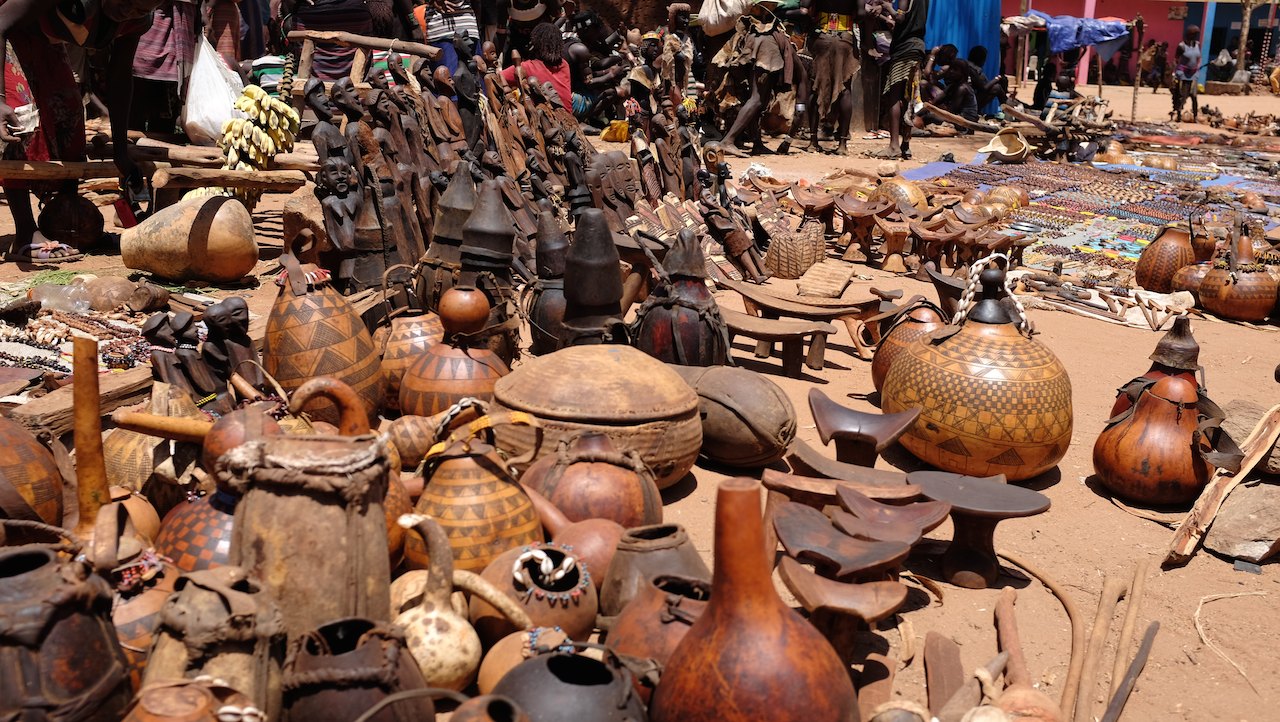
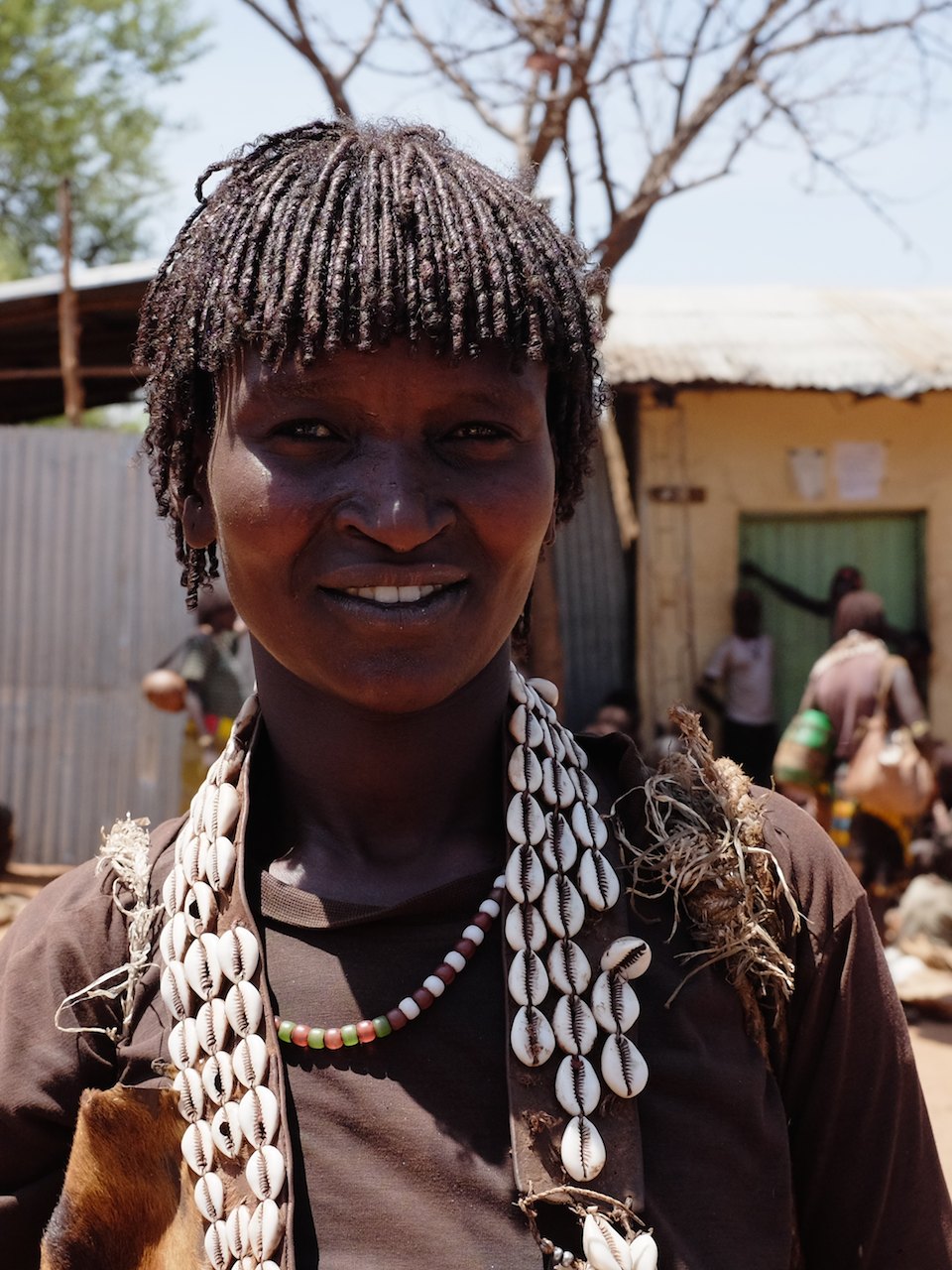
|

19 Feb 2015
|
|
Registered Users
HUBB regular
|
|
Join Date: Dec 2009
Location: The Netherlands
Posts: 66
|
|
|
Turkana Route ll: Bull jumping ceremony
Like in Arba Minch, it is very hot in Turmi. However in the shade of the mango trees and with the breeze blowing through the valley, it is OK. We use the Sunday to relax, to select some photos and to do some maintenance. At the end of the afternoon we walk with Jan and Margriet and Pim to the adjacent Buska Lodge for a  . Not a bad way to spend the day!
Even the next morning we can take our time to eat breakfast and pack the tent, for the Bull Jumping ceremony only begins after lunch. With the help of some guys at the campsite we manage to buy some fuel. There is no gas station in Turmi, but fuel can be found on the ‘black market’. It is slightly more expensive than the gasoline we could get at the gas station in Arba Minch, but still OK. The two boys leave on a small moped to the centre of Turmi and come back a little later with a large white plastic bag containing eight water bottles filled with fuel. It looks good, there is no dirt or water in the fuel, so we feel OK to use this. Especially with the filter we have in our fuel tank. It is enough to top off both bikes. Two days earlier we had also bought some extra food and water in Turmi, just to be sure. Especially the bottles of water were going fast in this hot weather.
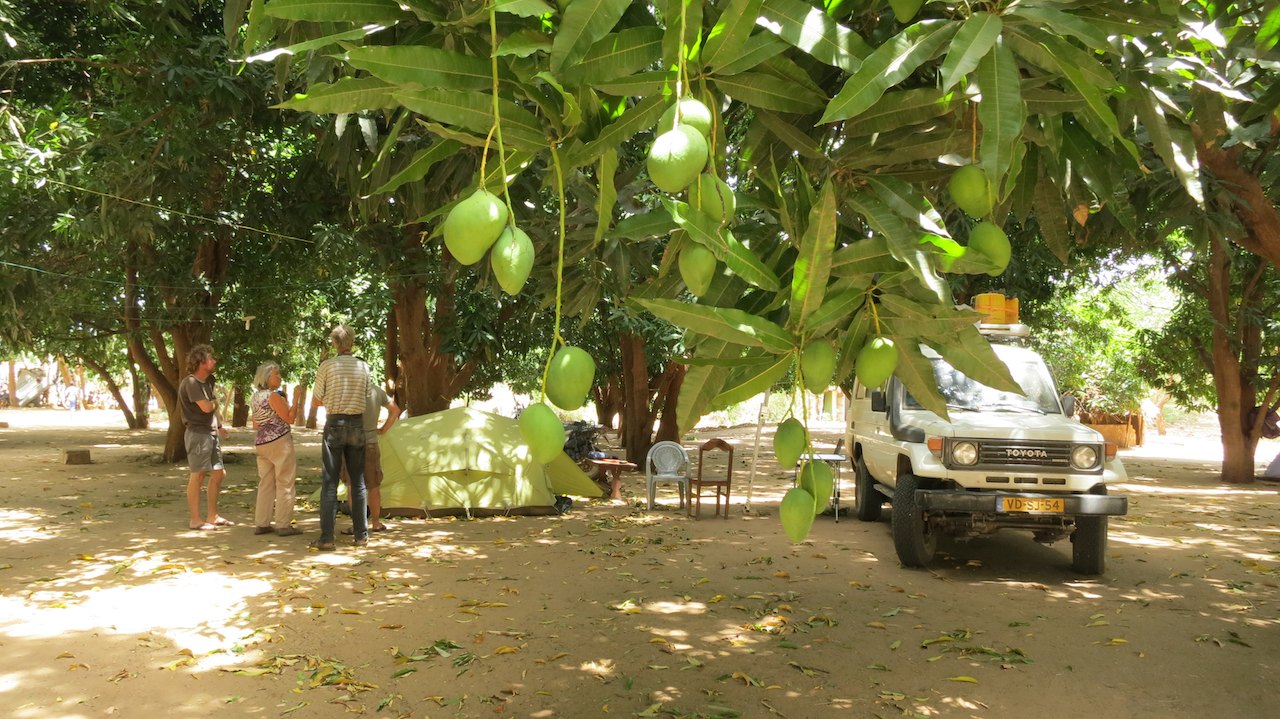
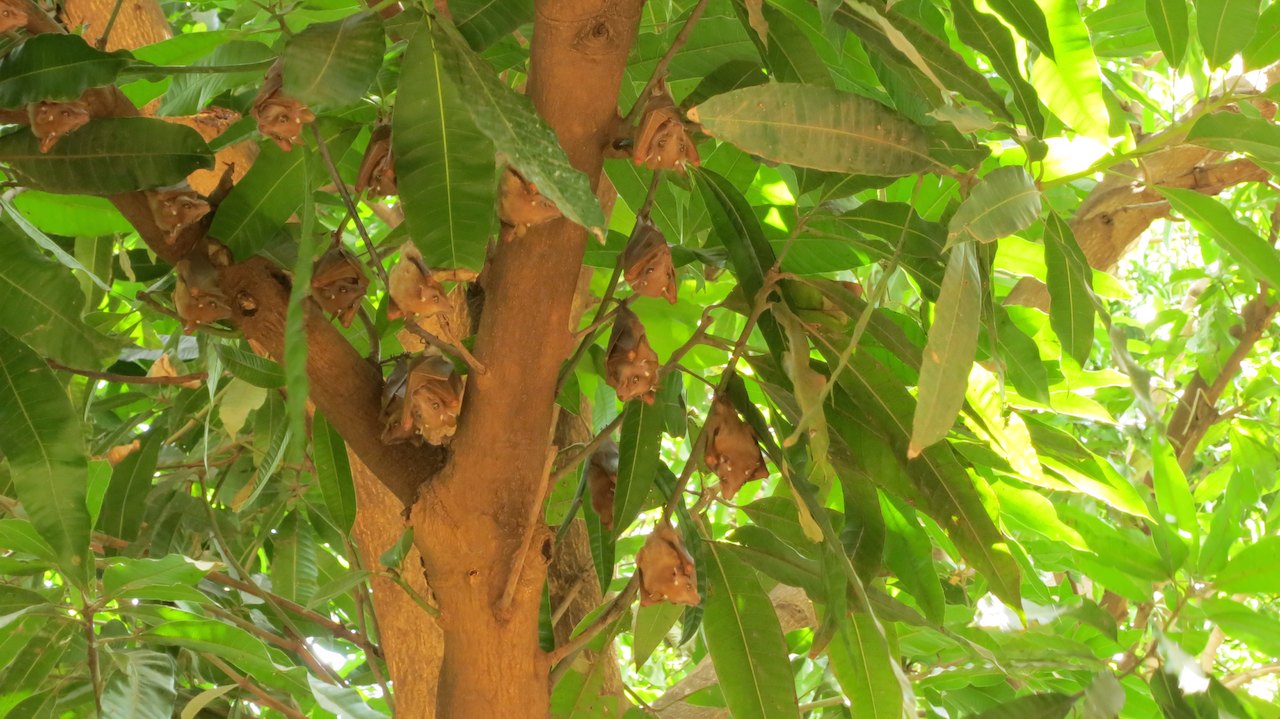

Once the tent is packed and we have had lunch, we drive with Pim, Jan and Margriet to Turmi. In the center a long line of Land Cruisers is blocking the road. There are all packed with tourists that have come to watch the Bull Jumping ceremony. We follow the long line of cars out of town and turn onto a narrow path. On either side of the sandy path we pass a dense acacia forest. Between the trees we catch a glimpse of some goats and cows. We follow the trail a few kilometres until the path is again blocked by a long line of 4x4s. Even more tourists.
We leave our motorcycle jackets, helmets and some other items we carry on the motorbikes in Pim’s car. It is great to travel on motorbikes, but sightseeing is always a bit of a puzzle. We cannot just leave our stuff on the bike everywhere. And sometimes you would also like to take off the suit and the motorcycle boots. A ride from someone else, like the ride with Pim to the market in Dimeka, is really nice because that way we can stroll around the market in our regular clothes and with normal shoes.
With a full Camelbak on my back I follow Margriet further down the path. At the bottom of the path a large group of tourists is standing in the full sun in the dry riverbed. Their attention, cameras and video cameras aimed at the Hamer people sitting in the shade of the acacia trees. They have found the better spot! All the boys from Turmi seem to have taken up the job of ‘guides’. They walk among the tourists to collect the Ethiopian Birrs before the ceremony can begin.
The Hammer girls look beautiful. Not only their beautifully decorated leather clothes and their particular hair due, but also the bells they wear around their calves. It makes a nice sound when they walk. The girls sit down to chat and pose for our photos. I think we are just as interesting to them, as they are to us. Sometimes you see them suddenly all look in a certain direction at the same time and then laugh really hard. Perhaps it is sometimes a good thing we cannot understand them.
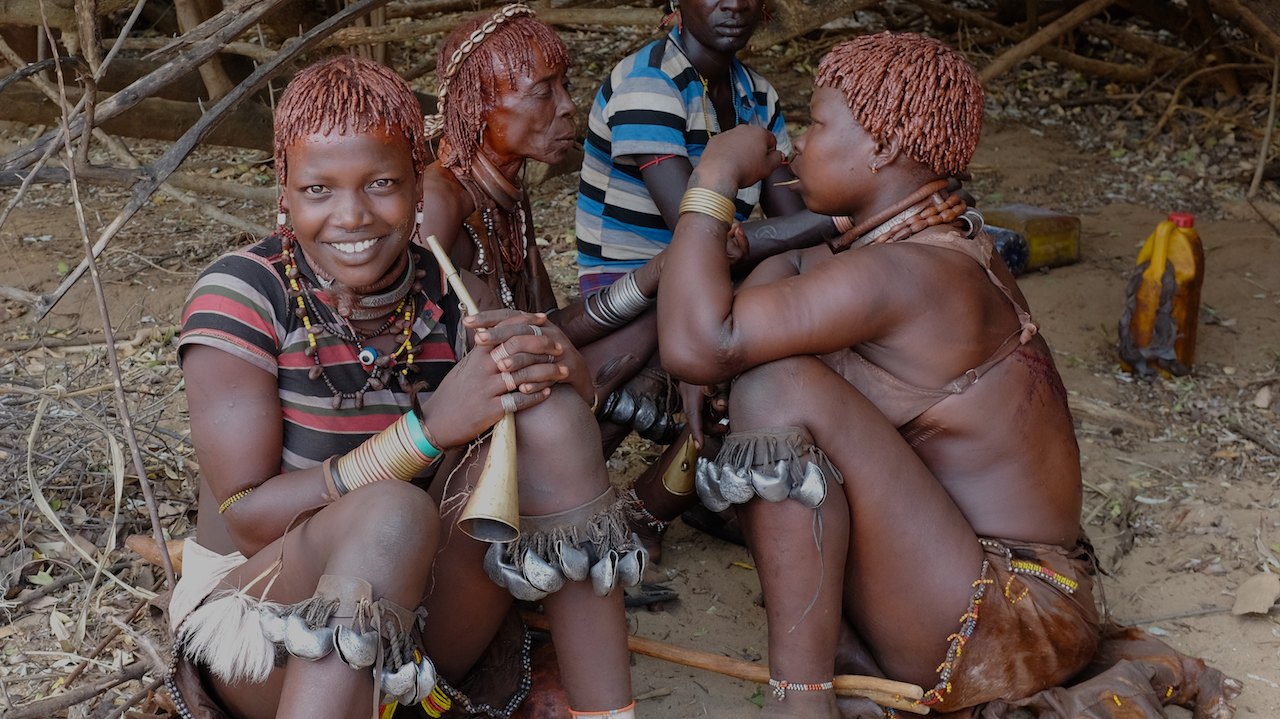
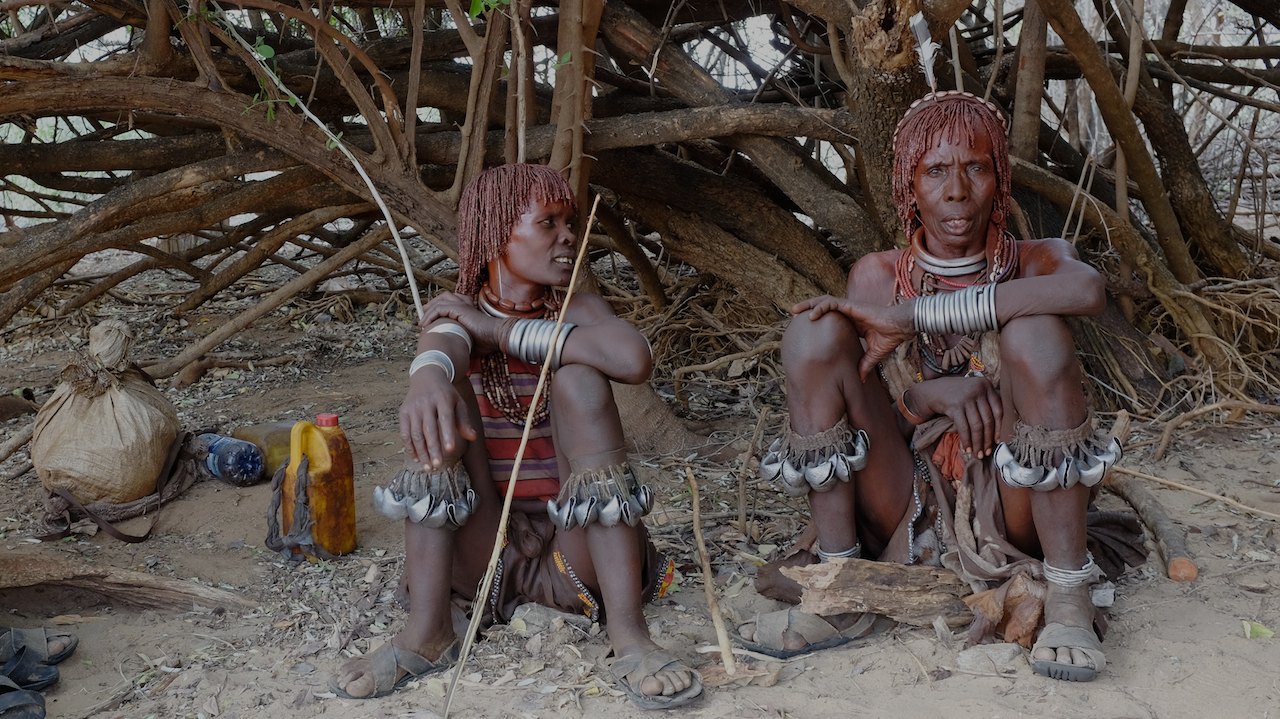
Many villagers have come down to visit the ceremony. It is one of the most important ceremonies in the Hamer society. The ceremony is the culmination of a three-day initiation rite for young Hamer men. On the third and last day of the initiation, the young Hamer man should run naked over seven bulls three to five times. The bulls are then standing in a row next to each other. If he succeeds, he may choose a wife. If he fails, he must wait a year before he can try again.
But that is not all. The Hamer women play an important role in the ceremony as well. To demonstrate their devotion to the Hamer boy jumping the bulls, they are ritually hit with long thin branches. They choose the branches themselves and challenge the boys from the village to hit them with the branches by dancing in front of them while pushing the branches in their hands. When they are hit, the branches bend around their body and leave a deep wound on their backs. The bloody wounds and scars are a sign of honour: the more scars, the greater the status of the lady is. For the same reason, they make the wounds extra dirty to get an even bigger scar. All in all a painful affair. The day begins with the women drinking a local brew (lots of it). We follow the Hamer people over the riverbed to a clearing in the acacia forest. Several women already have gaping wounds on their backs. I have rarely seen such wounds and can imagine that they have been trying to get drunk that morning to prepare for this.
Once in the open space, the tourists form a circle within which the Hamer ladies dance, sing, jump and blow their horns. It sounds very catchy and rhythmic. Next to the dancing crowd, there are some Hamer boys, not older than 16 or 17 years. While the ladies are dancing, they taunt the boys to take their branch and to hit them. We cannot understand what they say to the boys, but it is clearly not friendly. Between the ladies there a real battle is going on to ensure that the boy takes their branch. And once they have tackled the boy to take their branch the woman keeps dancing and singing until a loud slap sounds. SLASH, like a whip of an animal trainer. No screaming, no tears, no shrinkage. She got her tap, a gaping wound on her back and continues to dance to convince the guy to hit her again. But she has had her turn, the other ladies are now crowding around the boy, pushing him around and trying to get their slap. For the ladies a painful affair, but the young men who has to hit them does not seem very happy with the job that was assigned to him either. It is part of the ceremony, but to maim your own aunt, sister or niece might be difficult as well.

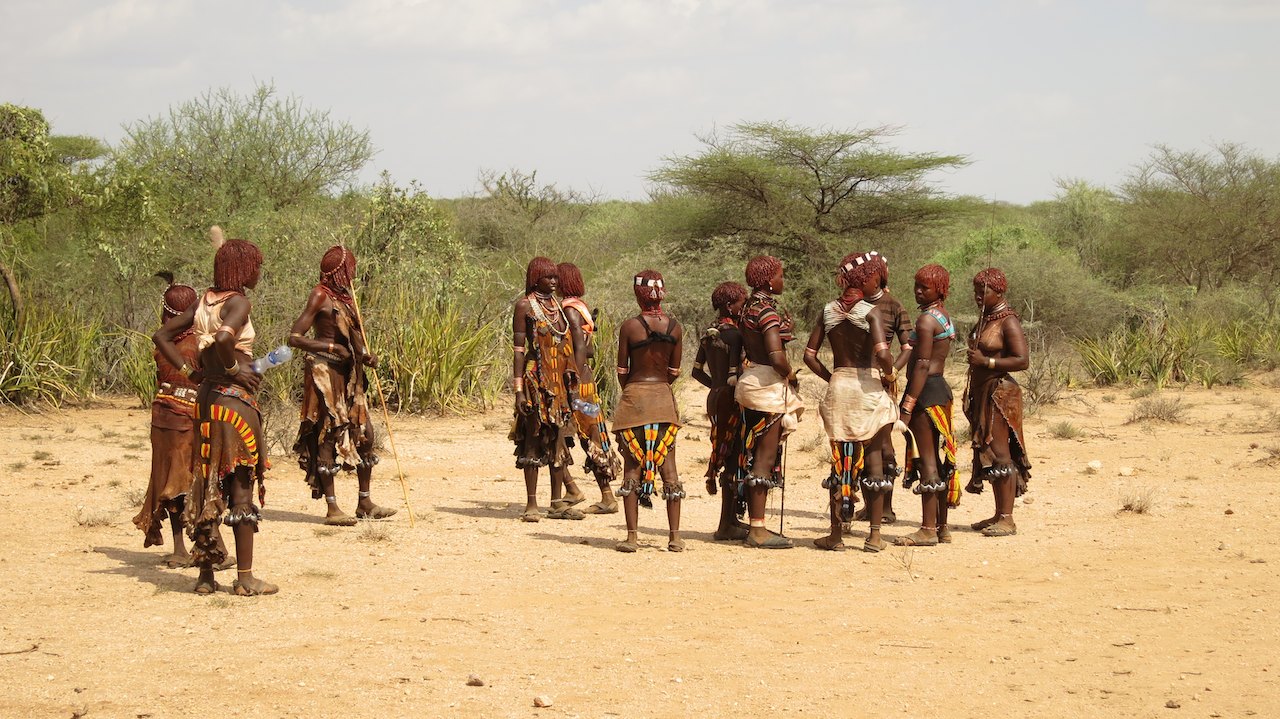
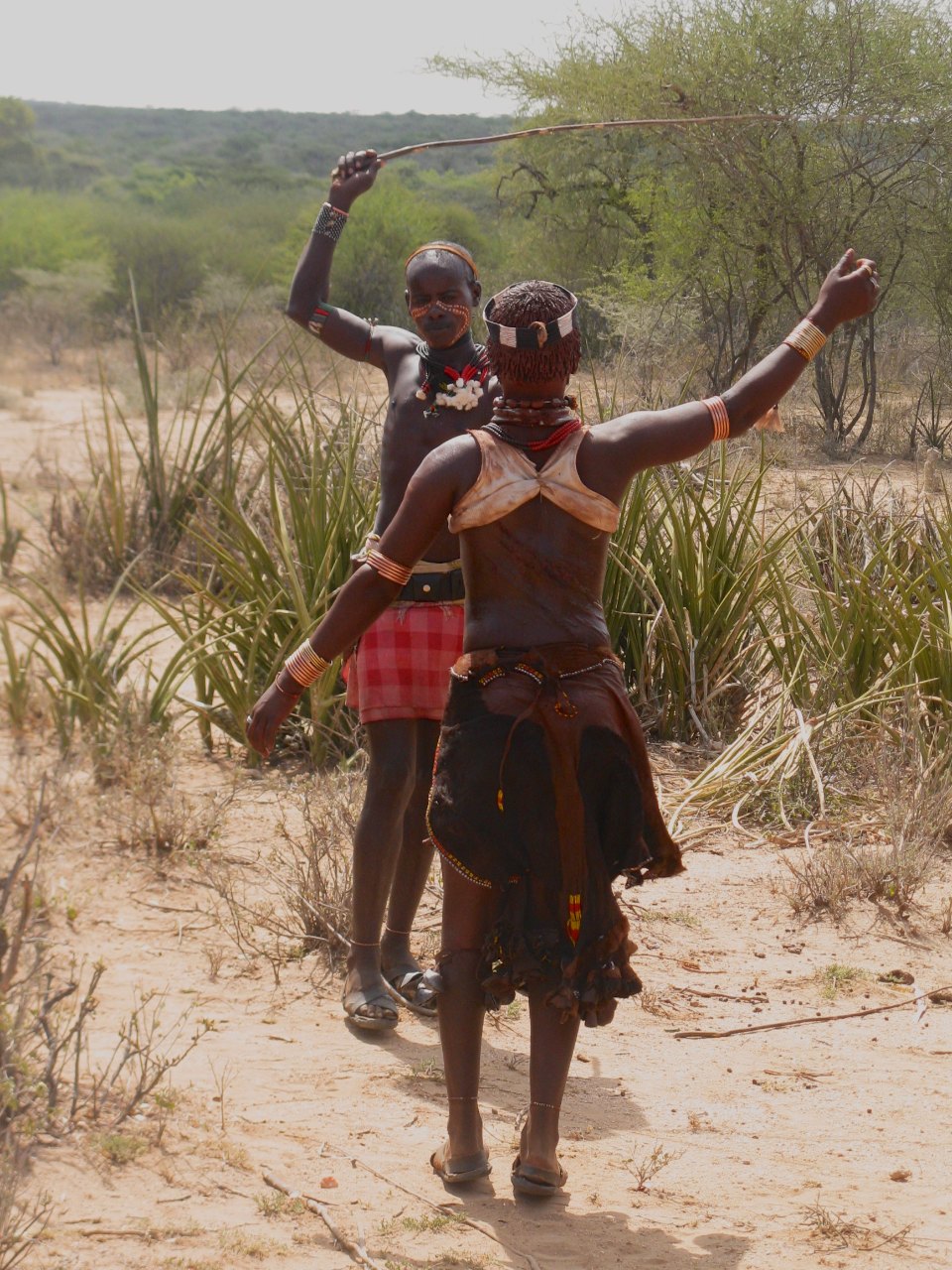
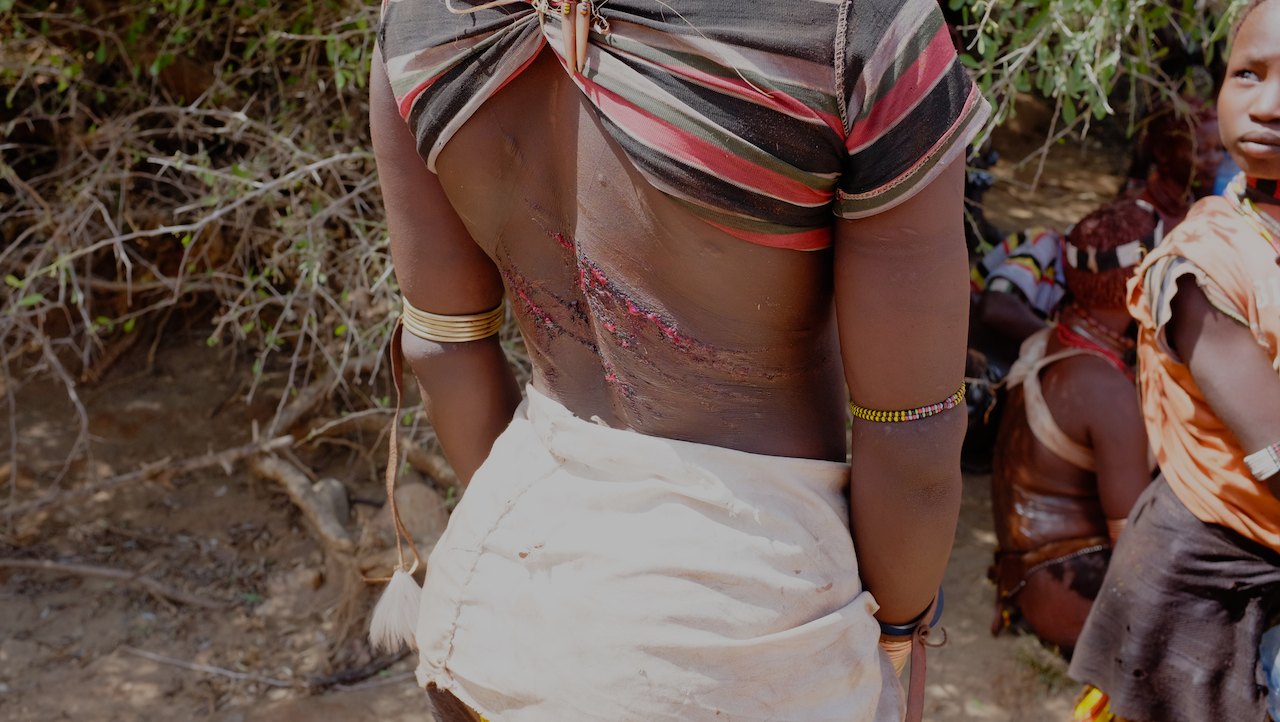
From a distance Margiet and I watch how one after another woman is hit, until I have had enough of it. It is clear that the women choose to be hit, because some of them remain a bit in the background. It usually are the same (most drunk) ladies in the front that get the most hits. But the sound of that branch on their back is so awful that I cannot look at it any more for my own ’amusement’. But then again, I am also the type that watches a scary film through the slits of her eyes while she holds her hands to her ears. Peter, Pim and Jan seem to be less bothered by it.
After this part of the ceremony is over, the bulls come to the scene. A large group of bulls calmly enters the circle of tourists. The men of the village choose a number of bulls and try to put them side-by-side. Not an easy task, because the bulls give a proper fight. The men grasp the bull by the horns and their tail and then try to put it in place.
While the bulls are put in place, the ‘Bull Jumper’ is taken apart by his friends and the men of his family. They form a circle around him in an attempt to keep the tourists away for this part of the ceremony. Something that does not always work, because some tourists put their cameras over the heads of the men to take a picture anyway. Very particular, probably a ’unique photo opportunity’.
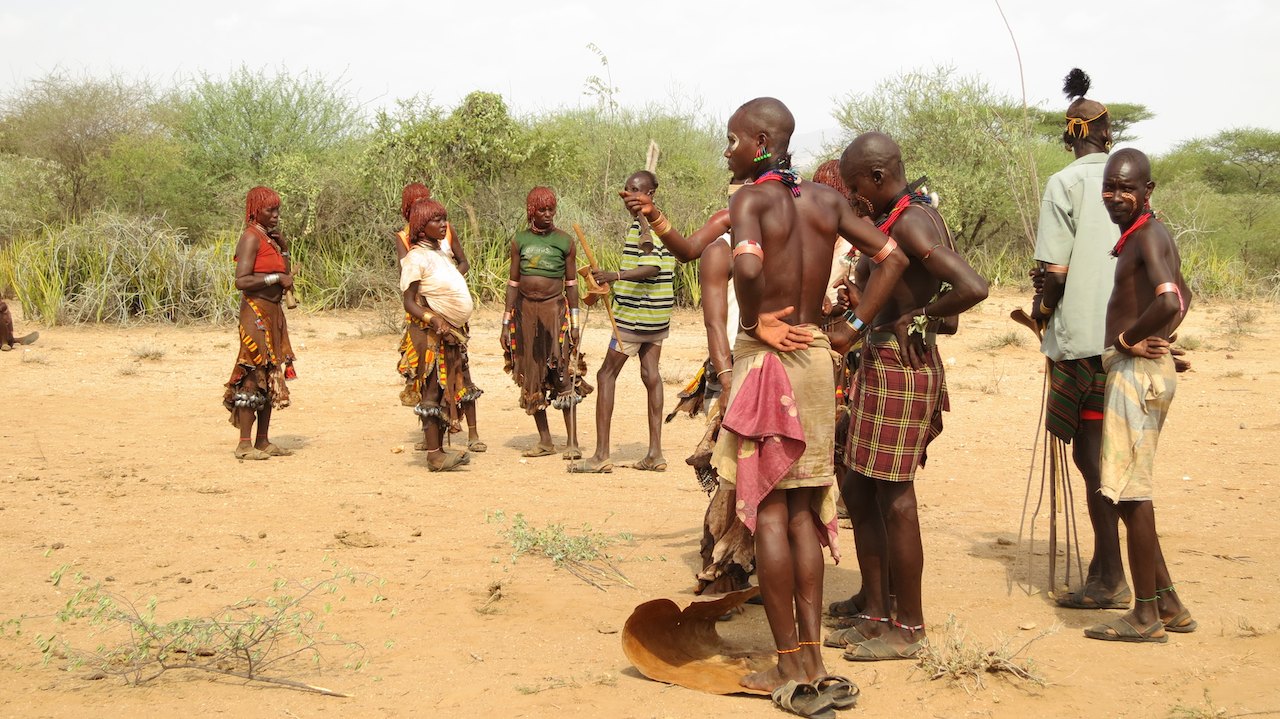
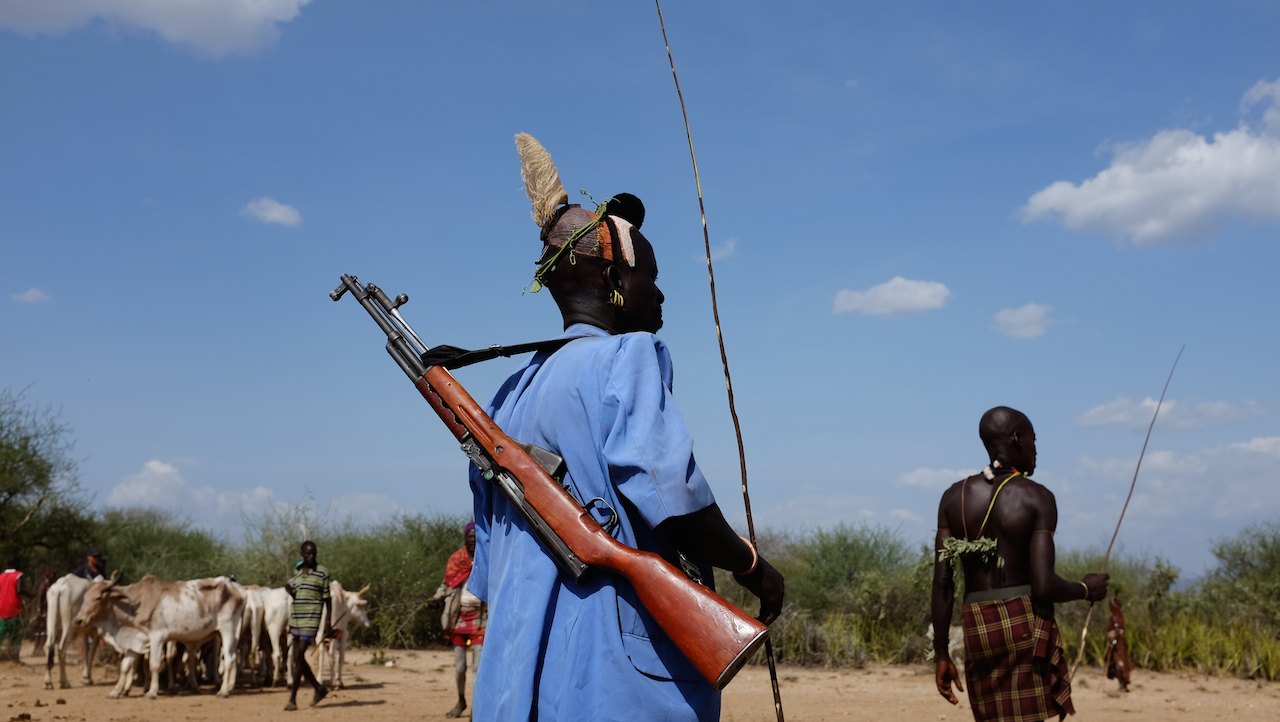
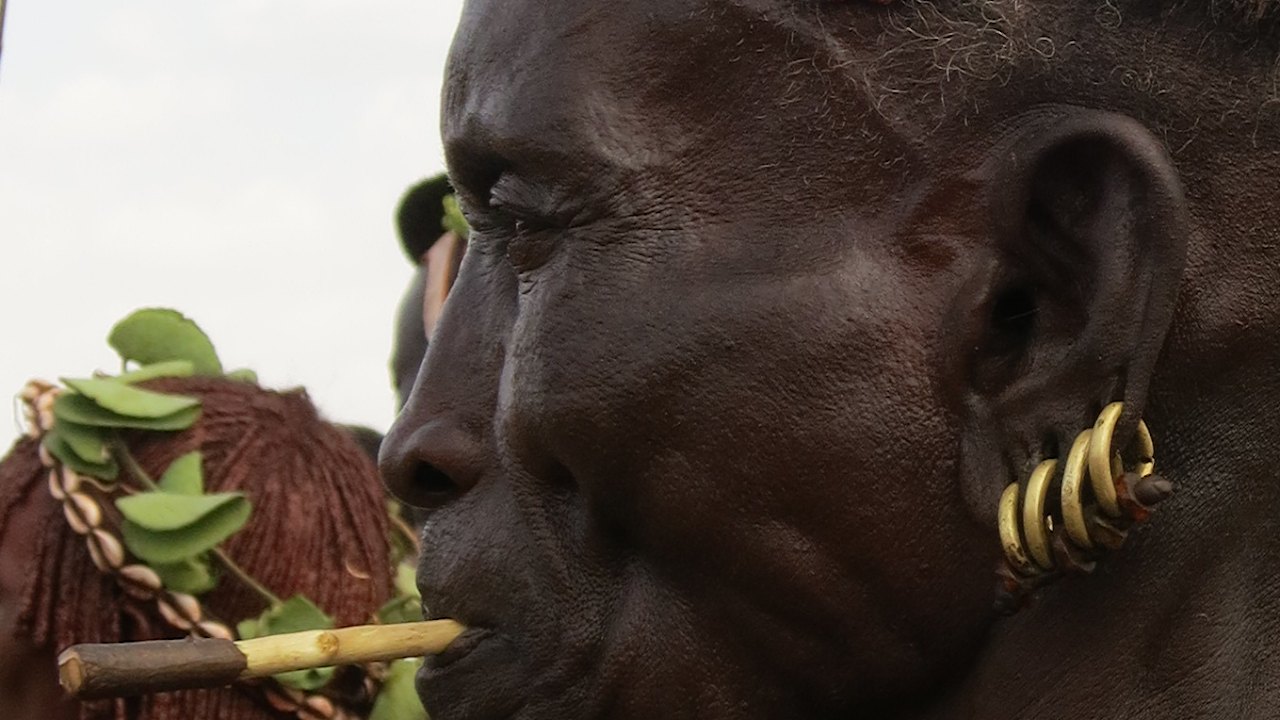
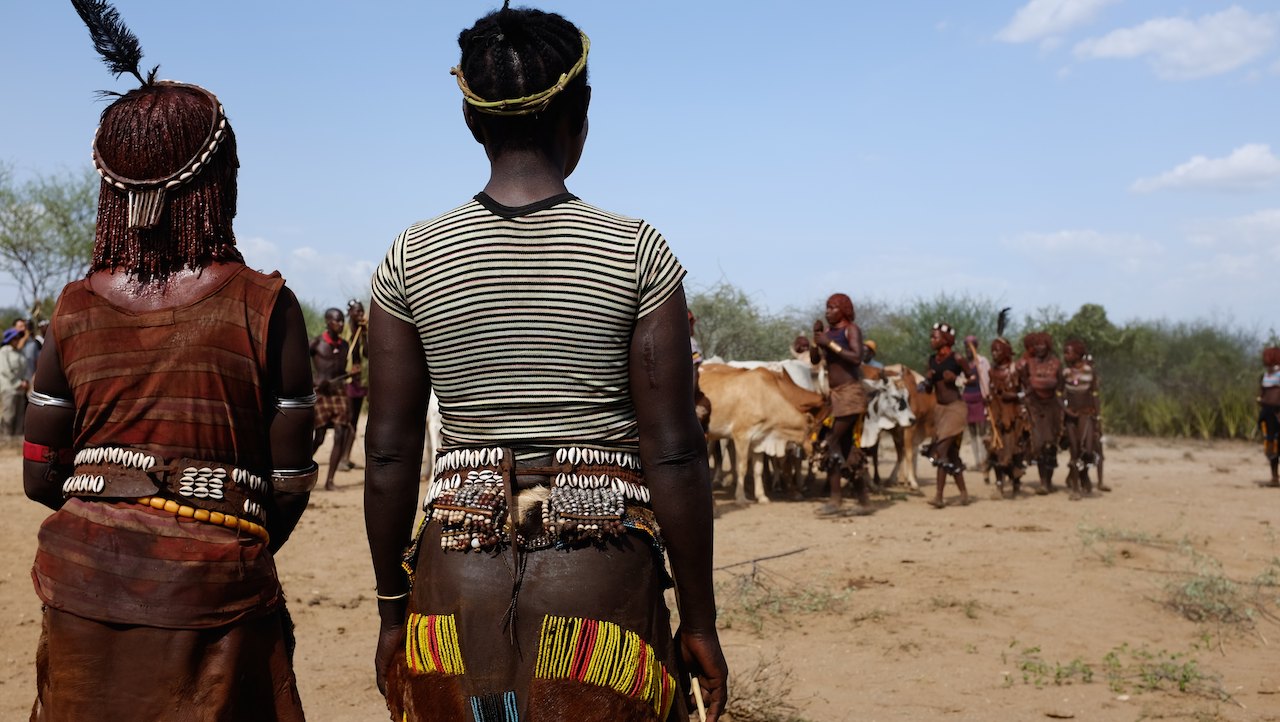
After this part of the ceremony is done, the young man gets ready to jump the bulls. His fellow villagers mingle with the tourists to properly see his attempt. He takes a run-up, jumps on the first bull, run across the backs of the seven bulls and jumps off on the other side. Then he turns around and runs across the row of bulls again. Stark naked he hops from one back to the other. He manages to run back and forth four times. Not the required five times, but from the murmur of approval around us, we gather that he has succeeded. He can choose his wife.
The ceremony is over and the tourists walk back to their cars. With mixed feelings I look at the gaping wounds on the backs of the ladies. It is an ancient tradition associated with their culture, but I personally have some difficulty with the mutilation (often of women) that is part of the ceremony. Moreover, it feels like a ’show’ that is put up for the large number of tourists that is here, which makes the mutilations even more questionable. On the other hand, it is undisputed that the ceremony is still part of the Hamer society and will occur anyway, with or without tourists. It may perhaps feel like a show, but is their right to invite tourists to the ceremony, take advantage of the tourist interest and generate an income therewith.
After the ceremony, we continue our way from Turmi to Omorate. It is dusty and hot, but the dirt road is fine to drive. At the beginning of the evening we arrive in Omorate, the last place in Ethiopia before the border with Kenya. We drink a warm Coke, eat the last enjera we will eat in a long time and then crawl into our tent. Tomorrow the real adventure begins when we ride along Lake Turkana to Kenya!
Distance to Omorate: 12.824km (7.969 miles)
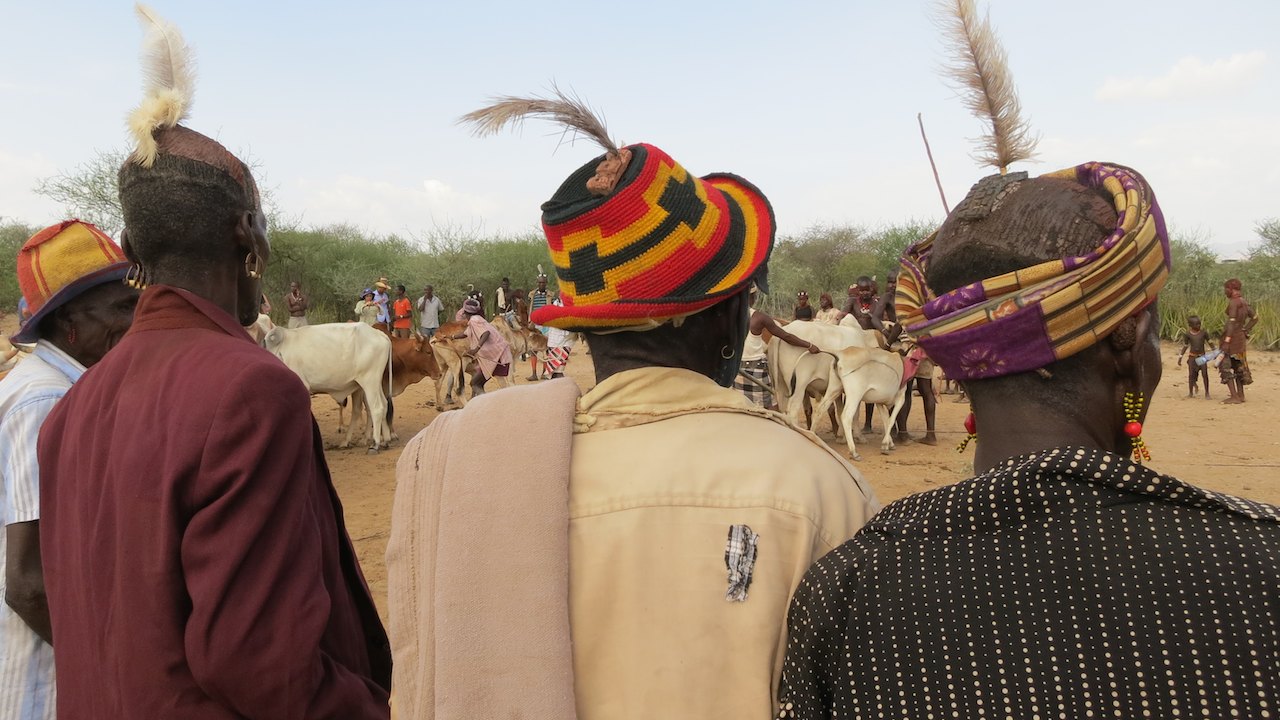
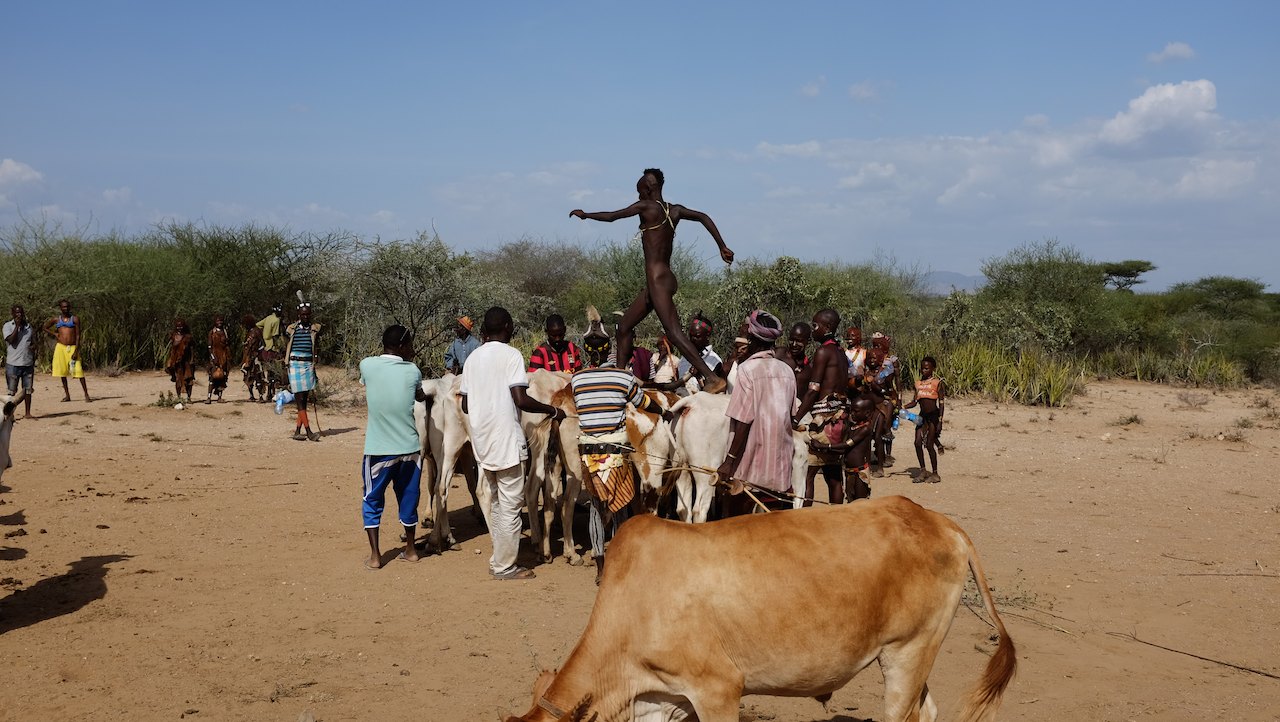
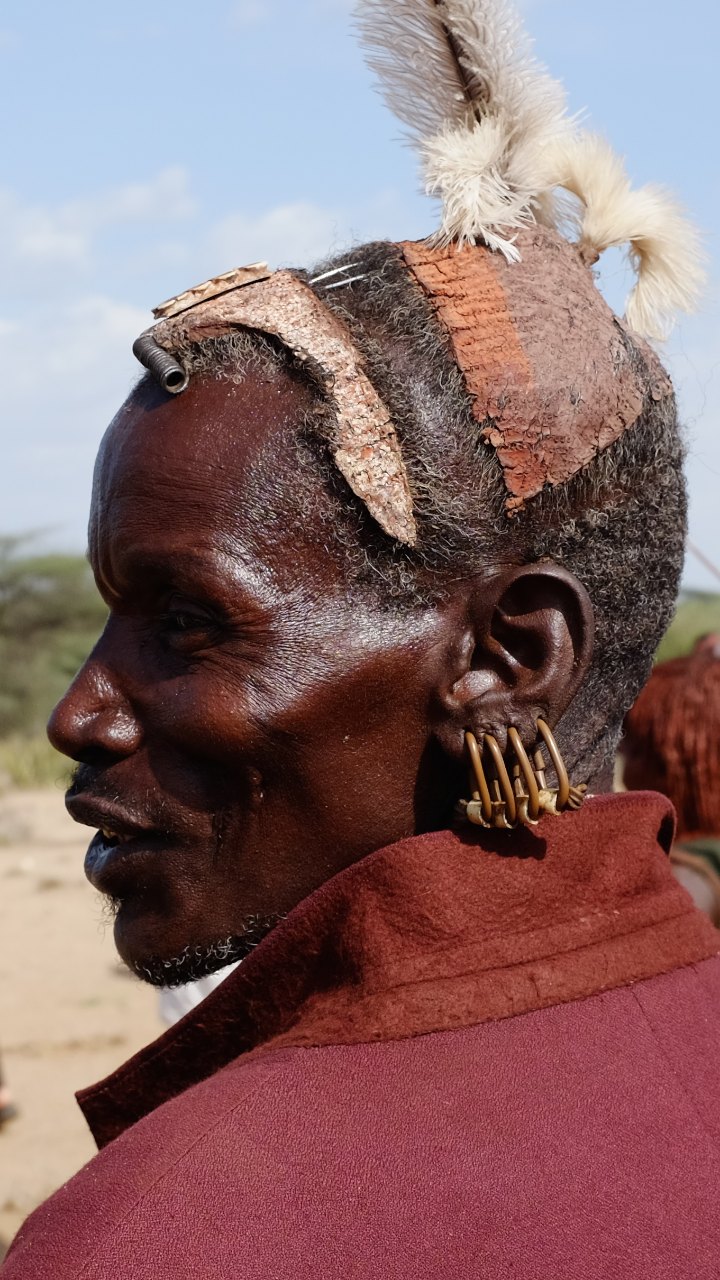
|

19 Feb 2015
|
|
Registered Users
HUBB regular
|
|
Join Date: Dec 2009
Location: The Netherlands
Posts: 66
|
|
|
Turkana Route lll: 1,000km offroad
To know how much fuel, water and food we had to take, we had read several reports of travelers who had done the Turkana route. Travel reports that in the first place describe the adventures on the road. The information about the state of the ‘road’ was quite interesting to say the least. Long stretches of deep sand, a great number of river crossings, paths with loose stones and fields with sharp lava rocks as big as footballs. An additional factor was the weather. It could either be very hot, what makes driving even more difficult, or very wet, which would make the route impassable. Although the travel report also describe how incredibly beautiful the route was, in Omorate I was mainly thinking about the challenges that awaited us. At the hotel where we stayed, we meet a motorcycle rider from Barcelona. A year earlier he left from Omorate to ride the Turkana route on his Yamaha Ténéré. Only 30km outside Omorate he had fallen in the deep sand and broken his leg in two places. It had taken three days and two different planes before he was taken from Omorate to a hospital in Addis Ababa and another year before he could walk normally again. He was now back to patch up his bike and try it again. Impressed by his story, I wonder: What are we getting ourselves into?
Tense and a little nervous I crawl into our warm tent that night. We do not use the fly of the tent to have a little bit of wind through the tent, but it does not seem to help. Sweaty and a little sick, I try to sleep. Half an hour later I run across the courtyard of the hotel in my underwear, because I cannot keep the last enjera of Ethiopia in. I feel horrible. After a sleepless night, we pack up early the next morning. We can put our duffelbags in the back of Pims car, just like the groceries we buy that morning. After we have changed our Ethiopian money, we drive in convoy to the customs office. Half an hour later we have stamps in our passports and our Carnets de Passages. We leave Omorate.
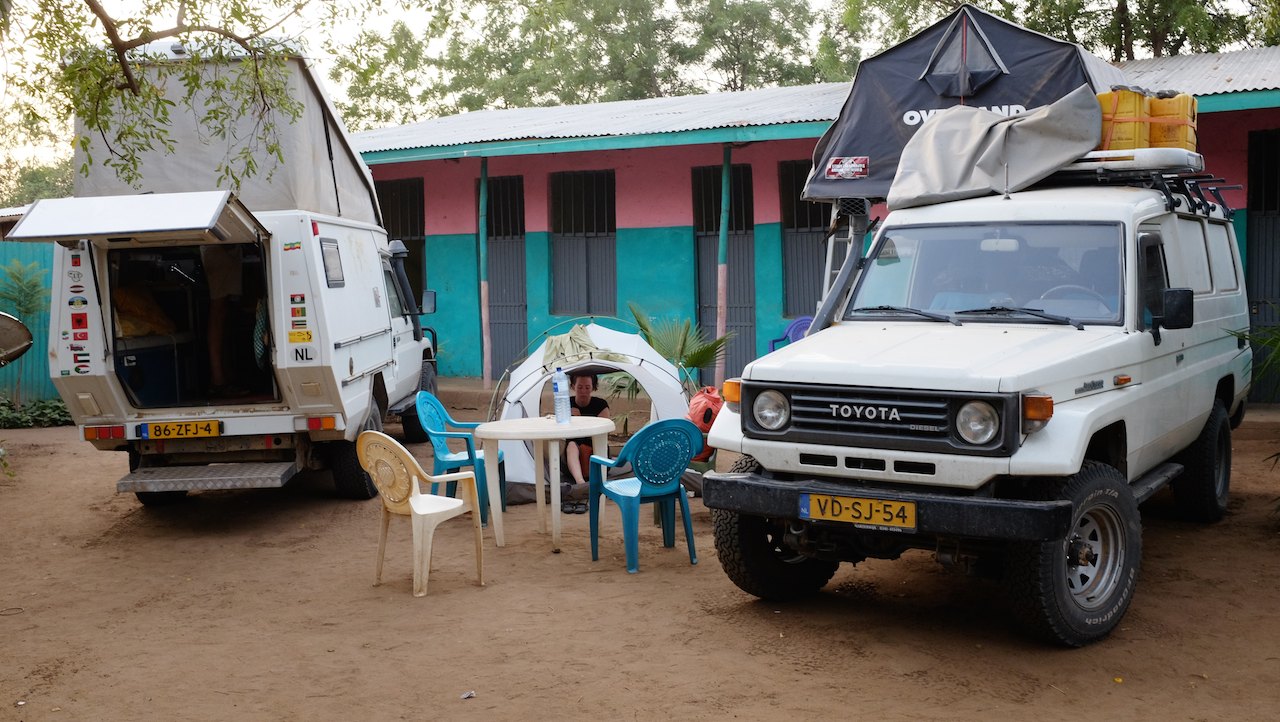
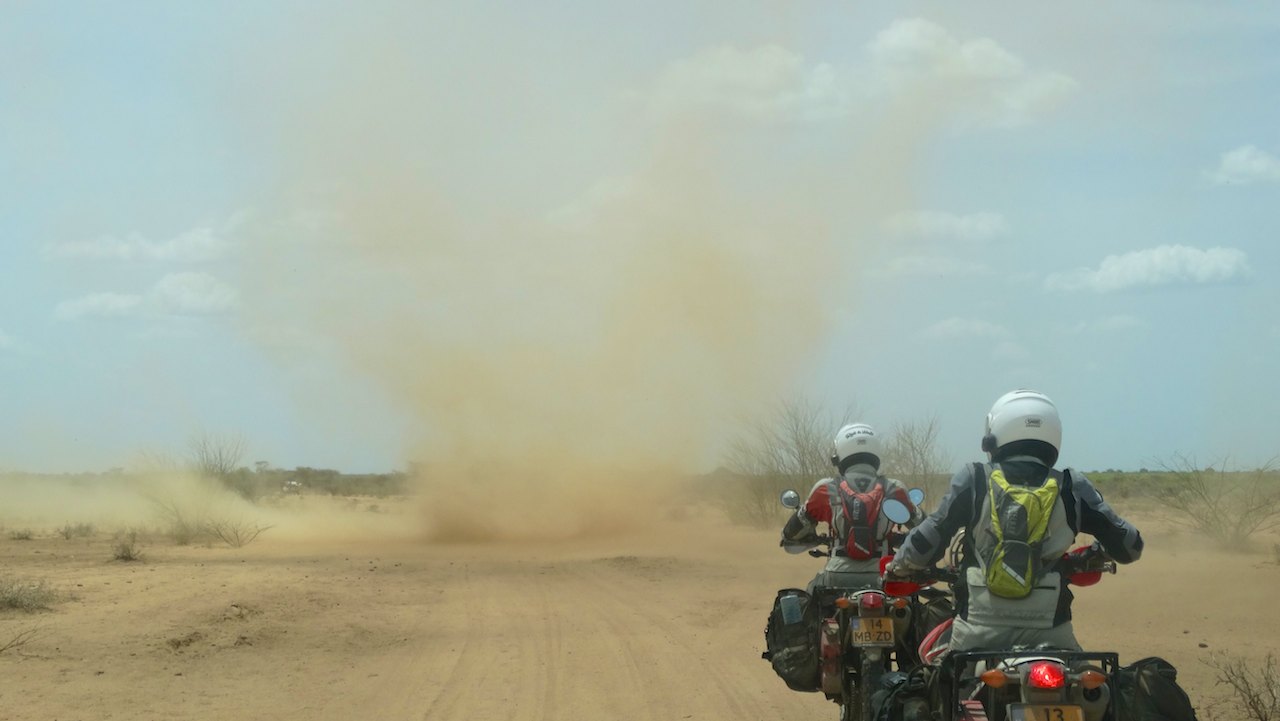
Just outside Omorate we turn right, onto a sandy path. It is just wide enough for one car, you can not really call it a road. In some parts the sand is very deep. We are less than two kilometres on our way when my bike swerves all over the place. I can barely keep it upright. This starts well. Peter comes running with a tire pressure gauge and together we let some air out of the tires. With the softer tires riding is much easier in the loose sand. Standing on my steps and hanging on to my handlebars to keep my front wheel up, it goes pretty well. In sections where the sand is deeper, I remember the offroad course that we followed with Toine van Dijk. It is as if he is riding next to me: “ Gas, gas, hit the gas Leonie! And shift now!” It feels unnatural, because when my motorbike starts swabbing I would prefer braking and putting my feet on the ground, but that is only more difficult. So speed it is!
With every kilometre we ride, it is going better and my confidence is going up. We are not going fast (no faster than 40km per hour), but we are making sufficient progress. Before I know it, we even drove through several dry riverbeds. Even that appears to go just fine, especially on these light motorbikes. I am so glad we left our big Hondas (Africa Twin and Transalp) at home!) In some riverbeds we have to drive through really deep sand. It reminds me of the deep, loose sand you would find at the beach just below the dunes. With my feet on the ground, I strum in first gear through the track in the sand. Not really ‘Dakar-material’, but that is how I keep my bike upright and my stuff and especially myself in good shape.
Peter and I drive in front, Jan and Margriet behind us and behind them is Pim. This way we are less affected by the dust their cars throw up and they can better keep an eye on us. The sand is much less of a problem for the cars. The only risk is that they get stuck in the deep sand in the dry riverbeds, they will not topple over. In the deep stretches of sand where I ’walk’, Jan waits behind me to drive through the sand at high speed as soon as I am at the other side. It looks impressive.
There are multiple tracks through the sand and sometimes it is quite hard to find the right one. We use ‘ Tracks4Africa ‘ on our GPS, which shows routes that were previously ridden by others. Together with Jan, who sees the route on his iPad, and Pim, who has a newer version of Tracks4Africa, we manage to find the right paths.
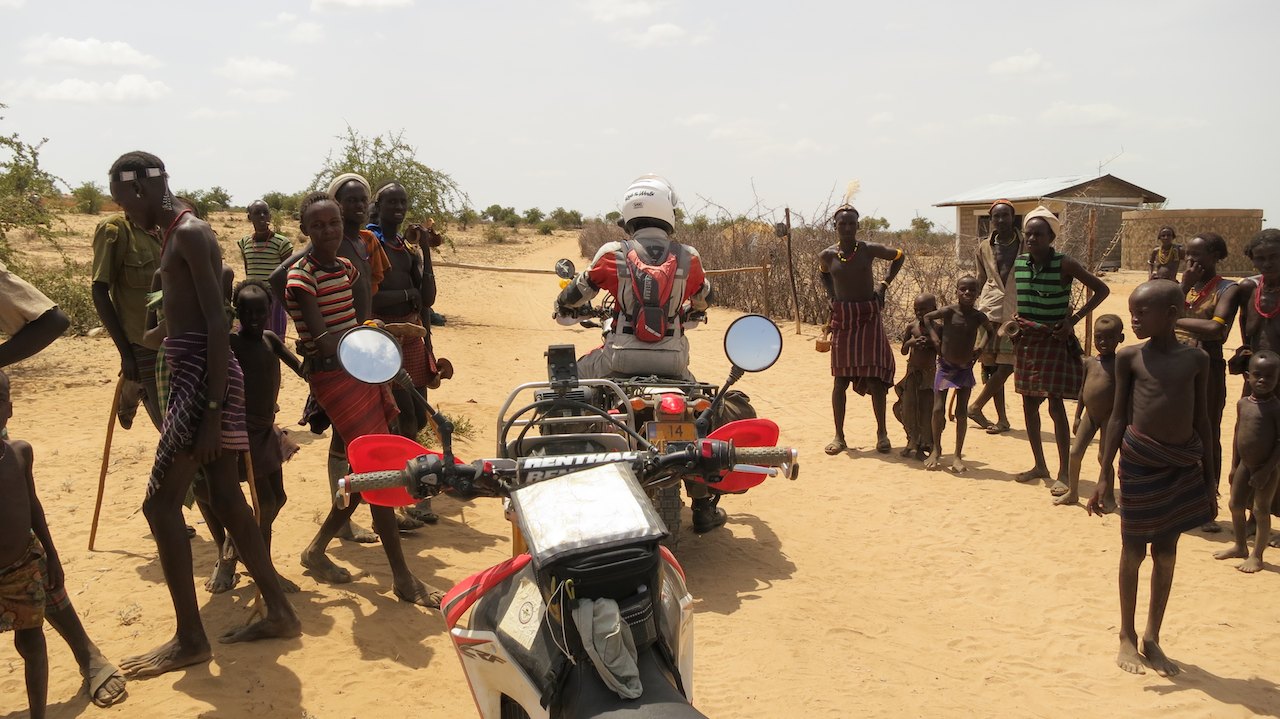
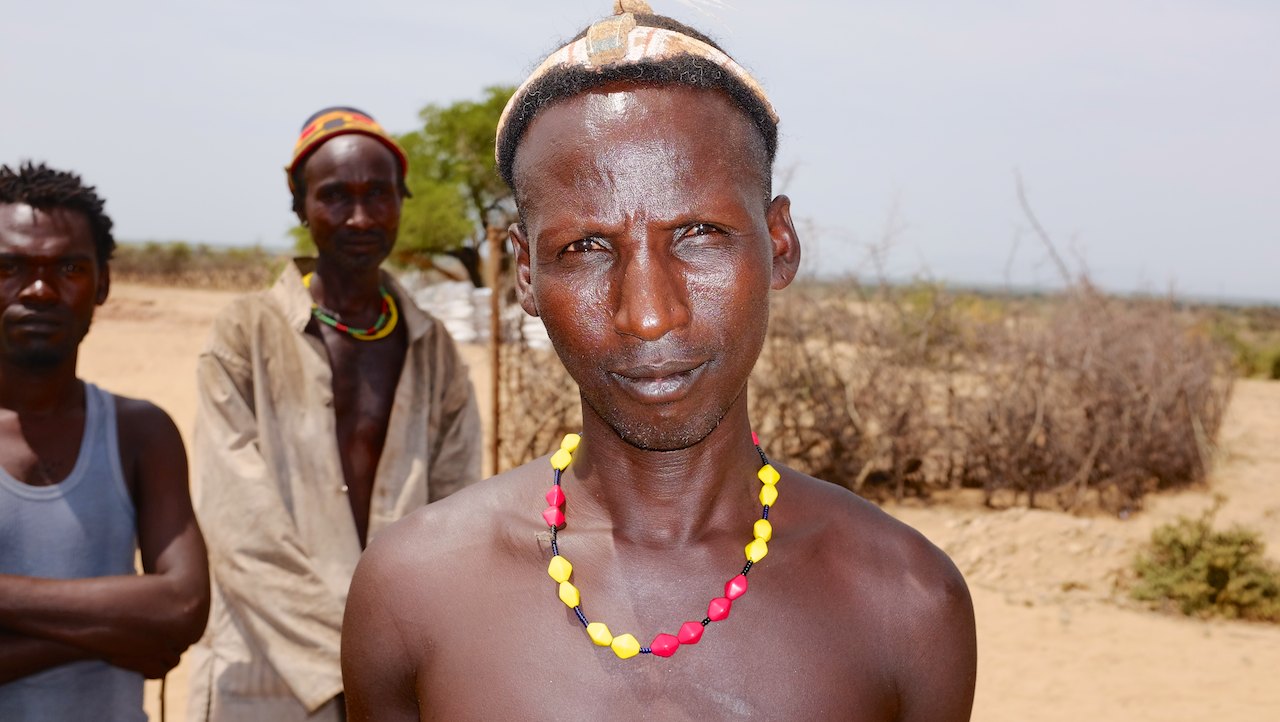

We sway over the track on the dry savannah. We pass several small settlements, where a few huts form a little village. In several villages we encounter a barrier that is lowered over the path. We stop and are quickly “encircled” by a large group of interested people. We are just as interested in them, as they are in us. They look beautiful with traditional clothes, jewellery and impressive weapons. After we tell them where we are going, the gate opens and we are allowed through. We pass through a number of villages where we are stopped before a barrier or a rope. In the fourth village we seem to be at the border with Kenya. There are two police officers in uniform and once we stop we are greeted with a cheery; “ Jambo, Mzungu!”, Swahili for “ Hello, white man.” Now we know for sure, this is the border with Kenya!
There is no customs office and we cannot get a stamp in our passports here. That will be of later concern. After a brief chat, one of the officers opens the barrier: “ Karibu Kenya” ( Welcome to Kenya!). On dusty dirt roads we drive further south. For the first time we can now see Lake Turkana. The path leads us through a village with small huts where freshly caught fish is dried. Mid-afternoon we arrive in Illeret, the first slightly larger village in Kenya. Here we have to register with the police. We are welcomed by Victor, who takes our passports and shows us where we can get a ’cold’ soda while he takes our details. The warm Sprite tastes good after the efforts of that day. Again, we cannot get a stamp in our passports here. Stamps, we must eventually get in Nairobi.
If everything is noted, we leave Illeret and drive to the entrance of Sibiloi National Park. We will not drive through the park, but along the park boundary. As we drive to the east, away from the lake, the trail slowly changes structure. We no longer driving on sand, but across large round stones. The road winds up and down. At the end of the afternoon we find a flat plateau that overlooks Sibiloi National Park, a great place to camp. With the shovel of Jan we clear a piece of land as big as the groundsheet of our tent. At dusk we cook some pasta and make a sauce of tomatoes, onions, garlic and some spicy herbs. It tastes great! Satisfied we look back on a successful first day. Driving through the deep sand went better than I had expected and the motorbikes were perfect. A little more confident and a lot less tense we crawl into our tent early that night.
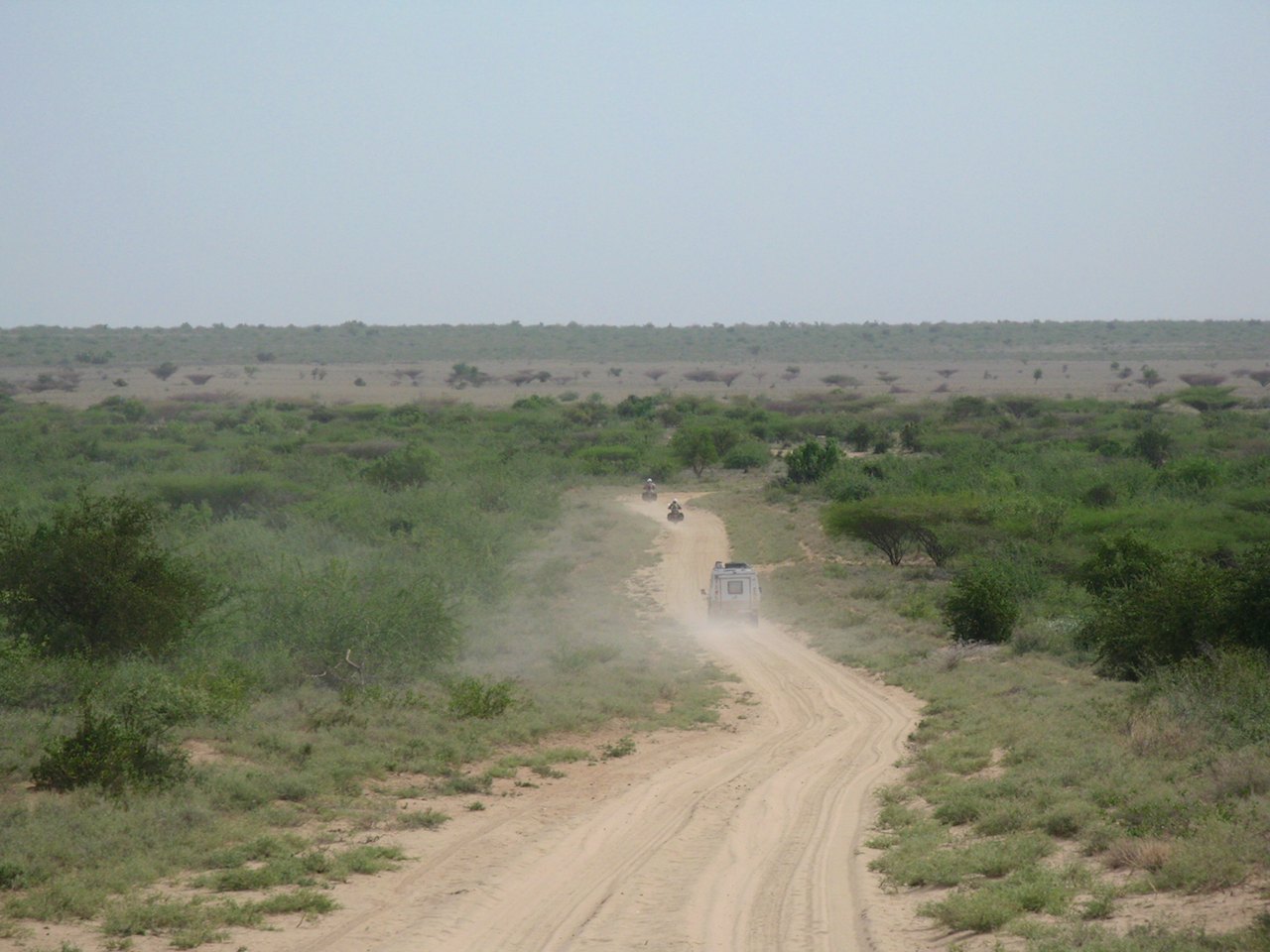
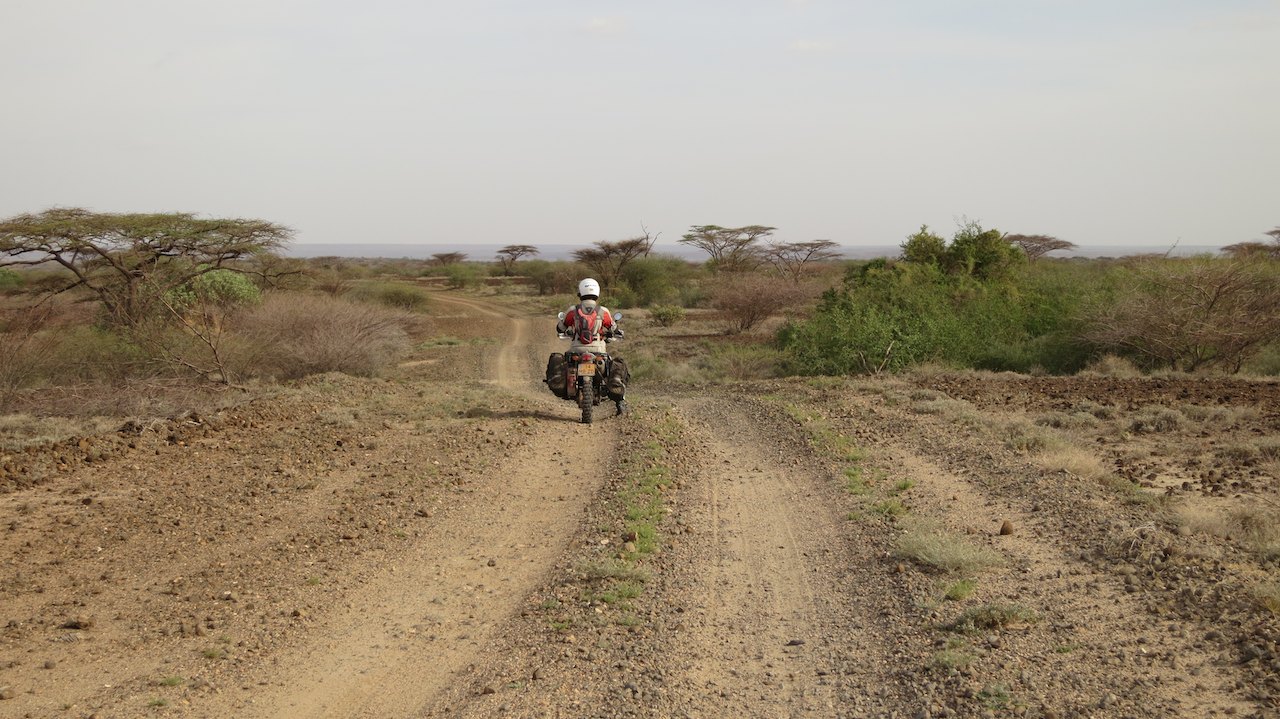
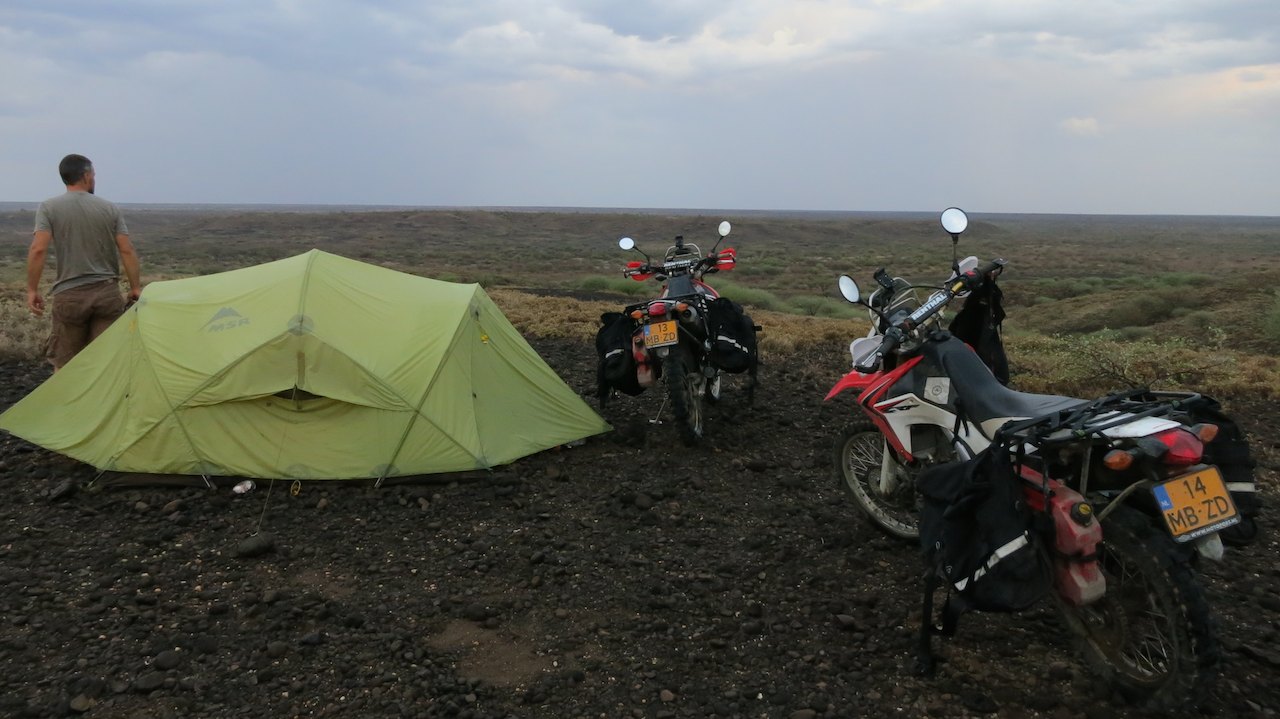
Halfway through the night I am again standing outside in my underwear. This time not because of the food, but to cover the tent with the flysheet because of the rain. And not just rain, but a downpour with crackling thunder. The worst heat is now out of the air, so sleeping is a little easier now. We will see tomorrow what the rain has done to the road. The alarm goes early next morning. After a breakfast of dry bread with jam and a cup of tea, we pack everything again. Breaking down the tent, packing the bags and putting on our suits, takes quite a lot longer than the time Jan and Margriet need to prepare their Land Cruiser for departure. Pim is also a lot faster with collapsing his roof tent. It might have some advantages to travel by car.
The route takes us along the park. The road is not really deteriorated by the rain and the river crossings are still (or again) dry. Peter rides in front of me and is more or less our ’spotter’. He is clearly a lot better in riding offroad, because he can also enjoy the scenery. While I try to manoeuvre my bike on the paths with my tongue out of my mouth, I hear over the intercom about all the birds and animals he sees. He is a good spotter and also sees the first ‘wild animals’; a group Topi antelope. Around the national park is no fence and the animals naturally are not bothered by the park boundaries. From a distance we look at each other. Only when we turn off our motorbikes to make some pictures, they run away.
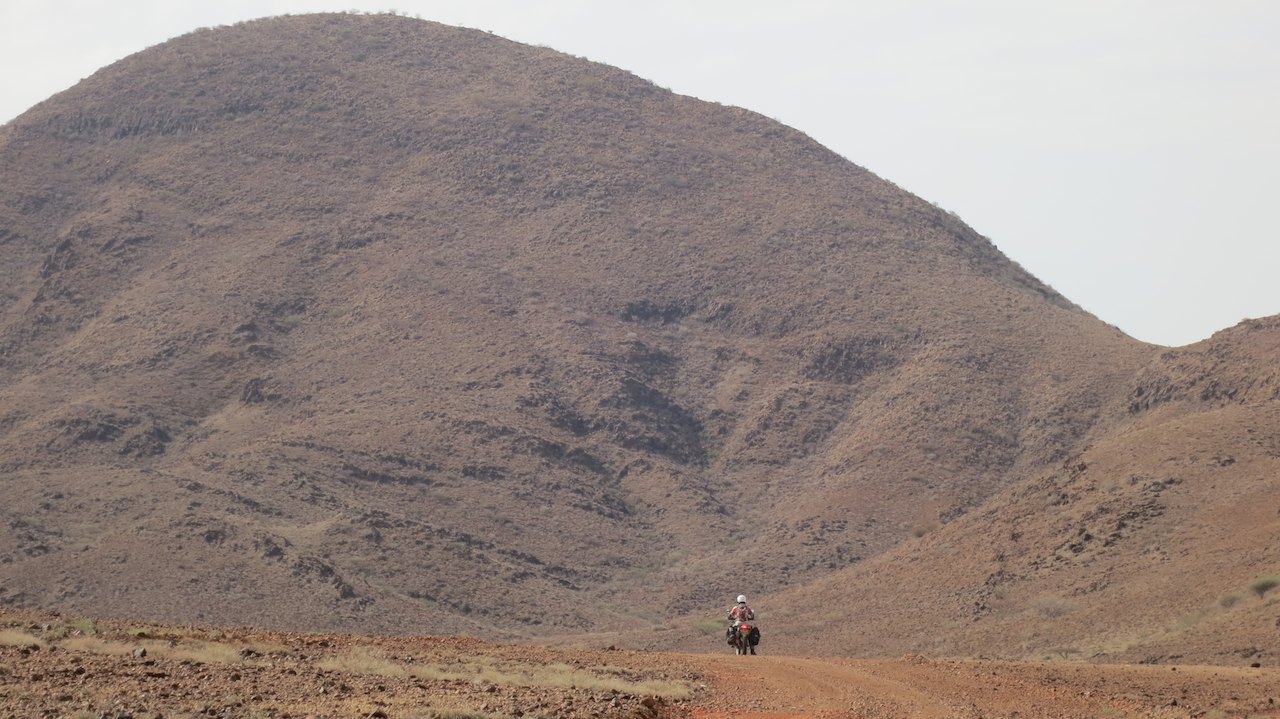
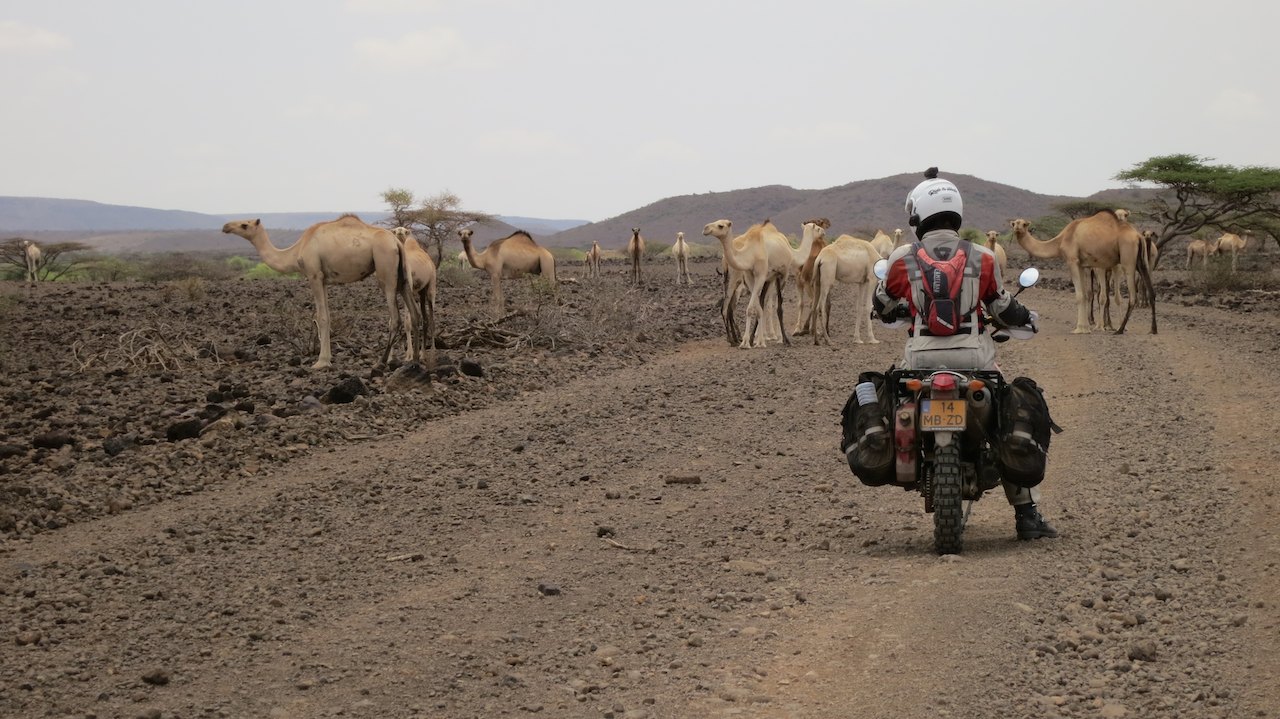
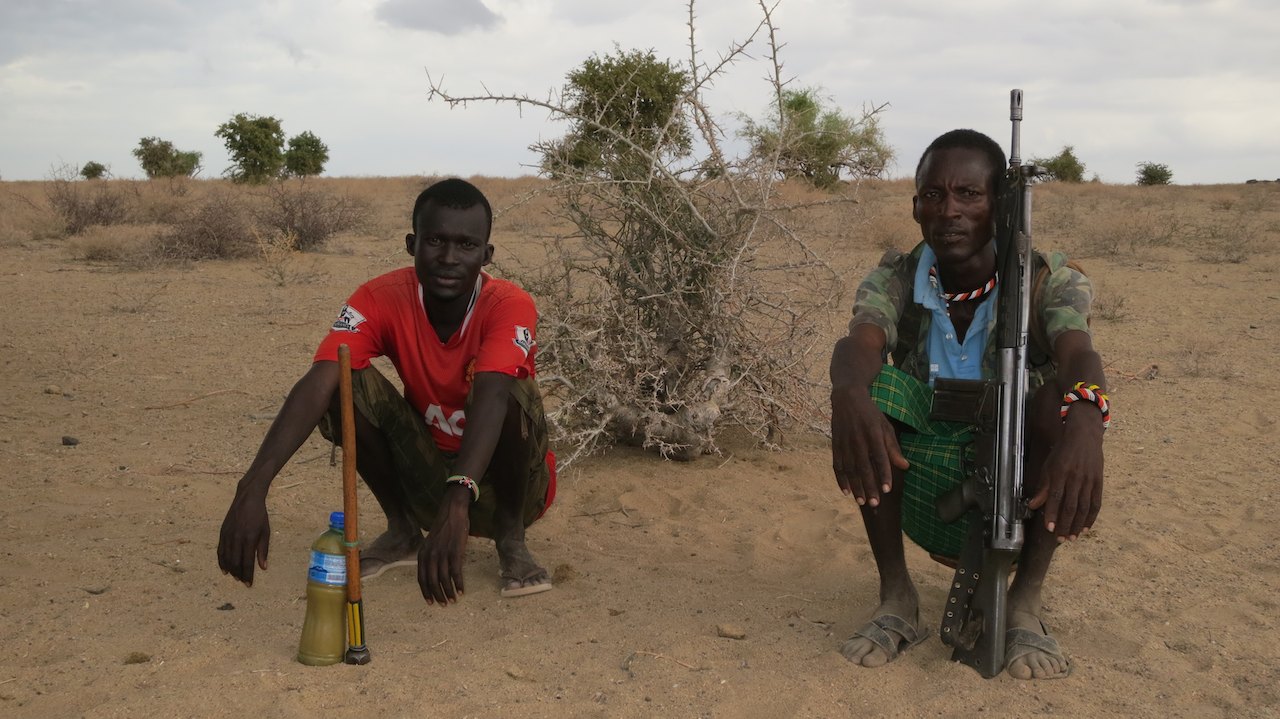
Further south we reach the announced fields with lava stones. Stones as big as tennis balls, and later stones as big as footballs. On part of the route, the path is cleared from the largest stones, but on other parts we need to go across the stones. Very difficult, especially where the road goes down sharply to a dry riverbed to then goes up again steeply. The stones are loose and shoot away from under our wheels. We must pay attention and cannot stop just anywhere. If the stones are large, the holes between them are big too and in between there is no place to put your feet. Keep riding!
That morning we have put some air in the tires again to prevent a flat tire when hitting the sharp rocks. Although we try to avoid the biggest rocks, we sometimes bounce over them quit hard. We stop several times to check the tires. The bikes are doing great, even the steep slopes are no problem. Again we talk to each other about how happy we are that we are traveling on these light Hondas.
We are on our way to Loyangalani and along the way we pass a sign that says “107.5 km”. We do not drive fast and can only go 15km per hours in some parts. Taking into account much needed breaks and the slow speed, it will take at least four to five hours before we will be in Loyangalani. But it is still early, so who knows, we may just make it. A campsite with a shower and a drink would be fantastic.
The motorbikes bounce over the stones and our arms vibrate. It is very tiring and after a while I start to feel it in my arms and my back. On parts where we can stand still, we stop frequently to rest, to shake our arms and to have a drink. We stop for a mid-morning coffee break, and not long after that again for lunch. I empty my Camelbak twice. And in the difficult moments when we are panting, Margiet comes with a tray of candy. What a treat!
The closer we get to the lake, the more sandy roads and dry riverbeds we encounter. The heat and fatigue begin to take their toll. At the end of the afternoon we must stop more regularly to catch our breath and drink. Especially in the areas with deep sand, when my motorcycle swerves in all directions, it is really tough. Out of breath, I put my feet on the ground to stretch out on my tank bag panting. At one point, when Peter is out of reach of the intercom, Jan has overtaken me, and I can only see deep sand, I want to give up. I ask Pim to stay behind me, so he can help if I fall and I then plow on through the deep sand towards Peter. The fear of falling sometimes paralyzes me and makes me brake where I should accelerate. Strange if you consider that up until that time I did not fall on the ground even once.
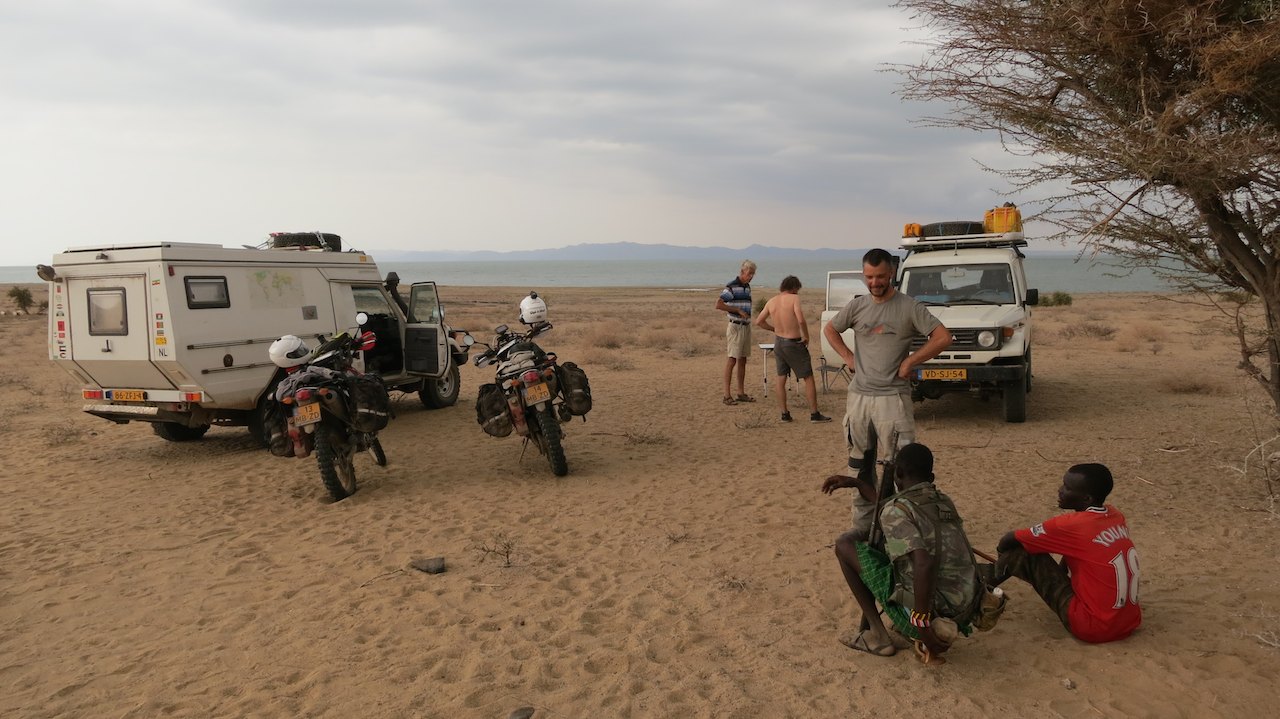
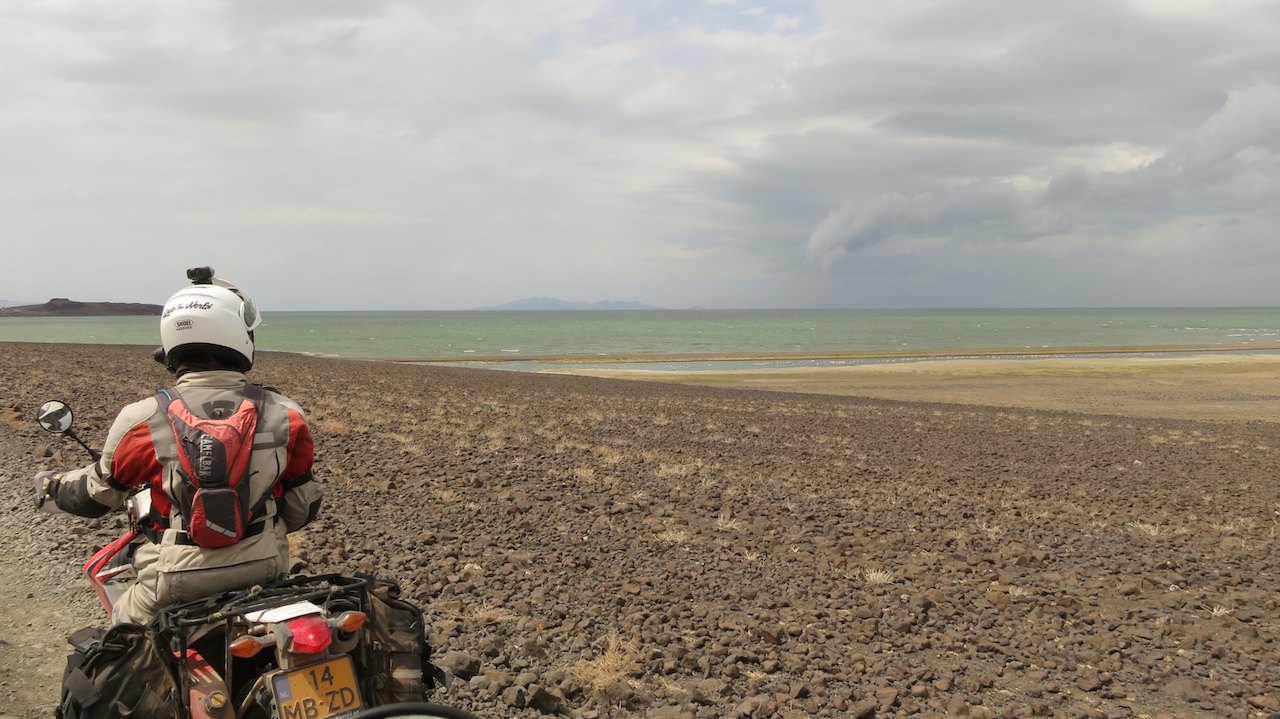
Once with Peter, Jan and Margriet -who were waiting for us on a hill- we let out some more air from the tires to make the ride through the sand easier. We just have to be careful of the stones that are still sticking out of the sand, because with the soft tires the chance of a puncture are larger. We drive to the lake through the deep sand. On my bike, I see that it is only 15km to Loyangalani. I really want to go there, not only to drink a cold Coke myself, but also so to allow the others to have a shower and a cold drink. But I can not. Every 100 meters my bike swerves over the dirt track and I can only just keep it upright. I am dead tired and need to stop. A difficult decision as it is clear that the others, including Peter, could have continued for another 15km.
We find a flat piece of sand overlooking the lake. It is still light and while Peter puts up the tent, I start cooking. Again pasta with tomatoes, onions, garlic and spicy herbs. But this time accompanied by a delicious coleslaw salad made by Margriet. It tastes good! Once the cooking equipment is cleaned, we crawl into our tent. No idea what time it is, but it is dark and I am tired.
Our liners and pillows are wet with sweat when we wake up the next morning. It is very hot and had been so all night. We walk to the lake with a towel and some soap to freshen up. First we look for crocodiles or their tracks, because the lake is full of them. The coast seems clear. We wash ourselves and then trudge back to the tent. Next to our tent are two Turkana watching those crazy five ’mzungus’. One of them speaks good English. We talk about our trip, their village and the weapons they carry. In this area there are fights between different tribes regularly, but the men assure us that the weapons are just to protect them against wild animals like hyenas. The men want a ride and can come with Pim to Loyangalani.
We get back on the road for the last 15km to Loyangalani, through deep sand and crossing several dry riverbeds. We drive on a vast plain whit small gullies that run from the hills to the lake. The gullies are dry now, but the sides have recently been carved out by the water and are very straight. With the bikes this is fine, but for the cars this is more difficult. They hit the ground with the back of their car each time they want to drive out of the gullies again. We take our time to take some pictures and make some movies.
After 15km there is still no trace of Loyangalani. A glance at the map shows us that we still have to travel at least 50km before we get there. As we drive on, more and more stones are on the path. We slowly ride into the hills with lava stones. From the hills we have a great view over the lake. The lake has a beautiful jade green color and contrasts beautiful against the threatening dark sky. We stop frequently, especially to take pictures. By lunchtime we arrive in Loyangalani. A small village, but after being in the middle of nowhere for what felt like eternity, it comes across as a busy city.
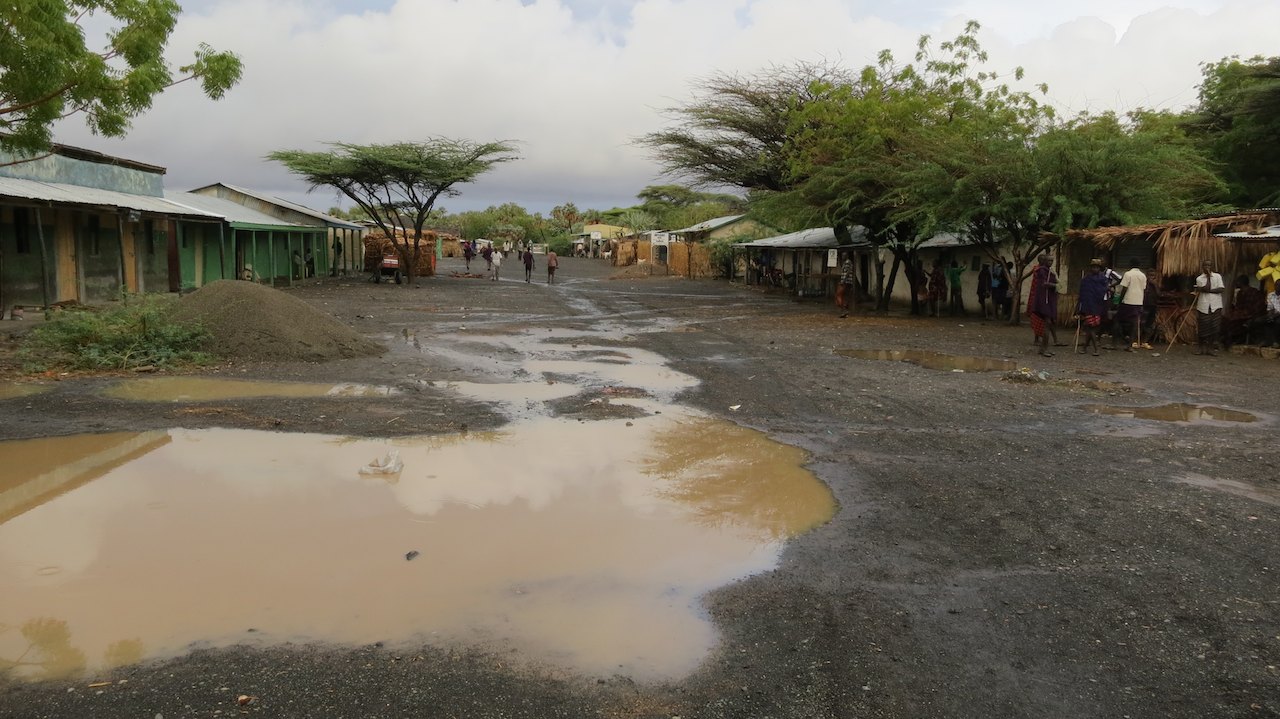
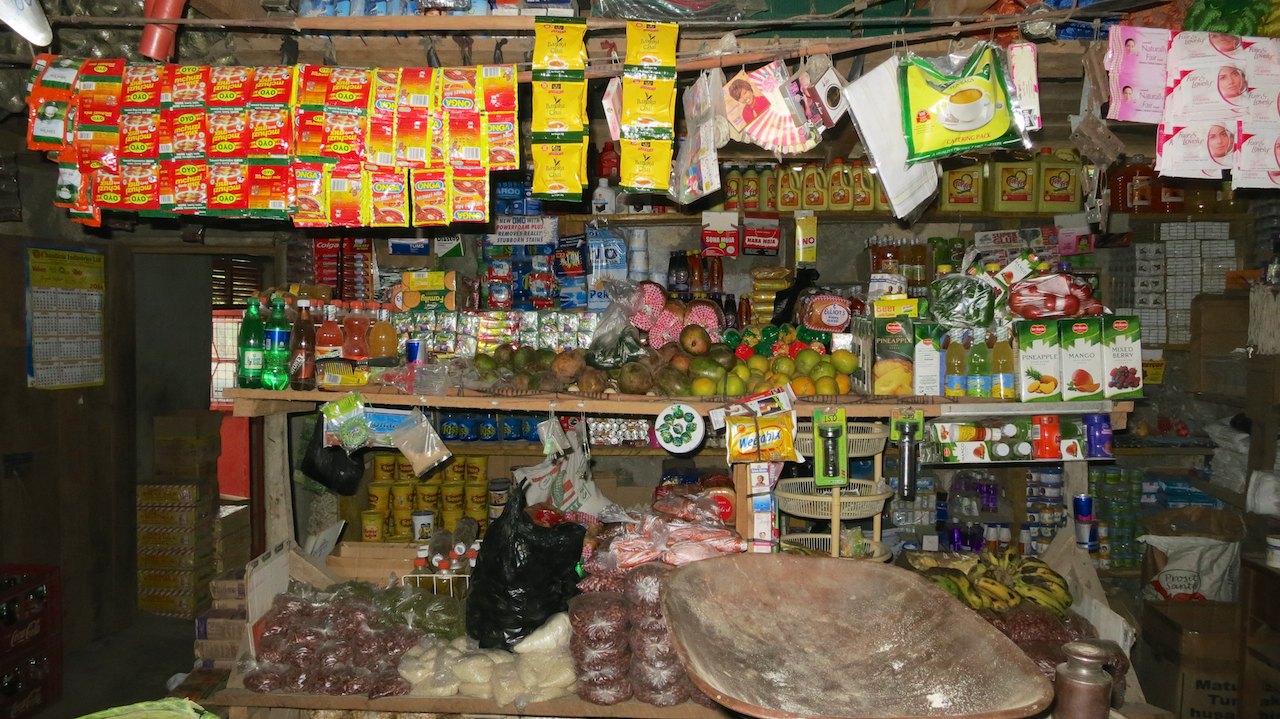
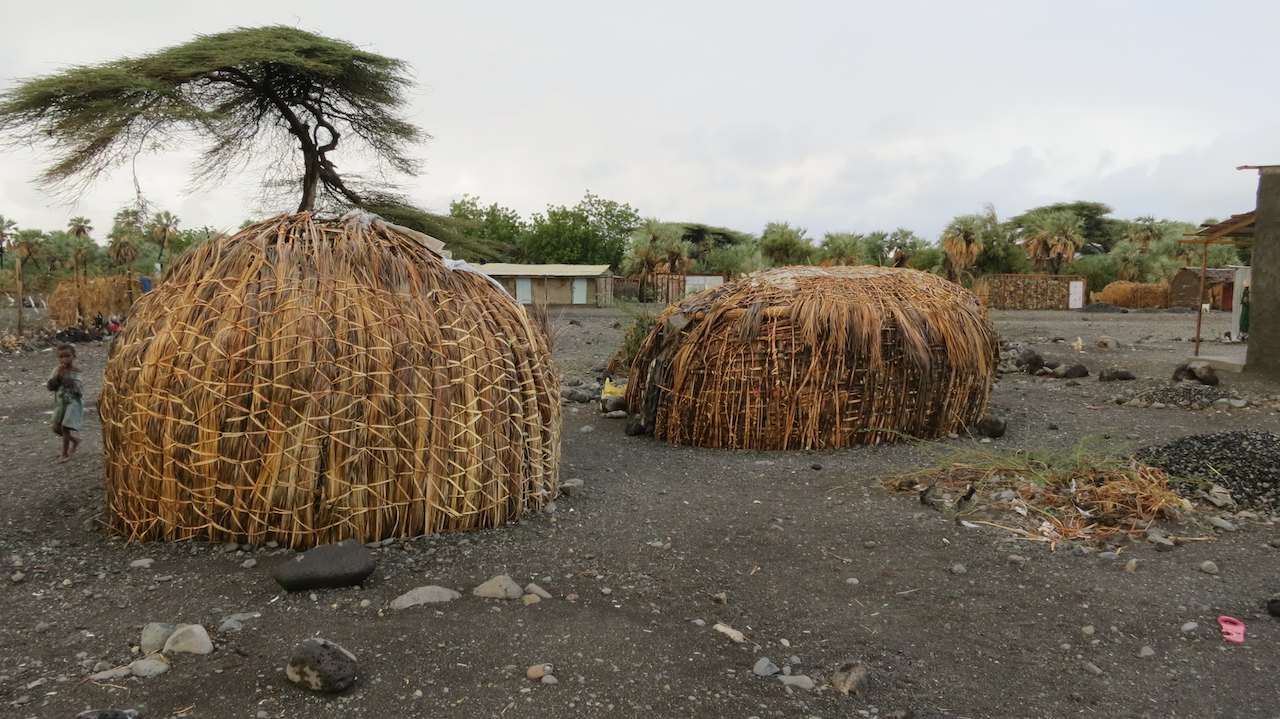
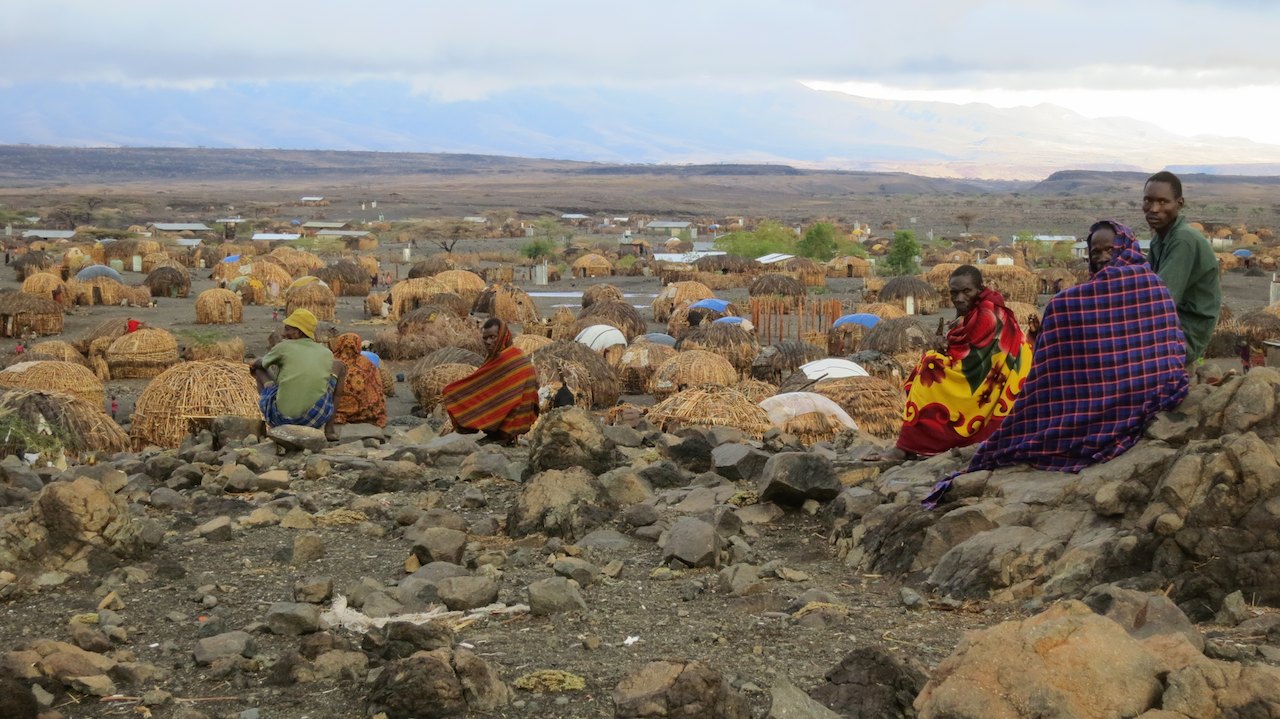
We find a spot on Palm Shade Camp, which has a toilet and a shower which even has water! What a luxury! Just as we want to set up the tent, it starts to rain very hard. The green grass turns into a little swamp. When it is dry, I leave to the village with Pim to do some shopping, while Peter is engaged in the tent. In the street are a dozen small shops where you can get everything you want. In the local grocery store they have lots of things; from matches to floss and from rat poison to spears. And we are lucky because a truck with new stock has just arrived, so we can buy fresh fruit and bread. But we do not cook that night, because we enjoy a delicious three-course meal that is prepared by the cook at the campsite. Soup, curry with rice, fruit and even a cold  ! What a feast.
With new energy we get back on the bikes the next morning. Again we have to wait and see what the rain has done to the road. The manager of the camp site advises us to come back to the campsite when we come across a flowing river and to not cross it. This is to prevent that we get stuck between two rivers. He gives us his phone number and presses us hard to call him in case we encounter any problems along the way. We drive out of the village. As far as the eye can see, we see fields with loose lava rocks. There seems to be a sort of trail over the stones where other cars and trucks have driven. But you cannot call it a ’road’, even though a nice yellow line is drawn on our map.
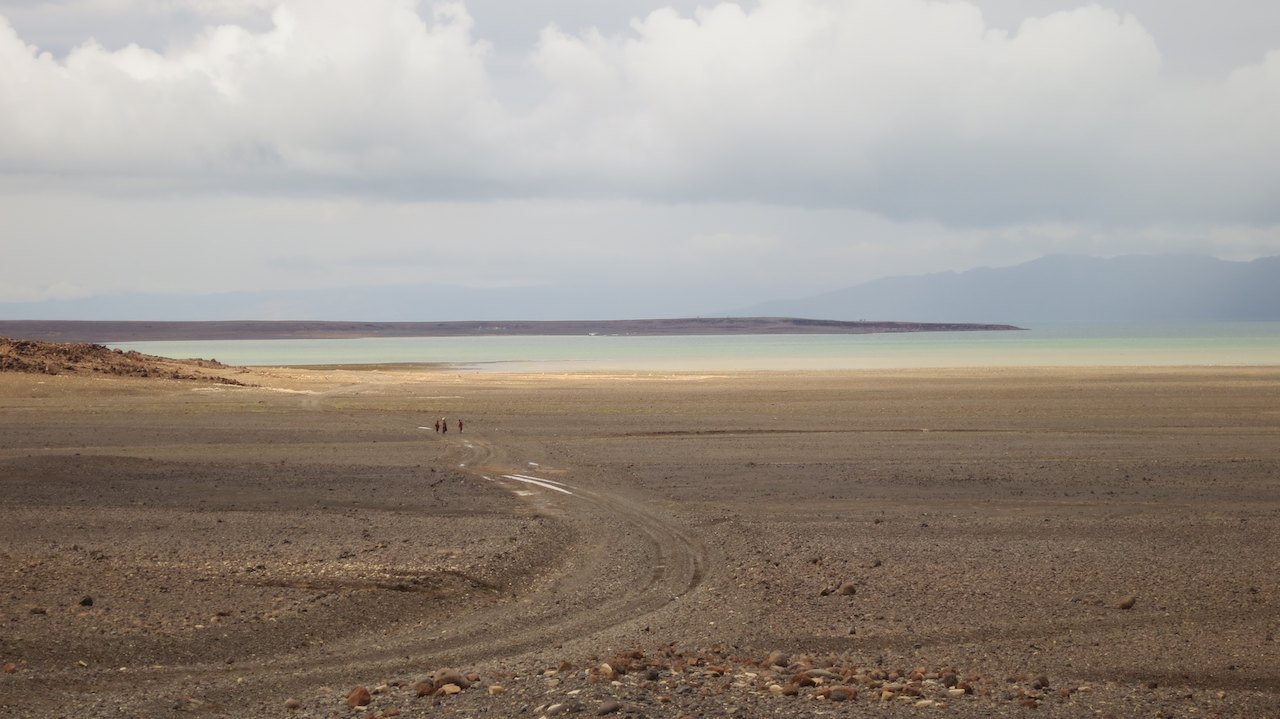

In the beginning we drive on a flat area with stunning views over the lake. After that we slowly drive into the hills and that is were the trouble begins. The stones are loose and very slippery as a result of the rain. They shoot away under our wheels. As during the previous days, we can not just stop anywhere and we must be very focused on the steep sections to manoeuvre the motorbike over the stones. At some point, I suddenly lie on the ground with my bike next to me. The rear tire had skidded on some loose stones. It did not hurt and the bike was still working, but I did have to find some new energy to get on the bike again.
There are huge trenches in the road in places where the water came from the mountains, flowing into the lake. On the way down, the water carried stones and left deep holes in the ‘road’. Like us, the cars have a hard time on this piece. Several times Jan and Pim have to get out of the car to explore the road before they can drive on. Three times Peter rides both our bikes through a difficult piece, once even by walking alongside the bike. While I am at the top of a long slope gathering courage to drive down, I hear cursing over the intercom and I see Peter bouncing off his motorcycle. Luckily he is OK, just a bruised elbow, a bent brake leaver and a torn strap on one of the bags. Over the intercom I hear him say: “ Stay up there, I will ride your bike down.” Hero! He comes up and drives my bikes down without any problems (slightly slower than the first time though).
We are not even 10km out of Loyangalani, but are both already very tired. It takes a few miles before we finally leave this rotten piece behind us and drive away from the lake into the hills. It is steep and in some parts the corners are made of concrete, which makes it a lot easier to ride up. At the other side of the hills, we ride onto a sandy dirt road. Not like the deep white sand we had before, but dark brown or even red sand that has become really hard from the rain. The average speed goes up and even though it starts raining hard at some point, this is going great. We can relax a bit and let the difficult miles of that morning behind us. For the first time I can even look around are enjoy the scenery. Though I still only see animals after Peter has clearly says; “At your 11 o’clock: two deer.”
We drive on the dirt road until we arrive in South Horr in the afternoon, a little earlier than expected. South Horr is a Samburu village along a wide river where we find a spot on a beautiful campsite. Once the tent has been pitched and our gear is hanging on a line to dry, we walk around the village, look at the Samburu huts and trudge through the now dry riverbed. At the end of the afternoon, we move the chairs together, Jan and Margriet take out snacks and we experience the exciting moments of the morning again.
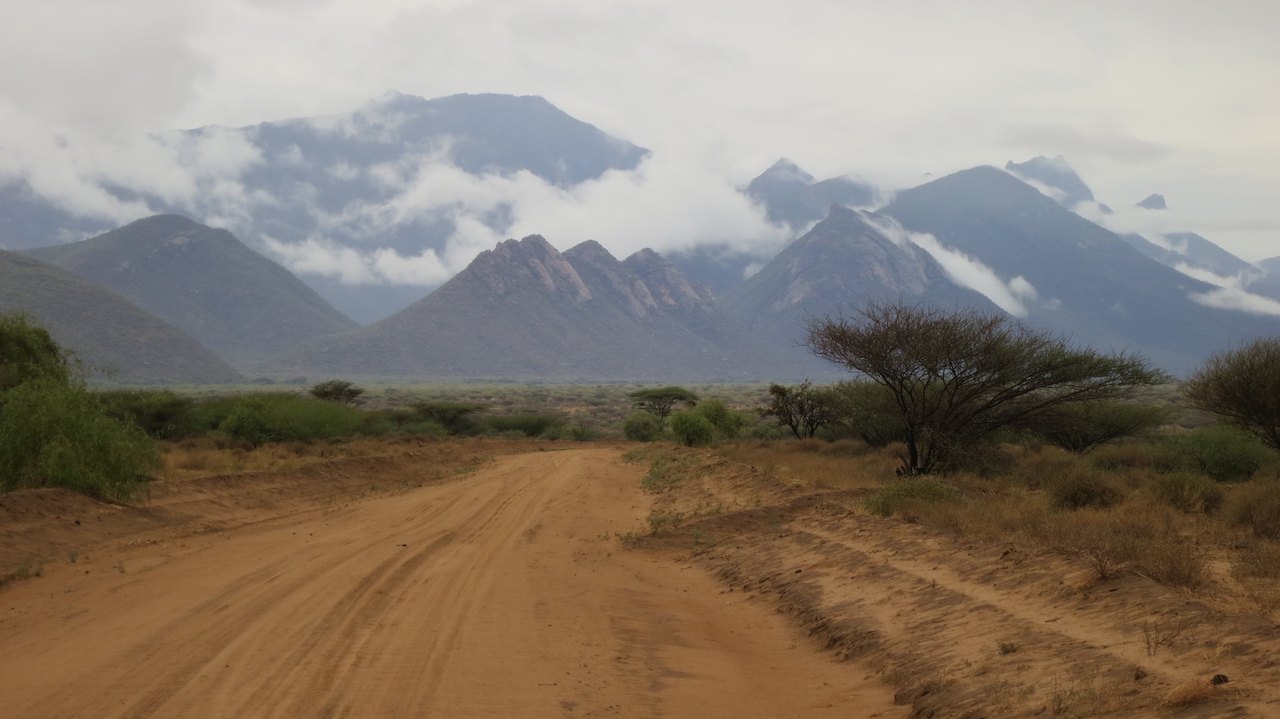
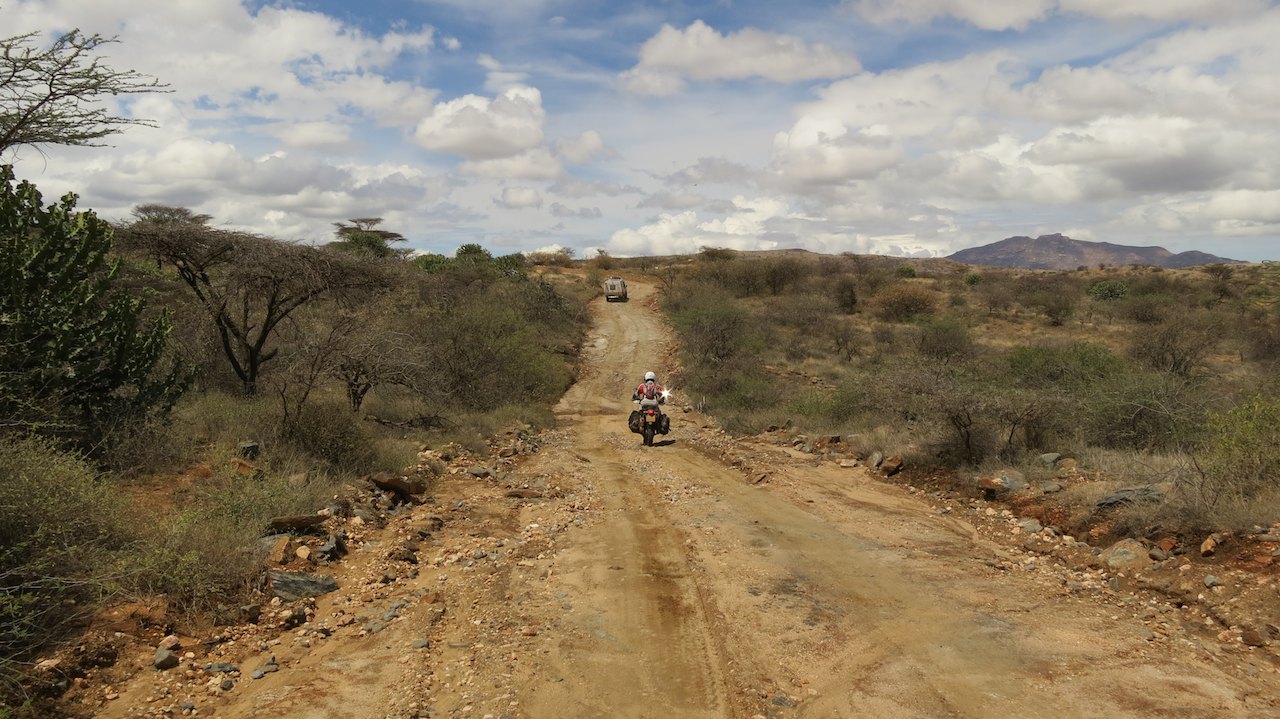
The next morning we continue our way on the hard sandy paths from South Horr to Baragoi. We leave the hills and ride onto a huge savannah. It is beautiful, just like you would know Africa from the BBC documentaries. An area where you would expect giraffes or elephants at any moment. Incredibly beautiful! We take our time to take pictures, to drink coffee and to have lunch. A few hours later we arrive In Baragoi, we do some shopping and then drive on towards Maralal. We find a spot on the Yare Camel Camp. It is our last night as “Dutch Turkana Team”. Jan and Margriet have to go home unexpectedly and will from here take the shortest route to Nairobi from Maralal. We exchange contact details, pictures and films, and wave them goodbye the next morning. Together with Pim we prepare ourselves for the last part of the route, from Maralal to Lake Baringo.
Although we expected that the offroad bit would be over after Maralal, this was not true. We follow a poorly maintained dirt road full of potholes through small villages where not tourists have been for a long time. We drive along a National Park and see our first zebras! Just before Lake Baringo we turn right onto a sandy track. The road is wide at first, but becomes more and more narrow as we continue. The rain has left deep trenches, deep enough to make your motorbike disappear. And as often, the last bit is the hardest. The final (long) kilometres towards the lake are on a ‘road’ through the hills with loose rocks, deep holes and steep sides. Only at the end of the day we see the first glimpse of Lake Baringo on the horizon. Once in the valley, my heart jumps when we finally ride onto an asphalt road in Loruk!
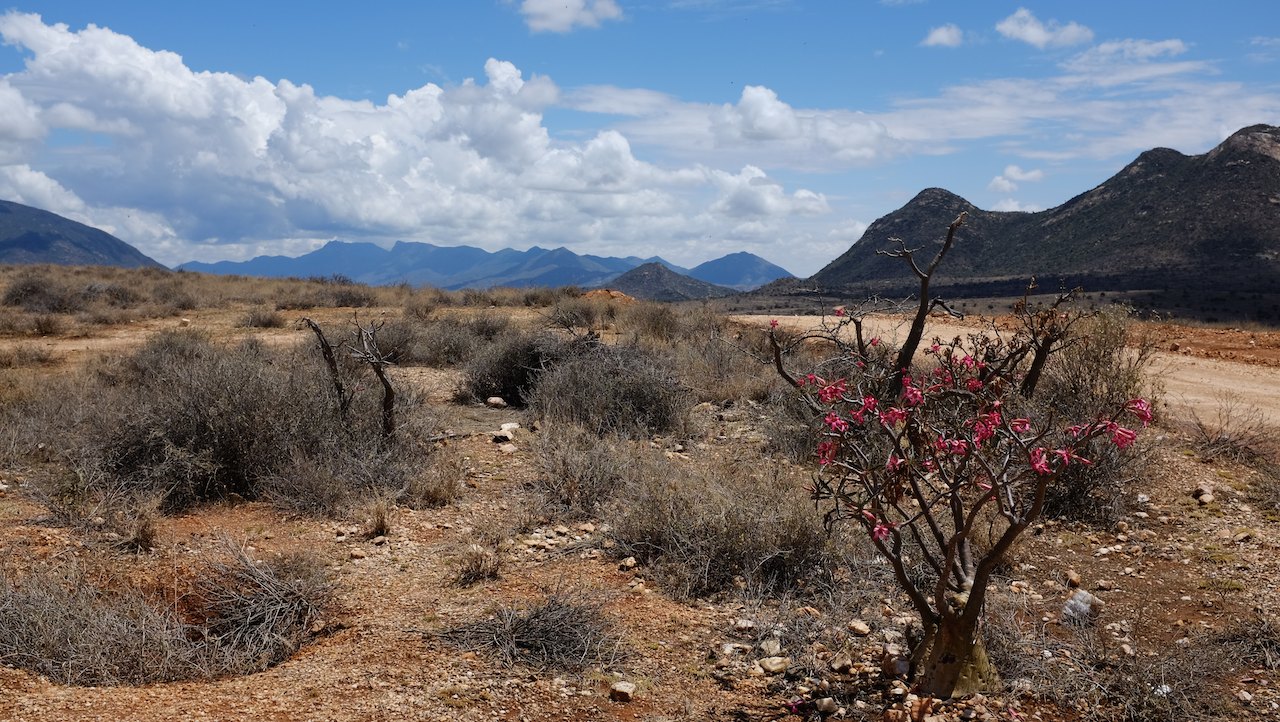

From Woyto in Ethiopia we have then driven 956km offroad. Nearly 1,000 km through a beautiful area, with special people and spectacular scenery. A route that sometimes drove me to despair, but of which I am very happy (and proud) that we took it. The preparations we had made were good, but maybe a bit too much in hindsight. Although there was no fuel station for a long time, we could have obtained fuel anywhere. The same goes for food and water. Perhaps they did not have chocolate paste or snickers, but definitely enough food to finish the route well-fed.
This being said, we were very glad we had extra fuel, water and food with us and had found a companion who was willing to take all this for us. But above all we were happy with the moral support and the company of Jan, Margriet and Pim. Thanks again, also for the liquorice!
Distance travelled to Lake Baringo: 13,590km (8,444miles)
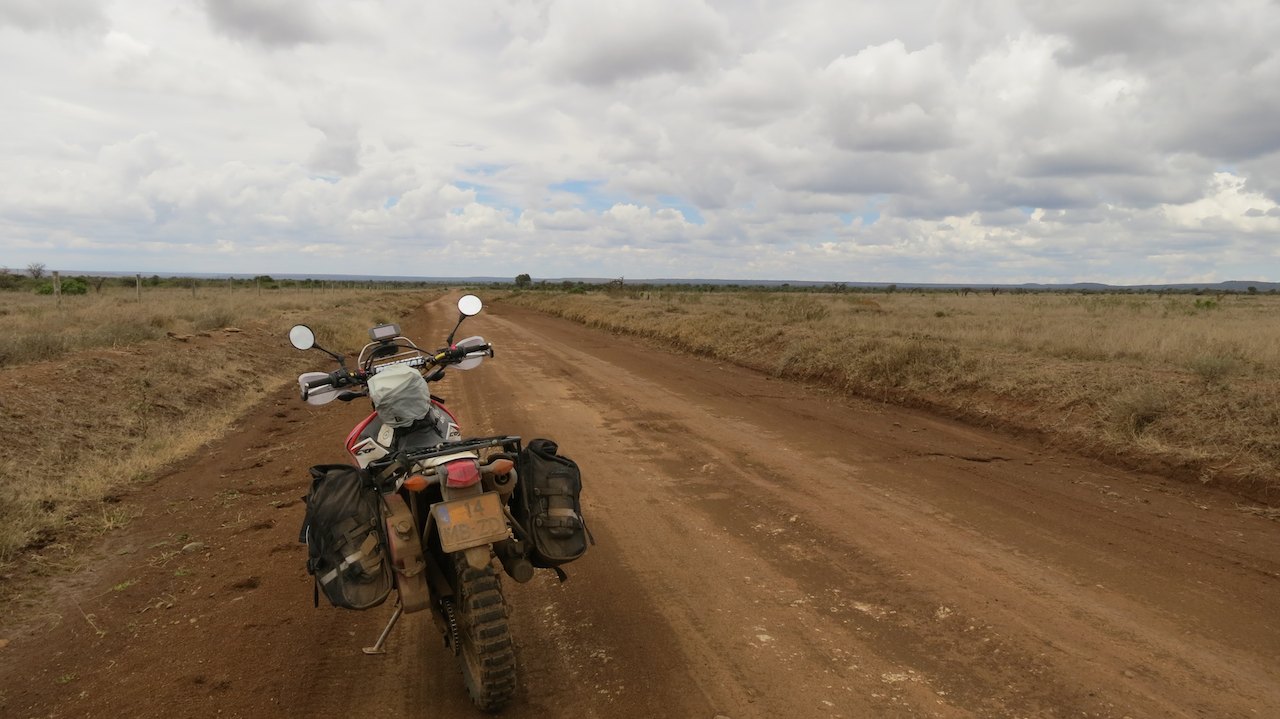
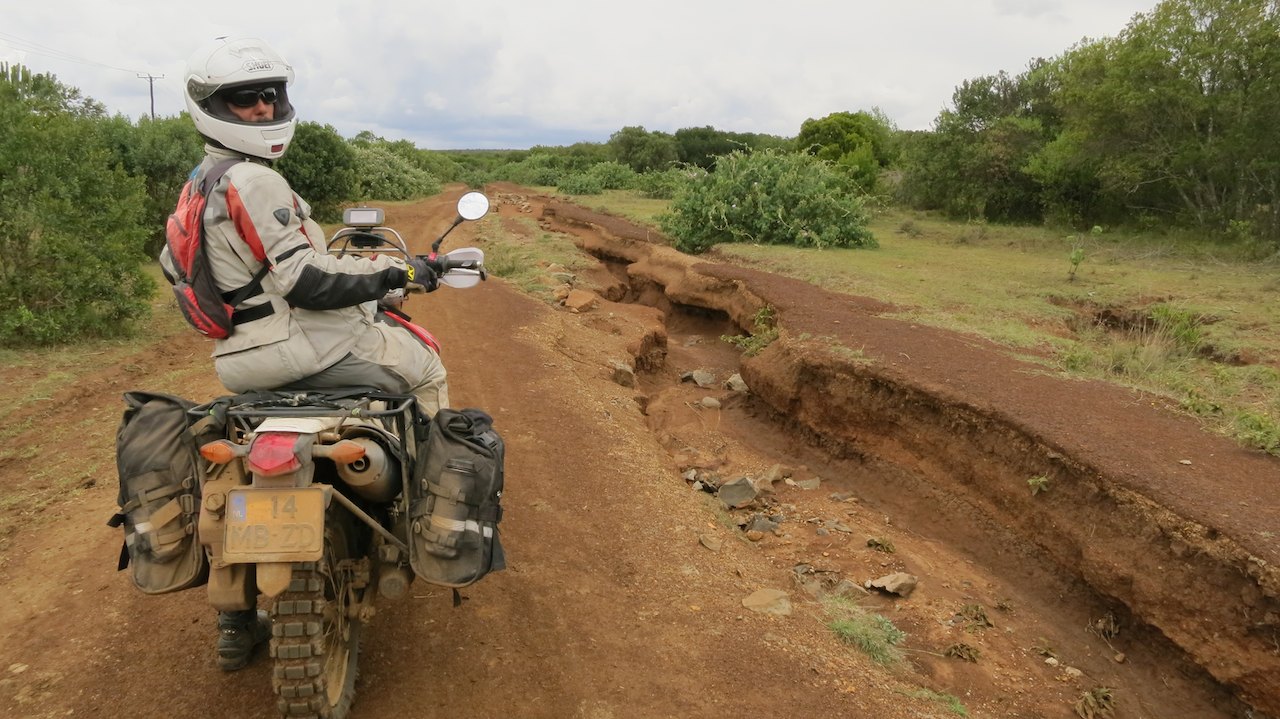
|
|
Currently Active Users Viewing This Thread: 1 (0 Registered Users and/or Members and 1 guests)
|
|
|
 Posting Rules
Posting Rules
|
You may not post new threads
You may not post replies
You may not post attachments
You may not edit your posts
HTML code is Off
|
|
|
|
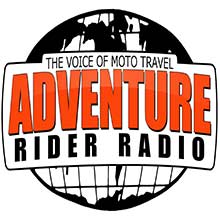
Check the RAW segments; Grant, your HU host is on every month!
Episodes below to listen to while you, err, pretend to do something or other...
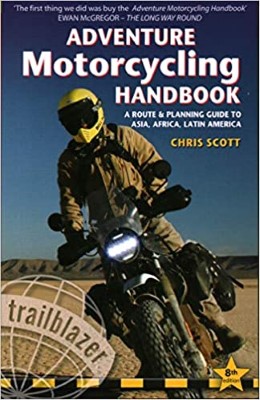
2020 Edition of Chris Scott's Adventure Motorcycling Handbook.
"Ultimate global guide for red-blooded bikers planning overseas exploration. Covers choice & preparation of best bike, shipping overseas, baggage design, riding techniques, travel health, visas, documentation, safety and useful addresses." Recommended. (Grant)

Led by special operations veterans, Stanford Medicine affiliated physicians, paramedics and other travel experts, Ripcord is perfect for adventure seekers, climbers, skiers, sports enthusiasts, hunters, international travelers, humanitarian efforts, expeditions and more.
Ripcord Rescue Travel Insurance™ combines into a single integrated program the best evacuation and rescue with the premier travel insurance coverages designed for adventurers and travel is covered on motorcycles of all sizes.
(ONLY US RESIDENTS and currently has a limit of 60 days.)
Ripcord Evacuation Insurance is available for ALL nationalities.
What others say about HU...
"This site is the BIBLE for international bike travelers." Greg, Australia
"Thank you! The web site, The travels, The insight, The inspiration, Everything, just thanks." Colin, UK
"My friend and I are planning a trip from Singapore to England... We found (the HU) site invaluable as an aid to planning and have based a lot of our purchases (bikes, riding gear, etc.) on what we have learned from this site." Phil, Australia
"I for one always had an adventurous spirit, but you and Susan lit the fire for my trip and I'll be forever grateful for what you two do to inspire others to just do it." Brent, USA
"Your website is a mecca of valuable information and the (video) series is informative, entertaining, and inspiring!" Jennifer, Canada
"Your worldwide organisation and events are the Go To places to for all serious touring and aspiring touring bikers." Trevor, South Africa
"This is the answer to all my questions." Haydn, Australia
"Keep going the excellent work you are doing for Horizons Unlimited - I love it!" Thomas, Germany
Lots more comments here!

Every book a diary
Every chapter a day
Every day a journey
Refreshingly honest and compelling tales: the hights and lows of a life on the road. Solo, unsupported, budget journeys of discovery.
Authentic, engaging and evocative travel memoirs, overland, around the world and through life.
All 8 books available from the author or as eBooks and audio books
Back Road Map Books and Backroad GPS Maps for all of Canada - a must have!
New to Horizons Unlimited?
New to motorcycle travelling? New to the HU site? Confused? Too many options? It's really very simple - just 4 easy steps!
Horizons Unlimited was founded in 1997 by Grant and Susan Johnson following their journey around the world on a BMW R80G/S.
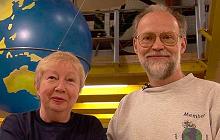 Read more about Grant & Susan's story
Read more about Grant & Susan's story
Membership - help keep us going!
Horizons Unlimited is not a big multi-national company, just two people who love motorcycle travel and have grown what started as a hobby in 1997 into a full time job (usually 8-10 hours per day and 7 days a week) and a labour of love. To keep it going and a roof over our heads, we run events all over the world with the help of volunteers; we sell inspirational and informative DVDs; we have a few selected advertisers; and we make a small amount from memberships.
You don't have to be a Member to come to an HU meeting, access the website, or ask questions on the HUBB. What you get for your membership contribution is our sincere gratitude, good karma and knowing that you're helping to keep the motorcycle travel dream alive. Contributing Members and Gold Members do get additional features on the HUBB. Here's a list of all the Member benefits on the HUBB.
|
|
|





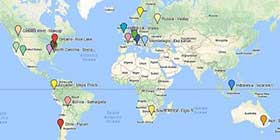









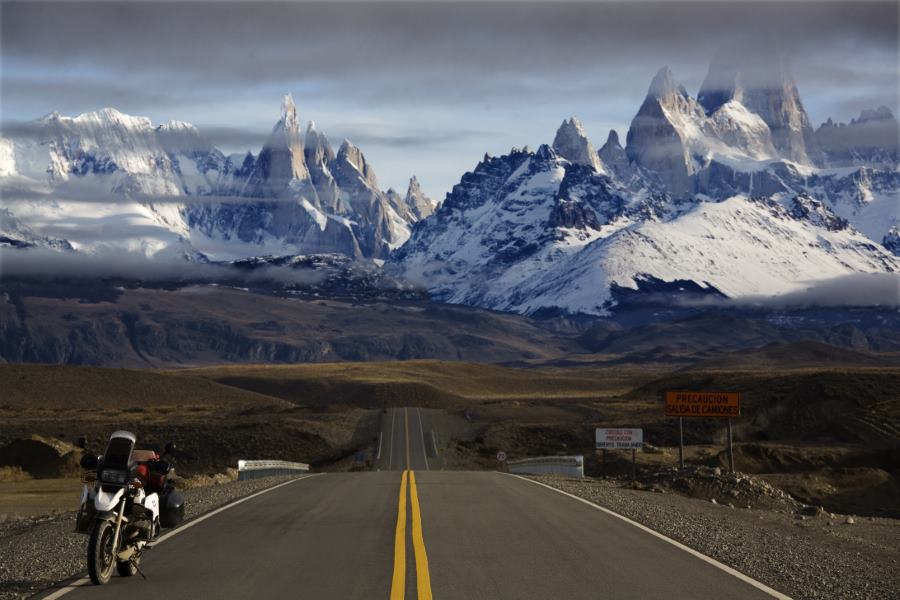

 27Likes
27Likes


















 s in a long time and the delicious food cooked by Kim. Lake Tana also appears to be a birding paradise. We sit with our binoculars at the lake or under the big tree next to our tent watching the most beautiful birds for hours. We see Paradise Fly Catchers, Blue Cheeked Cordon Blues, Mouse Birds and Firefinches. Truly beautiful. We end up staying four nights to recover from the initial culture shock and to gain new energy to conquer the rest of Ethiopia. A great time!
s in a long time and the delicious food cooked by Kim. Lake Tana also appears to be a birding paradise. We sit with our binoculars at the lake or under the big tree next to our tent watching the most beautiful birds for hours. We see Paradise Fly Catchers, Blue Cheeked Cordon Blues, Mouse Birds and Firefinches. Truly beautiful. We end up staying four nights to recover from the initial culture shock and to gain new energy to conquer the rest of Ethiopia. A great time!





























































































































 Hybrid Mode
Hybrid Mode



